

![]()
![]()
The NYCTA token issues have been well covered in many exonumia journals and urban blogs. However; to the general public, many may not realize the variety of issues that truly exist.
Furthermore, and quite unfortunately; misinformation abounds regarding the "first subway token", (it was the 16.5mm "Small Solid") the sales of so-called "complete sets" of "six" NYCTA tokens in a lucite holder on internet sales sites (and available through the New York City Transit Museum); when in fact there were nine issues: seven Regular Fare and two Special Fare. Add to this, die and font varieties of a few of those varieties; and you have yourself a good 18 tokens to aim for to acquire a basic, yet "true" complete set of tokens for the NYCTA.
But, we are not done! One must consider the predecessor issues used prior to NYCTA issued tokens, which were issued by the Board of Transportation - New York City Transit System. These not so quite as recognized.
Next, but not certainly last; nor to be overlooked; are the individual private companies that operated streetcar and bus services in the 5 boroughs. These include, but not limited to; the very popular Interborough Rapid Transit token that was never circulated.
Then, you have some of the earliest horse drawn stage car tokens from the 1800's made of pewter, and Vulcanite - a hardened rubber also known as ebonite. Yes, hard rubber tokens. These older 19th Century token issues fetch hundreds and even thousands of dollars. They may be out of reach for the casual collector, but they do come up for sale from time to time and are a very integral part of the history of New York City Transportation Tokens.
Another facet of the tokens that is to be considered are the errors. In some cases, they also command a stout price as they are in demand. An exception to this being the NYCTA "Y cutout" token in both large and small varieties (more so for the large). It appears strike errors of the "Y" punch being not "clocked" properly with the words on the token are rather easy to procure. Naturally the more dramatic of these misalignments are more desirable than the lightly misaligned types. The most desirable tokens are where the Y punch is way off center and extends past the rim of the token.
For some, collecting New York City transit tokens can be a daunting and expensive hobby, for others it is an obsession!
.
If you have your heart set on trying to acquire the varieties as some of us do, I highly recommend and suggest, nay; INSIST; that you join the American Vecturist Association, and purchase Volumes 1 (Catalog), 2 (History) and 3 (Varieties) of the Seventh Edition of the Atwood-Coffee Catalog. But, you can purchase the catalogs without joining.
The Atwood-Coffee is an indispensable guide to collecting tokens. Did I say indispensable? I should say absolutely necessary. As a convenience, I am providing the link to the American Vecturist Association.
The tokens listed below are accompanied with their corresponding Atwood-Coffee catalog number for the New York State chapter: NY630A. For the most part, the tokens are listed here below in alpha-numerical order, as listed in the catalog, with some minor corrections and reorganization to allow for chronological order and continuity.![]()
Possibly the least known and least observed of the New York City transit tokens. They are without a doubt, historical. We are fortunate to have these available for inclusion here.
The Omnibus, was a rear entry stagecoach drawn by two horses with interior seating for 12 to 14 passengers was introduced to New York in 1827. There were versions for both operation on rails and without.
 image courtesy of A. Pasquet, Untapped Cities |
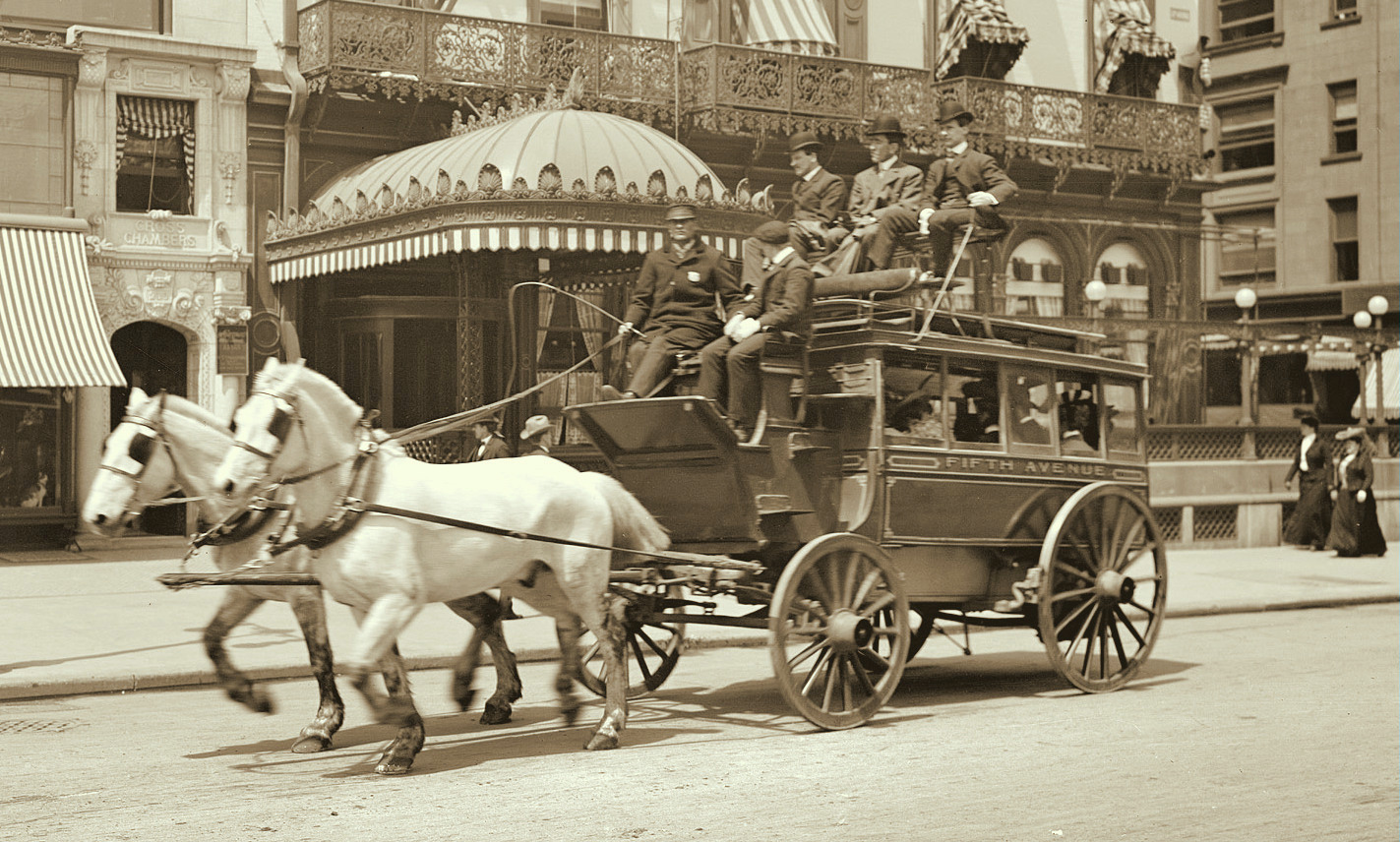 courtesy of Shorpy Historical Photos |
These led to the horsedrawn trolley, which allowing larger capacity of seating, with better riding qualities, and platforms and steps on the ends for easier entrance and egress :

courtesy of the New York Public Library Digital Archives
.
By 1849 there were 425 vehicles operating on 25 franchise routes. By 1851, there were 608 vehicles in operation. All but one route converged on Broadway south of Canal Street towards South Ferry. Only ten of these routes issued tokens. These figures apply only to Manhattan and the other boroughs has similar systems as well.
 |
||
| . . |
||
| Nassau Railroad Organized
in 1865 it would operate three horse car lines in Brooklyn, with parts
reaching into Queens. It would merge in 1868 to form the Brooklyn City,
Hunters Point and Prospect Park Railroad.
|
||
|
|
|
21mm, brown Vulcanite, solid Atwood-Coffee NY629A extremely rare; $500.00 to $700.00 |
|
|
||
| Brooklyn Cross Town Railroad This company was formerly known as the Brooklyn City, Hunter's Point & Prospect Park Railroad until September 30, 1872.
|
||
|
|
|
23mm, copper nickel, solid Atwood-Coffee NY629B extremely rare; $250.00 to $500.00 |
|
|
||
|
|
|
15/16", brass, solid Atwood-Coffee NY629 not listed extremely rare; $500.00 to $750.00 |
|
|
||
| Brooklyn City Railroad
This zone check is believed to have been used as a payment
receipt for the extra fare collected on the line extending down
Brooklyn's Third Avenue to Fort Hamilton.
An extra fare was paid at the Brooklyn city line (in 1870s). |
||
|
|
|
Zone Check 31mm, black Vulcanite, solid Atwood-Coffee NY997A extremely rare; $500.00 to $750.00 |
|
|
||
 |
||
|
Third Avenue Railroad
In 1855, the Third Avenue Rail Road extended service up to Harlem.
Although the service was in operation, the rails were not yet laid the
full distance, so a horse car was used on the southern parts and an
omnibus on the northern reaches of the line. The tokens show an omnibus
or rail car with Yorkville or Harlem destinations for a total of four
varieties. George H. Lovett was the die engraver, and an "L" on each
obverse is at ground level, he may have also struck these token. The
scarcer varieties are the omnibus with the Yorkville destination and
the horse car with the Harlem destination. The cash fare for the full
distance was 15 cents unless the tokens were purchased ahead of time. |
||
|
|
|
Harlem 27mm, pewter, solid Atwood-Coffee NY630M rare; $500.00 to $750.00 for better grade |
|
|
||
|
|
|
Yorkville 27mm, pewter, solid Atwood-Coffee NY630N rare; $500.00 to $750.00 for better grade |
|
|
||
|
|
|
Harlem 27mm, pewter, solid Atwood-Coffee NY630O extremely rare; $600.00 to $850.00 for better grade |
|
|
||
|
|
|
Yorkville 27mm, pewter, solid Atwood-Coffee NY630P rare; $300.00 to $500.00 for better grades |
|
|
||
|
|
|
To Cable Line 23mm, copper nickel, solid Atwood-Coffee NY630Q The first Cable Line in NYC opened in 1885 and operated crosstown on 125th Street and Amsterdam Avenue. In 1893-94 the Third Avenue Railroad it's main route from Park Row up Third Avenue to 129th Street to cable operations. This token dates 1885-1894. uncommon, but the second most common of the 19th Century tokens $50.00 to $75.00 |
|
|
||
| 4th Avenue Line - Haskins & Wilkins Haskins & Wilkins operated the 4th Avenue Line. Two routes with thirty-five two-horse stages.
|
||
|
|
|
27mm, pewter, pierced Atwood-Coffee NY630E extremely rare; $1000.00 to $1250.00 |
|
|
||
| 5th and 7th Avenue Lines - Marshalls & Townsend Marshalls
& Townsend operated the 5th and 7th Avenue Lines. They
operated forty-six two-horse stages. Soon
after
ordering the tokens, they sold the franchise for the 5th Avenue route,
so some have the 5th & lettering scratched off from the struck
token. A later order of tokens had the "5th &" removed in die. So,
the A-C listing is reversed chronologically, but show properly here
|
||
|
|
|
5th and 7th Avenue Lines 27mm, pewter, pierced Atwood-Coffee NY630F extremely rare; $1000.00 to $1250.00 |
|
|
||
|
|
|
7th Avenue Lines ("5th &" scratched off token) 27mm, pewter, pierced Atwood-Coffee NY630H very rare; $400.00 to $600.00 |
|
|
||
|
|
|
7th Avenue Lines ("5th &" removed from die) 27mm, pewter, pierced Atwood-Coffee NY630G very rare; $400.00 to $600.00 |
|
|
||
| 6th Avenue Lines - Young & Ward Young
& Ward operated the 6th Avenue Line with forty two-horse stages on
two very similar routes, the cross over on 8th or 9th street being the
only difference.
|
||
|
|
|
27mm, pewter, pierced Atwood-Coffee NY630I very rare; $400.00 to $600.00 |
|
|
||
| 8th Avenue Lines - Finch, Sanderson & Co. Finch,
Sanderson & Co. operated the 8th Avenue Line with fifty-six
two-horse stages. The first order of tokens had both partners listed,
but when Sanderson left the partnership, his name was removed from the
tokens on the existing stock.
|
||
|
|
|
27mm, pewter, pierced Atwood-Coffee NY630J very rare; $400.00 to $600.00 |
|
|
||
|
|
|
("Sanderson" scratched off token) 27mm, pewter, pierced Atwood-Coffee NY630 (unlisted) extremely rare; $750.00 to $1000.00 |
|
|
||
|
Kipp Brown & Co.
Kipp & Brown operated the Chelsea Line. They operated three routes with sixty-two two-horse stages. The franchise, stables, omnibuses and horses sold for $85,000 in 1856. |
||
|
|
|
Chelsea Line 27mm, pewter, pierced Atwood-Coffee NY630K very rare; $250.00 to $400.00 |
|
|
||
|
Telegraph Line - Tyson & Co.
Tyson & Co. operated the Telegraph Line. It was the only east-west route of the token issuing companies. They used eighteen two-horse stages in 1851, increased to thirty in 1852. William Tyson sold out the line in 1856. There are four varieties of tokens: Two each of the lettering near or far from the edge, the near the edge variety has one or two periods under the o in Co. The far from edge variety has a period or no period after Tyson. The brass Tyson tokens as a whole are the commonest, the design with the letters close to the edge are the scarcer varieties. William Tyson was the president of the Omnibus Proprietors' Mutual Association. |
||
|
|
|
28mm, brass, pierced Atwood-Coffee NY630La (letters close to edge, 2 periods: 1 under ọ in company, 1 after) uncommon but not rare; $50.00 to $75.00 |
|
|
||
|
|
|
28mm, brass, pierced Atwood-Coffee NY630Lb (letters close to edge, 3 periods: 2 under ọ in company, 1 after) uncommon but not rare; $75.00 to $100.00 |
|
|
||
|
|
|
28mm, brass, pierced Atwood-Coffee NY630Lc (letters away from edge, 1 period after Tyson, 1 period under ọ in company) uncommon but not rare; $75.00 to $100.00 |
|
|
||
|
|
|
28mm, brass, pierced Atwood-Coffee NY630Ld (letters away from edge, 1 period under ọ in company uncommon but not rare; $75.00 to $100.00 |
|
|
||
| Token collectors please note: The Telegraph Line - Tyson & Co. tokens are the most common of all the 19th Century transit tokens because they were struck in brass and not pewter. There is evidence of fire damage on some of these tokens due to a stable fire, and the pewter variety would have melted; and thus not survived whereas the brass variety would. |
||
|
|
|
Fire damaged |
|
|
||
| 42nd Street, Manhattanville & St. Nicholas Avenue Railway Boulevard was the pre-1890 name for the section of Broadway north of Columbus Circle.
|
||
|
|
|
28mm, copper nickel, solid Atwood-Coffee NY630S extremely rare; $1000.00 to $1250.00 |
|
|
||
|
N-York and Harlaem Railroad Co.
Incorporated in 1831, the first section opened in 1832 with the first being along Bowery from Prince Street to 14th Street. Further extensions included 1833 for service in Fourth Avenue to 32nd street. In 1834 north along Fourth Avenue to Harlem and then in 1837 further north to Harlem. A southern extension was made in 1839 via Bowery, Broom and Centre Streets to City Hall and Park Row. Horse power was used at first for the entire route with steam engines introduced in 1837 for service north of the 27th street depot. After 1870, the horsecar service turned at 42nd Street and continued up Madison Avenue to 86th Street. Steam train service ended at the new Grand Central Terminal. The B&S under the railroad coach is the mark of the maker of the token, Bale & Smith. These issues are believed to be the very first tokens issued for a transportation company in the City of New York. |
||
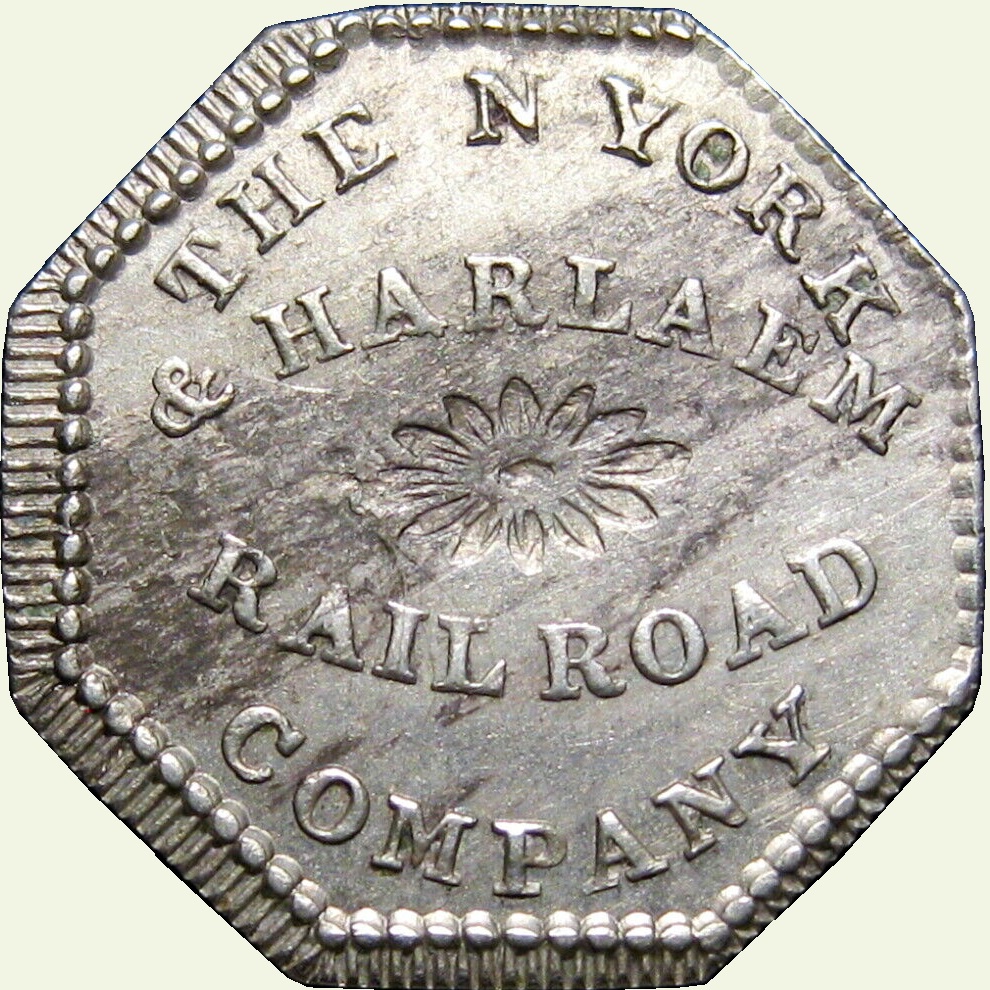 |
same reverse as below |
18mm octagonal, German silver, solid
Atwood-Coffee NY630Da three varieties: a - rosette counterstamp on obverse b - dog counterstamp on obverse
c - without counterstamp
|
|
|
||
|
|
|
18mm octagonal, copper-nickel, solid
Atwood-Coffee NY630Dc three varieties: a - rosette counterstamp on obverse b - dog counterstamp on obverse
c - without counterstamp
|
|
|
||
|
|
|
18mm octagonal, copper, solid
Considered a pattern
Atwood-Coffee NY998a
two varieties: a - without counterstamp b - leaf counterstamp
|
|
|
||
|
|
|
tokens at left are photo rendering 18mm octagonal, lead
Considered a pattern
Atwood-Coffee NY998D
two varieties: a - without counterstamp b - leaf counterstamp |
Expect intense bidding not only from New York topic collectors but broad spectrum token collectors as well.
These New York & Harlaem Railroad tokens crossover in interest to collectors of Hard Times era tokens and NYC collectors in general, expect intense bidding.
Omnibus tokens are "pierced" as drivers presumably carried the tokens on a looped ring of wire for convenience.
The above omnibus tokens were struck as solids by the manufacturer; and the holes were added after delivery.
Unpierced examples do exist and command a 20% premium.
| Surface Transportation Corporation Orchard Beach Turnstiles |
||
|
|
|
1949 23mm, copper nickel Atwood-Coffee NY628A total struck: 30,000: 15,000 June 1949, 15,000 June 1954 S.T.C. = Surface Transportation Corporation fairly common; $7.50 |
|
|
||
|
|
|
1949 16mm, brass Atwood-Coffee NY628B total struck: 10,000 June 1949 uncommon; $15.00 |
|
|
||
| Manhattan And Bronx Surface Transit Operating Authority | ||
|
|
|
1965 23mm, copper nickel Atwood-Coffee NY628C total struck: 12,000: 7,000 July 1965; 5,000 July 1969 M.A.B. = Manhattan And Bronx Surface Transit Operating Authority fairly common; $7.50 |
![]()
.
.
![]()
.
.
.
![]()
.
.
| Overview | The Atwood-Coffee Catalog | |||
|
|
||||
| 19th Century Issues - 1827 to 1900 | ||||
|
|
||||
| 20th Century Issues - 1900 to 1940 | ||||
| Bronx | Brooklyn | Manhattan | Queens | Staten Island |
|
|
||||
| First Unification "NYCTS" - City Wide Issues - 1940-1953 | ||||
|
|
||||
| Second Unification "NYCTA" - City Wide Issues - 1953 - 2003 |
||||
| Why a token? Coins vs. Token | ||||
| July 25, 1953: Will the real first token please stand up.. | July 27, 1953 - Jay Street? We have a problem. | |||
| Not complete sets. And a REAL complete set | ||||
|
|
||||
| Token Dispensers | Rolls & "Ten Paks" | |||
|
|
||||
| Errors | Die Set Up | Patterns | Proofs | Counterfeits & Slugs |
|
|
||||
| Token Manufacturing Processes of NYCTA tokens | ||||
|
|
||||
| Scanning Electron
Microscope / Wavelength Dispersive Spectroscopy testing to determine
composition of the NYCTA 5 Borough - Pentagon Token |
||||
![]()
 |
||
| Richmond Light & Railroad
John J. Kuhn was appointed receiver for three years (1920-1923).
Under his leadership the company was able to raise the fare to eight
cents, and exited from the receivership by splitting up into the Staten
Island Edison Co. and the Richmond Railroad Co.
Token were placed in use when fare was raised to 8 cents cash or two tokens for 15 cents. |
||
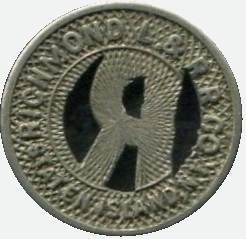 |
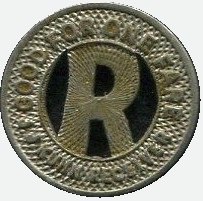 |
date unknown (1902-1927) 16mm, copper nickel, R Atwood-Coffee NY632A uncommon; $25.00 |
.
.
| Overview | The Atwood-Coffee Catalog | |||
|
|
||||
| 19th Century Issues - 1827 to 1900 | ||||
|
|
||||
| 20th Century Issues - 1900 to 1940 | ||||
| Bronx | Brooklyn | Manhattan | Queens | Staten Island |
|
|
||||
| First Unification "NYCTS" - City Wide Issues - 1940-1953 | ||||
|
|
||||
| Second Unification "NYCTA" - City Wide Issues - 1953 - 2003 |
||||
| Why a token? Coins vs. Token | ||||
| July 25, 1953: Will the real first token please stand up.. | July 27, 1953 - Jay Street? We have a problem. | |||
| Not complete sets. And a REAL complete set | ||||
|
|
||||
| Token Dispensers | Rolls & "Ten Paks" | |||
|
|
||||
| Errors | Die Set Up | Patterns | Proofs | Counterfeits & Slugs |
|
|
||||
| Token Manufacturing Processes of NYCTA tokens | ||||
|
|
||||
| Scanning Electron
Microscope / Wavelength Dispersive Spectroscopy testing to determine
composition of the NYCTA 5 Borough - Pentagon Token |
||||
![]()
That being said, the following tokens were used and circulated throughout the city; and therefore do not fall into a particular borough specific category as the tokens in the preceding chapter do.
Before continuing further on this chapter of tokens, there is one token that must be
viewed and discussed.
As of January 2024; at least three examples are confirmed to exist.
It is the proposed
pattern for the New York City Transit System (Board of Transportation)
subway token. What this means, is; the NYCTS contemplated a token
issue, and before the New York City Transit Authority did in 1953.
And, before the Transit Authority commissioned the "Y" tokens we all
know
and have come to love. As stated, three pieces are known and almost certainly more exist. They could be considered by some the "holy grail" for a very limited amount of vecturists and NYC transit collectors alike. Then again, same could be said for many pieces on this page. It is understood that several hundred of these tokens would have been struck, as is normal for die testing and machine calibration of a new design. After the machines are set up, examples are sent to the board or officials of the company or agency who ordered them. They are passed around at a meeting, and discussed. They are kept not only in the manufacturers archives, but the transportation company archives as well. It is like a draft or a proposal. The principals of a company could say, "Yes, start production and make 5,000,000 to start." Or they could say , "Let's hold off, we are in financial straits". Board members take them home, gave them to friends and acquaintances, and theywent into a drawer or coin box and were forgotten about. As time passes, they appear one at a time on the market to be added to the known population. It is believed by a renowned vecturist that several of these made it into private hands. Possibly as many as a dozen.
The desirability of owning this piece is unlike the very early
1800's token issues in the above chapters, of which were released to the public
in substantial numbers, yet few have survived. Here, we know these
tokens were a limited run and not many were produced, but those that
were were distributed to persons who would keep them - company board members. And certainly with
their production being of the modern era, i.e: "more recent" (within the last 75 years as
opposed to 150 or 200 years for the 1800's tokens), the survivability of "modern" era tokens
is somewhat more guaranteed. Being a pattern
piece; the token only appeals to very small subset of token collectors. 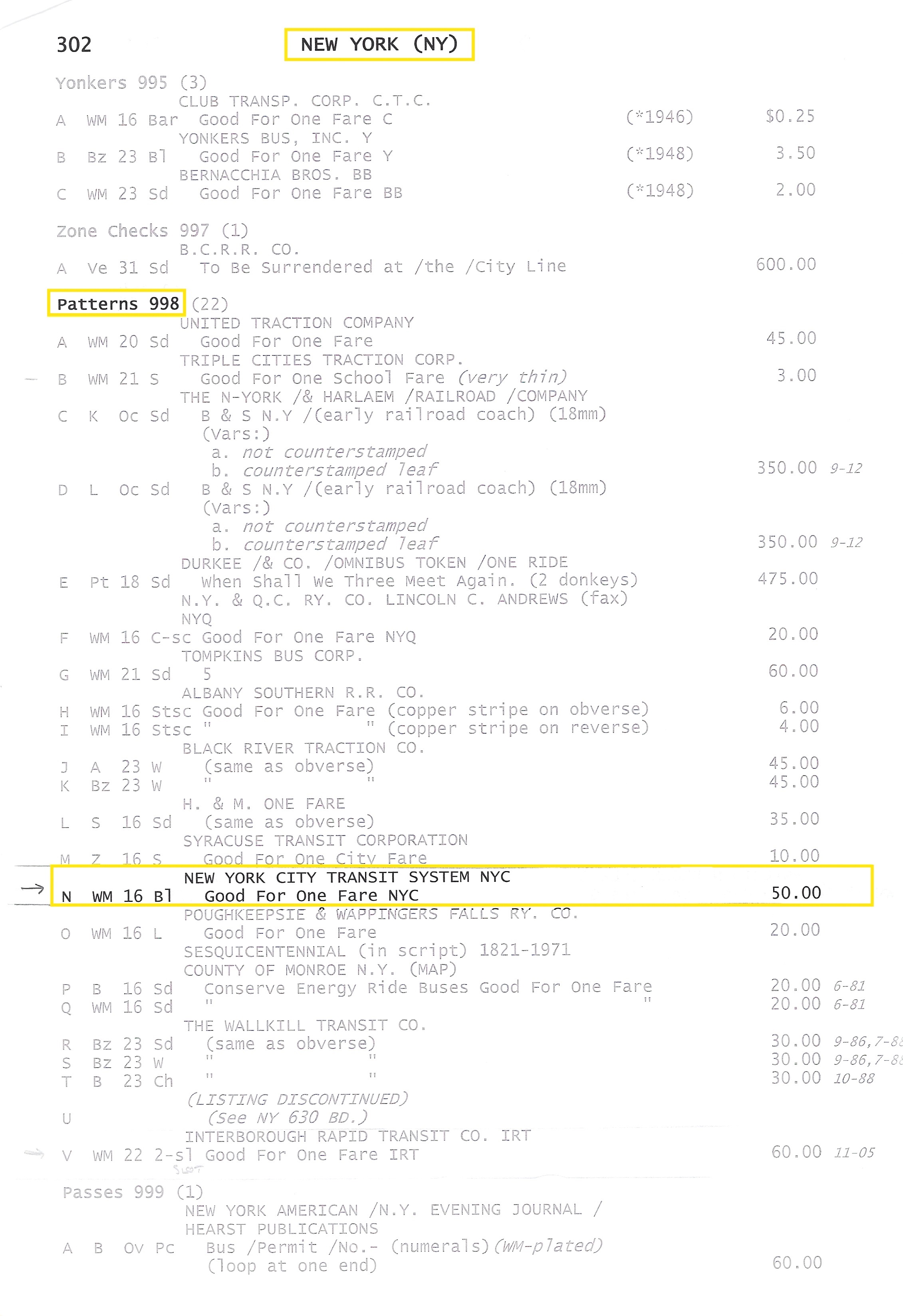 The Atwood-Coffee Catalogue of United States and Canadian Tokens - Seventh Edition, 2016
Compiled and Edited by Joel Bernstein published by the The American Vecturist Association |
| As early as 1928, the
streetcars and buses of the Brooklyn Manhattan Transit Company had
Perry Model 55 "Superstyles" (seen at right) installed instead of fareboxes to accept
nickels. Upon the First Unification in 1940, over 75,000 22mm white metal, and many fewer brass transfer tokens were minted. There were seven basic designs minted, with one of those issues having five die varieties. In that area operation, the surface transfer system had a lot of variations. There were transfers that cost 2 cents, and some were free. Normally, a passenger handed their transfer to the driver and proceeded to the rear of the bus. The installation of this turnstile hindered that, as the turnstile was mounted in the aisle a few feet behind the driver and were it was accessible only by the passenger. The transfer tokens were used to overcome that obstacle. When a passenger desired a transfer to another line, it was requested at time of boarding. The two cent surcharge was paid directly to the operator on the first streetcar or bus, who presented the passenger with a paper transfer. When that passenger boarded the second streetcar or bus, they surrendered the paper transfer to the operator, and in turn the operator gave the passenger a transfer token to be deposited into the turnstile, permitting the passenger to proceed through. In no other terms, it was a doubled procedure that accomplished the same end result. In the case of the free transfers, the token was issued as well to just pass through the turnstile. It appears very likely that the two different color tokens were used to denote the different fare structure: one for free transfers and the other for 2 cent transfers. Also during this time a three-cent child's fare was introduced, and that token was 2 millimeters larger; so some turnstiles were outfitted with a two-slot turnstile. Only a very limited number of buses or streetcars had two slot turnstiles, so these tokens saw very limited use. Normally the patron would pay the three cents for the child to the operator and pass through on a regular transfer token if the vehicle was equipped with just a one-slot turnstile. |
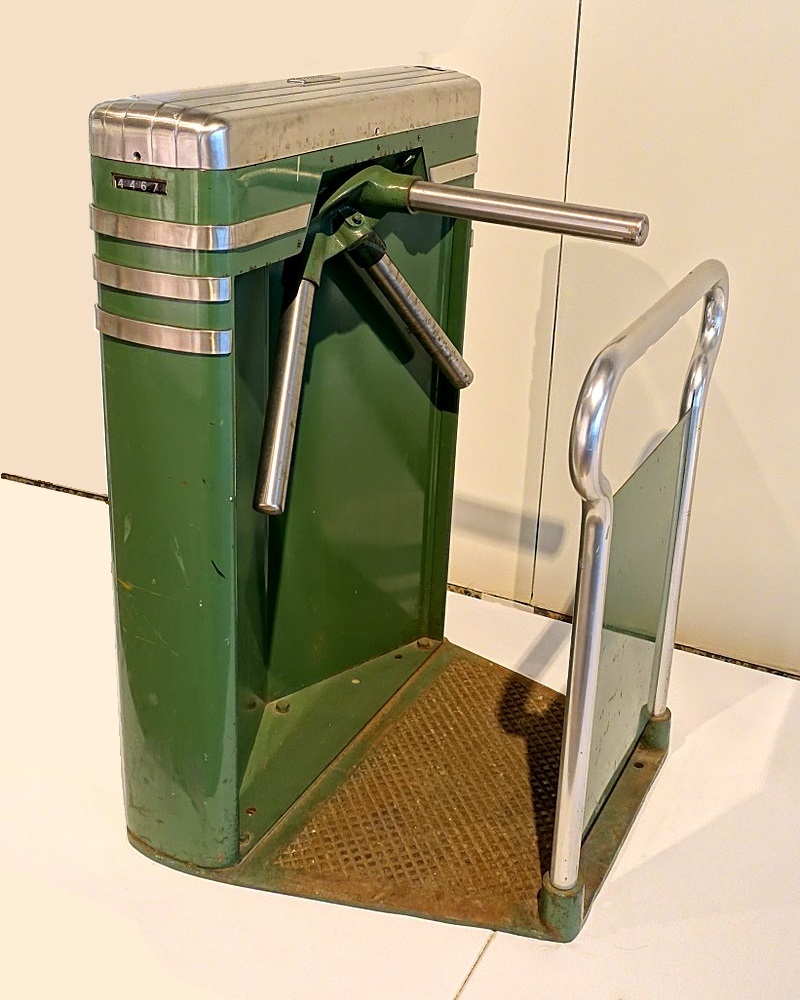 |
.
First Unification; New York City Transit System - 1940 - 1953 |
||
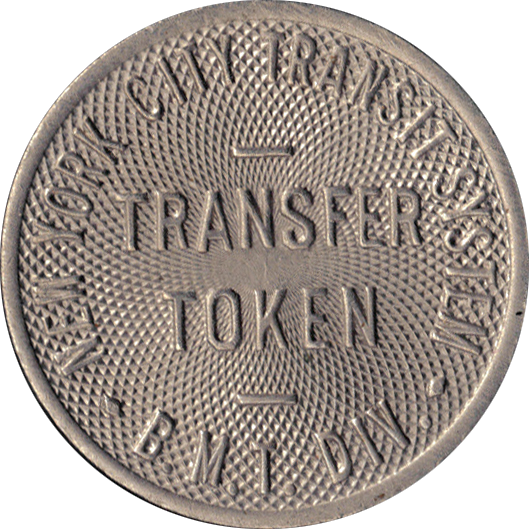 |
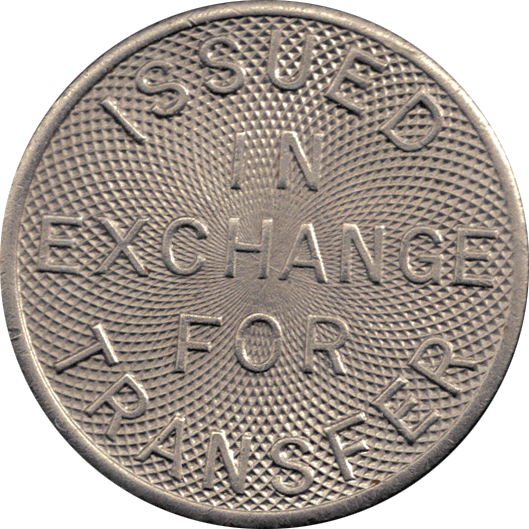 |
1938? 22mm, copper nickel, solid Atwood-Coffee NY629G total struck: 75,000 in five orders from September 1940 through 1947 five varieties: 629Ga, 629Gb, 629Gc, 629Gd, 629Ge, uncommon; $15.00 |
|
|
||
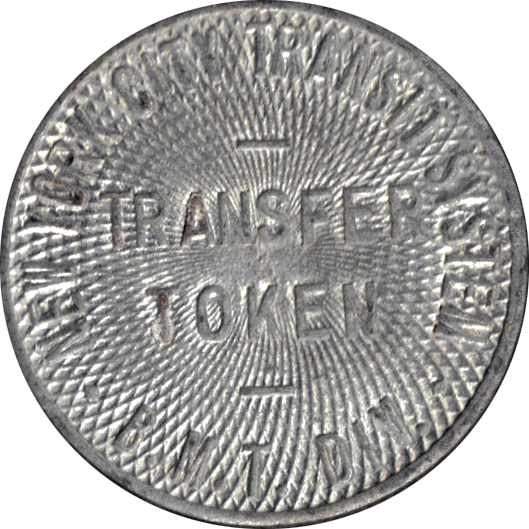 |
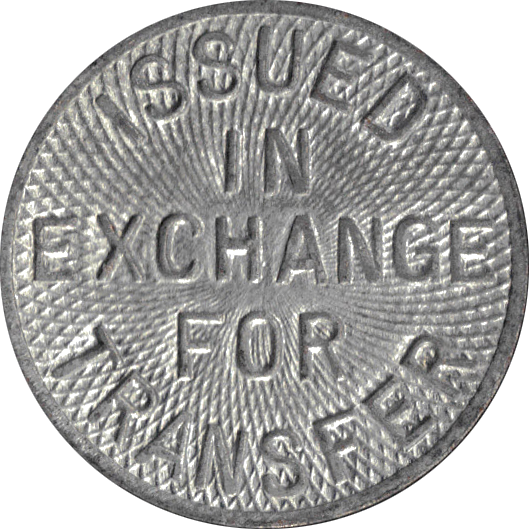 |
1940 22mm, steel, solid Atwood-Coffee NY629H total struck: 75,000 (may include token type above) uncommon; $15.00 |
|
|
||
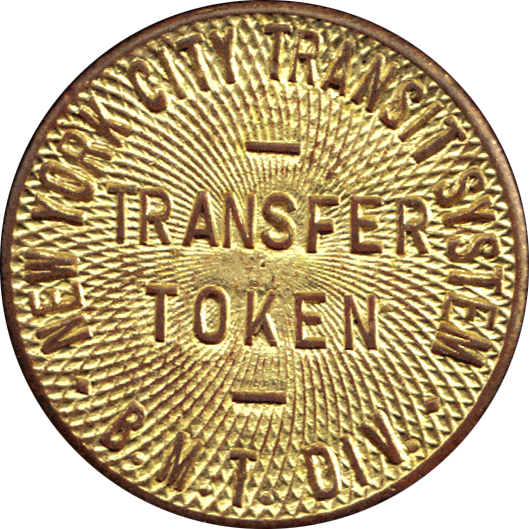 |
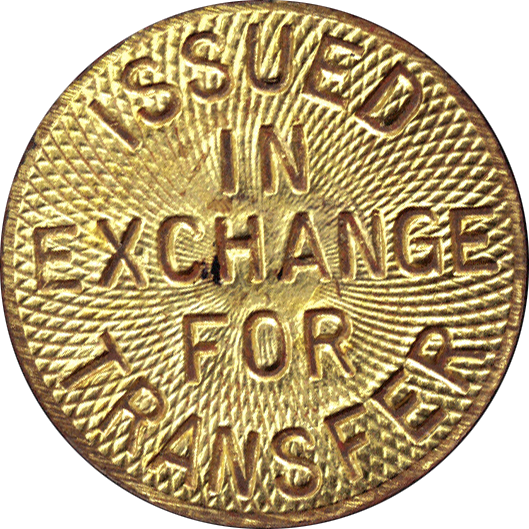 |
1940 22mm, brass, solid Atwood-Coffee NY629I very uncommon; $25 |
|
|
||
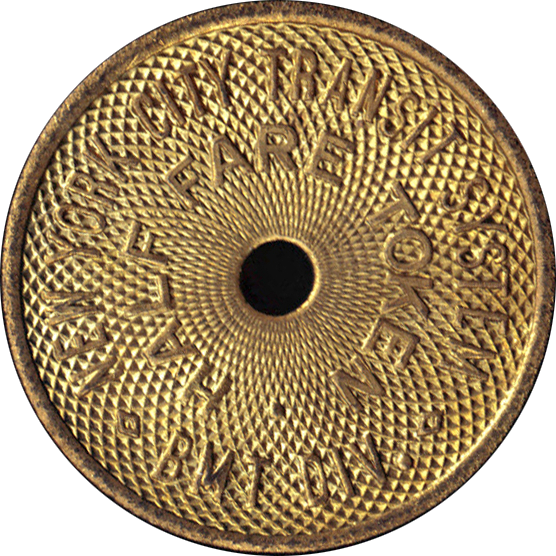 |
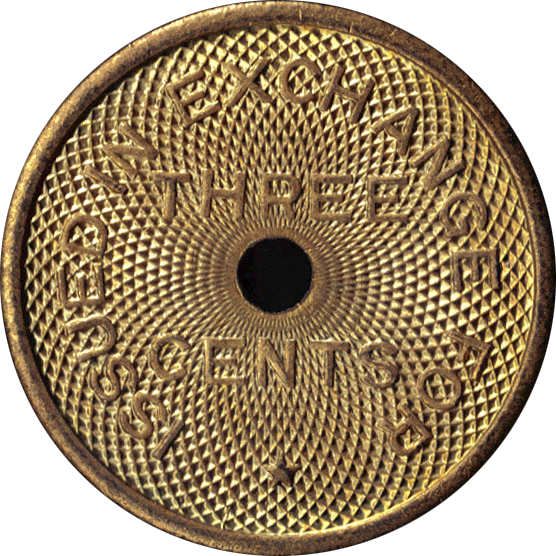 |
1941 Issued for Childrens Fare - associated with the Three Cent Children's Ticket in Fare Tickets Chapter, First Unification above. 24mm, brass, 2mm punch hole in center Atwood-Coffee NY629J total struck: 25,000 in four orders beginning July 1941 uncommon; $12 |
|
|
||
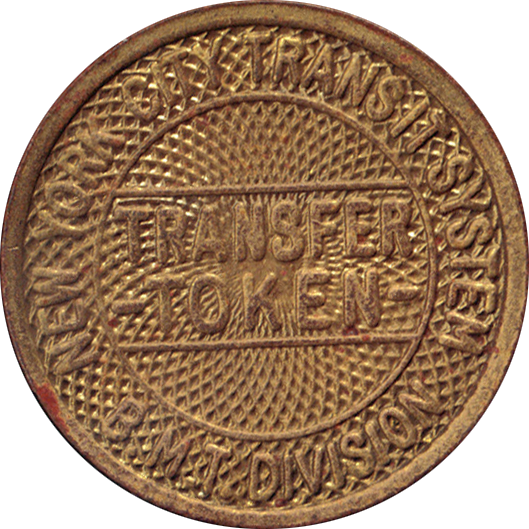 |
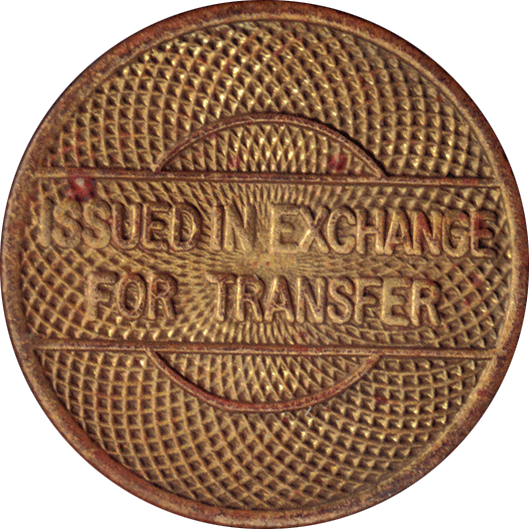 |
1941? 22mm, bronze, solid Atwood-Coffee NY629K uncommon; $20 |
|
|
||
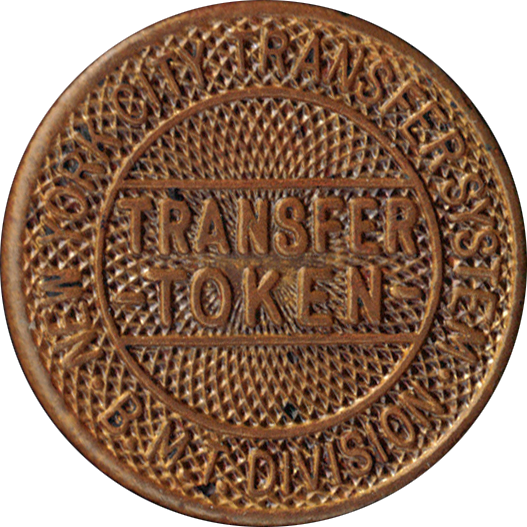 |
 |
Unissued - Error Instead of properly stating the obverse legend: NEW YORK CITY TRANSIT SYSTEM", this token bears the legend: "NEW YORK CITY TRANSFER SYSTEM" 22mm, bronze, solid Atwood-Coffee NY629KA extremely rare; $250 |
|
|
||
| New York City Transit System - Manhattan Bus Division | ||
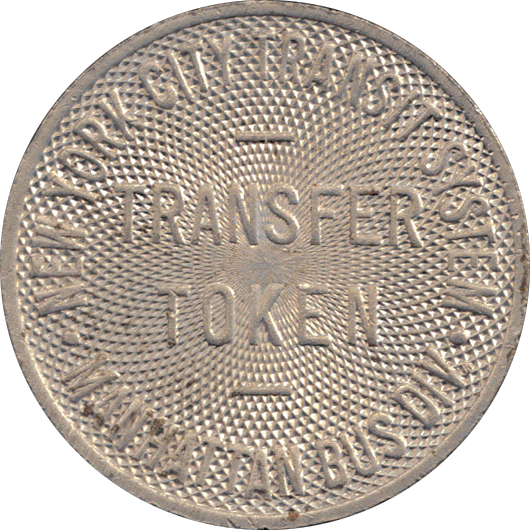 |
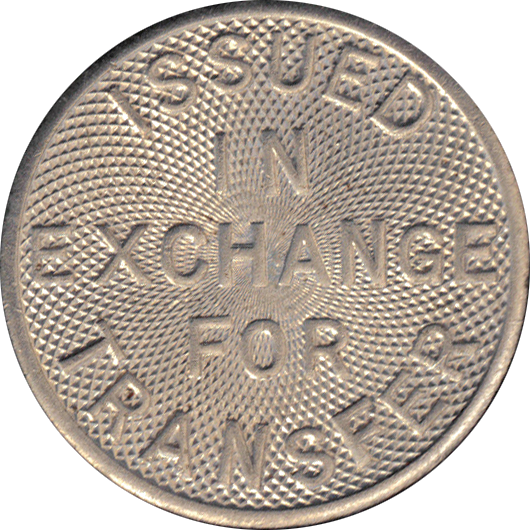 |
1949 22mm, copper nickel Atwood-Coffee NY630V total struck: 5,000 rare; $100 |
| Overview | The Atwood-Coffee Catalog | |||
|
|
||||
| 19th Century Issues - 1827 to 1900 | ||||
|
|
||||
| 20th Century Issues - 1900 to 1940 | ||||
| Bronx | Brooklyn | Manhattan | Queens | Staten Island |
|
|
||||
| First Unification "NYCTS" - City Wide Issues - 1940-1953 | ||||
|
|
||||
| Second Unification "NYCTA" - City Wide Issues - 1953 - 2003 |
||||
| Why a token? Coins vs. Token | ||||
| July 25, 1953: Will the real first token please stand up.. | July 27, 1953 - Jay Street? We have a problem. | |||
| Not complete sets. And a REAL complete set | ||||
|
|
||||
| Token Dispensers | Rolls & "Ten Paks" | |||
|
|
||||
| Errors | Die Set Up | Patterns | Proofs | Counterfeits & Slugs |
|
|
||||
| Token Manufacturing Processes of NYCTA tokens | ||||
|
|
||||
| Scanning Electron
Microscope / Wavelength Dispersive Spectroscopy testing to determine
composition of the NYCTA 5 Borough - Pentagon Token |
||||
.![]()
Second Unification; New York City
Transit Authority Tokens - 1953 - 2003
The 15 Cent Fare: Why a Token and not coins
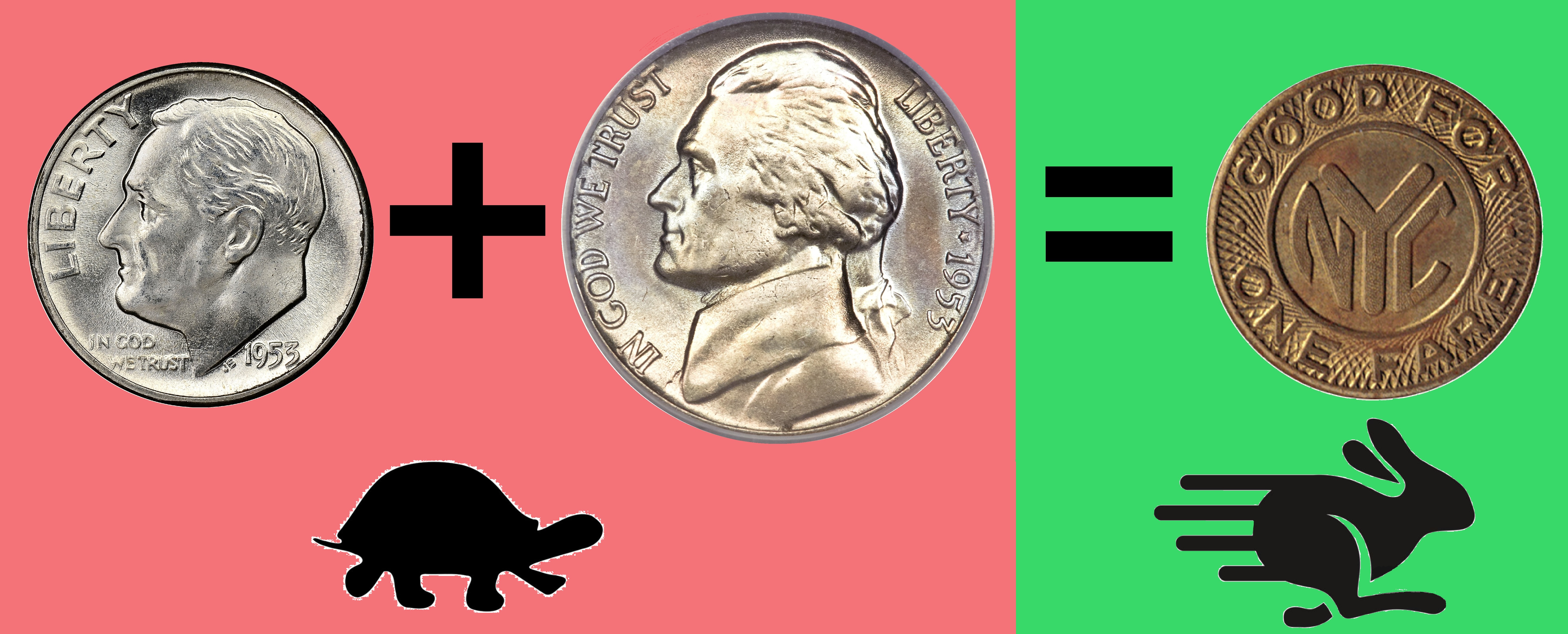
| date | fare amount | maximum coinage | minimum coinage |
||||
| 1904 | 5¢ | 1 nickel | |||||
| 1948 | 10¢ | 2 nickels | 1 dime | ||||
| Had tokens not been introduced, the following coins would have been required: | |||||||
| 1953 | 15¢1 | 3 nickels | or 1 dime and 1 nickel | ||||
| 1959 | 50¢2 | n/a | n/a | n/a | 1 half dollar2 | ||
| 1966 | 20¢1 | 4 nickels | or 2 dimes | ||||
| 25¢ | 5 nickels | or 2 dimes and 1 nickel | or 1 quarter | Please note: the NYCTA never collected a 25¢ cent fare - it went from 20¢ to 30¢. | |||
| 1970 | 30¢1 | 6 nickels | or 3 dimes | or 1 quarter and 1 nickel | |||
| 1972 | 35¢1 | 7 nickels | or 3 dimes and 1 nickel | or 1 quarter and 1 dime | |||
| 1975 | 50¢ | 10 nickels | or 5 dimes | or 2 quarters | or 1 half dollar3 | ||
| 1980 | 60¢ | 12 nickels | or 6 dimes | or 2 quarters and 1 dime | or 1 half dollar and 1 dime | or 1 half dollar and 2 nickels | |
| 1981 | 75¢ | 15 nickels | or 7 dimes and 1 nickel | or 3 quarters | or 1 half dollar and 1 quarter | or 1 half dollar and 2 dimes and 1 nickel | or 1 half dollar and 3 nickels |
| 1984 | 90¢ | 18 nickels | or 9 dimes | or 3 quarters and 1 dime and 1 nickel | or 1 half dollar and 4 dimes | or 1 half dollar and 8 nickels | |
| 1986 | $1.00 | 20 nickels | or 10 dimes | or 4 quarters | or 2 half dollars | or 1 half dollar and 2 quarters | or 1 dollar coin |
| 1990 | $1.15 | 23 nickels | or 11 dimes and 1 nickel | or 4 quarters, 1 dime and 1 nickel | or 2 half dollars, 1 dime and 1 nickel | or 1 dollar coin and 3 nickels | or 1 dollar coin, 1 dime and 1 nickel |
| 1992 | $1.25 | 25 nickels | or 12 dimes and 1 nickel | or 5 quarters | or 2 half dollar coins and 1 quarter | or 1 dollar coin and 5 nickels | or 1 dollar coin and 1 quarter, |
| 1995 | $1.50 | 30 nickels | or 15 dimes | or 6 quarters | or 3 half dollars | or 1 dollar coin and 5 dimes or 10 nickels | or 1 dollar coin and 2 quarters |
| 1 = In 1956, the Rockaway Line south of Howard Beach was a double fare zone = 30¢ This double fare was not abolished until 1975. 2 = In 1959, specially equipped turnstiles accepted half dollars only for the Aqueduct Racetrack Special Train. Patrons of the Aqueduct Special either brought their own half dollars or obtained them from a clerk at the two stations where the Aqueduct Special departed from: 42nd Street & Port Authority Bus Terminal or Hoyt / Schermerhorn Streets 3 = As far as is known, the NYCTA did not accept half dollars in bus fare boxes. Only token dispensers and token booths accepted them for payment (with reluctance). |
|||||||
.
.
|
The second factor to be considered, and yet is hardly (if at all)
discussed in regards to transit payment systems, is the speed of payment. In a usage application where speed is not of the essence, such as vending; obviously speed is not crucial. But when in regards to high speed - high volume usage such as those of rapid transit transportation, especially in large stations or terminals; and / or at peak times, those being 7 am - 9 am and 4 pm to 6 pm (the "rush hours"); any delay in paying at the turnstiles hindered the flow of pedestrian traffic. Thus, any delay in depositing the coin or token by a single passenger at the turnstile had an consequential effect on following passengers. |
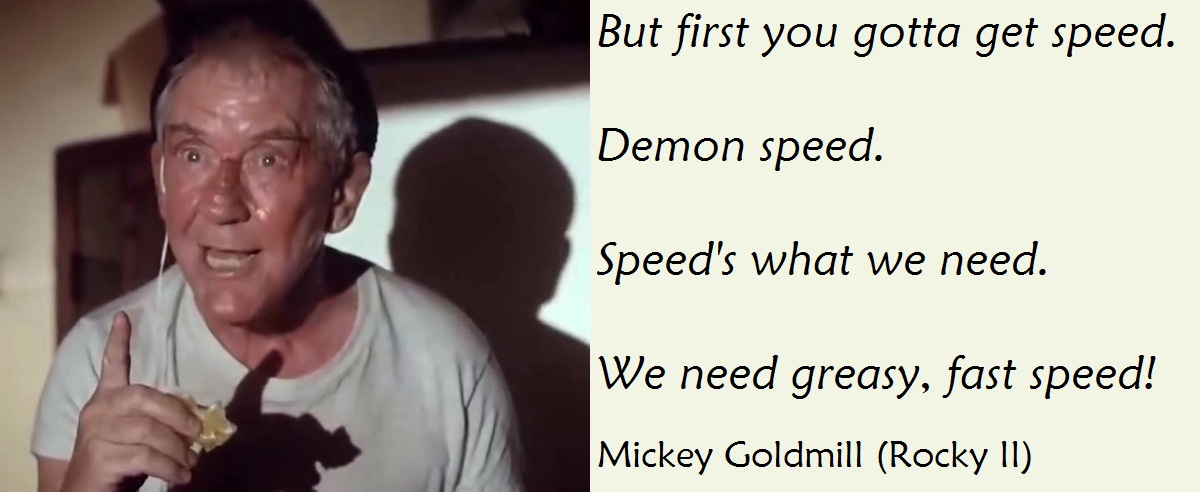 |
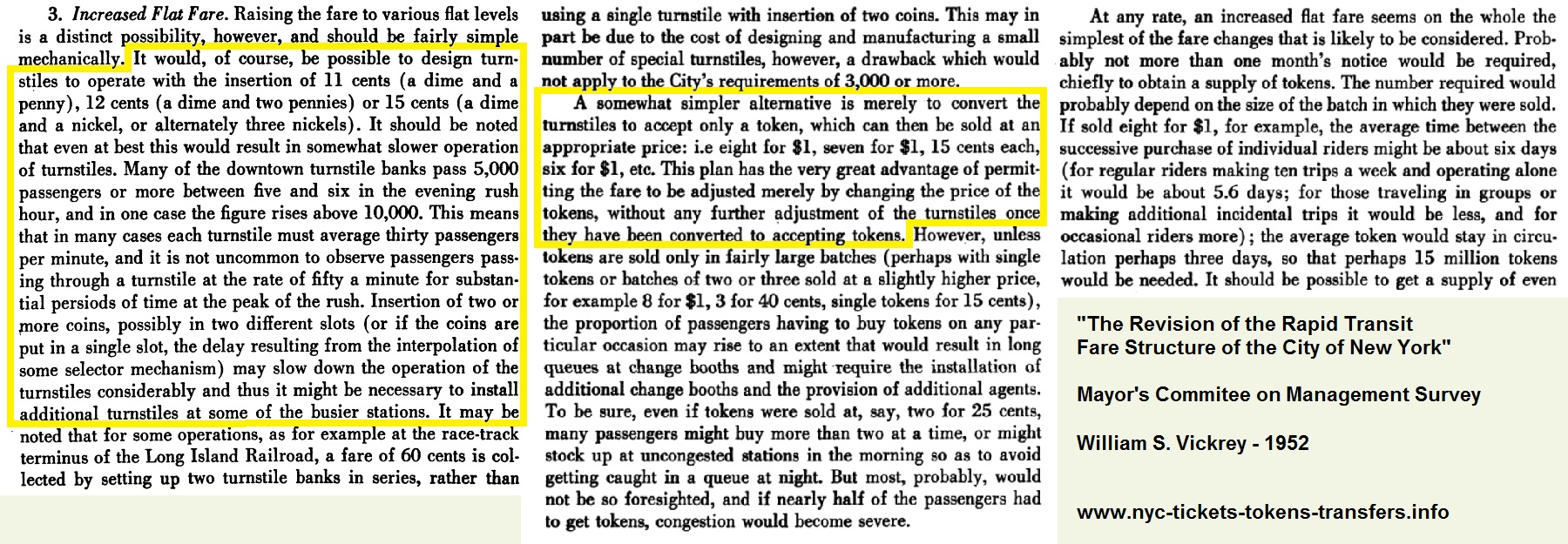 |
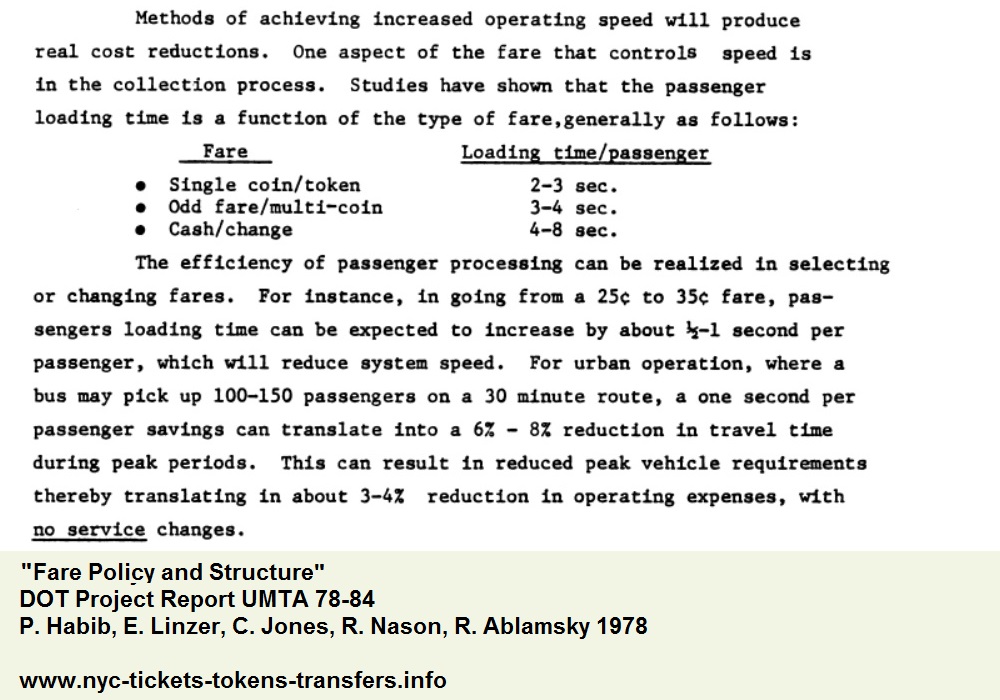 |
| "The Revision of the Rapid Transit Fare
Structure of the City of New York" - Mayor's Committee of Management Survey William S. Vickrey - 1952 |
"Fare Policy and Structure"; DOT Project Report UMTA 78-84; Habib, Linzer, Jones, Nason, Ablamsky, 1984 |
From these documents, we can extrapolate the during rush hour, a single turnstile can see one actuation every two seconds (or 30 people per minute, / 1800 people per hour.) As most large stations and terminals have at least 3 to 4 turnstiles, this gets us to the figure of 5400 to 7200 persons per hour (turnstile actuations), per station.
Also as stated, the turnstile actuation rate has even been recorded as high as 50 passengers through a single turnstile per minute, or 1.2 seconds per actuation; and a remarkable testament to the reliability of the mechanisms, which permit this traffic.
.
The principal of K.I.S.S. (and we're not talking about the rock band!)
In payment of a fare, inserting a single object into a single slot, was the epitome
of
the acronym: K.I.S.S. "Keep It Simple Stupid."
The K.I.S.S. principal, suggests that most systems and designs work best when they are kept simple, rather than made overly complicated. This means a focus on clarity and ease of understanding over clever, sophisticated solutions or multiple choice decision making.
It had been discovered through multiple generalized studies regarding time, motion and efficiency; beginning with Frank B. Gilbreth in 1912; and more specifically in regards to fare payment, that when it came to users (payors, passengers, etc) of mass transit, having to deposit a coin or token to enter through a turnstile, the use of multiple coins significantly increased the time required to go through said turnstile. In other words multiple coins "gummed up the works."
In a multiple coin slot system, the user in having to
place
the correct coinage in the correct slot required a thought process.
"Place the dime in the small slot, the nickel in the big slot." With
the single coin or token, it was already second nature - a pre-programmed
mental conditioning: insert token, push.
| Studies showed multiple coins slowed down the
process of passengers paying and transiting through the
turnstile. Ironically this very problem and the research behind this issue appears to even been forgotten (or taken a back seat to convenience) and would be encountered once again in 1978. This was when the New York City Transit Authority attempted to implement turnstiles that accepted coins and / or tokens for convenience with the Duncan Industries Model TC "Token - Coin"; which accepted two quarters or a token for the 50 cent fare. The issue encountered with these turnstiles was determined to be that many payors kept placing the wrong object in the wrong slot; re: placing the token in the quarter slot. |
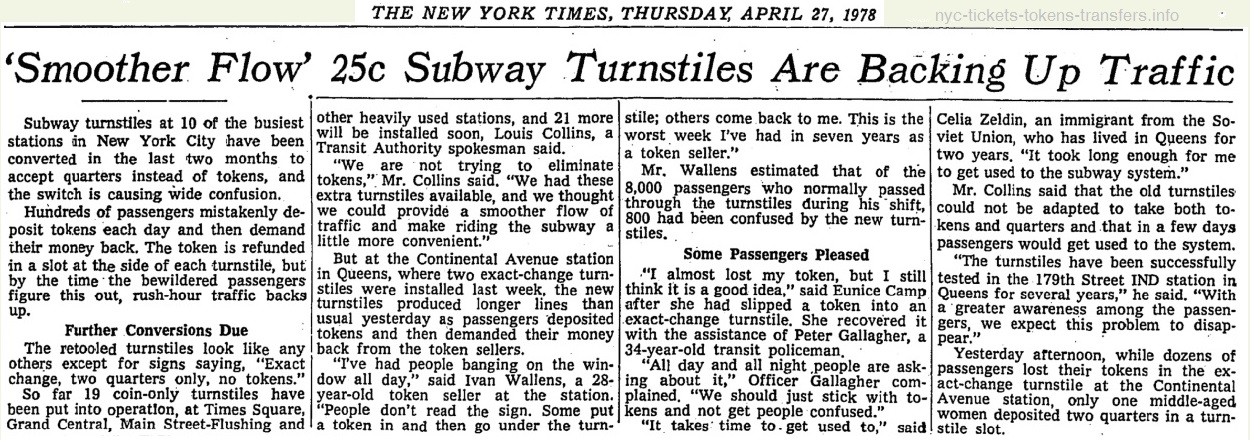 |
Furthermore, persons handling more than one coin, especially doing so in a hurry (hence rush hour), thereby increased the chances of that person fumbling and dropping one or both of the coins on the floor, requiring them to stoop down and retrieve said coin(s) - IF they did not roll far or beyond the turnstile. If this occurred, then the payor needed to dig out replacement coinage from pocket or purse.
For comparison, think back to old payphones where there was a opening for a nickel, dime and quarter. If you were calling a local telephone number, a nickel or dime (and later a quarter) made your connection. One coin - ding - dial tone. But when you had to make a long distance call, and required varying amounts of change; you couldn't hold but more than a few coins at once in your hand. And no matter how many coins you could "palm" (hold in the palm of your hand), it took a few seconds to manipulate the next coin to your finger tips to deposit that coin into the slot. Most people put their coins on small metal tray in front of the phone and deposited the individual coins one at a time. This was not an option in the fast moving subway turnstile.
In a rapid transit (subway or elevated) setting ("rapid transit") however, a single turnstile at peak travel time (the rush hours) could see one person depositing a coin or token every two seconds; which equates to 30 per minute; especially at major stations and terminals. Watching the following archival flim clip of people going through the turnstiles in a New York City subway station. At the 1 minute 22 second mark; one will witness a smooth, uninterrupted procession of one person to the next.
Matter of fact, you can even see "a fumble" where a passenger missed the token slot but quickly recovered the token. Using a stop watch, it only takes 1.8 to 2 seconds from the time the token is deposited by the leading person and for that person to walk through, to the second person depositing their token and repeating the process.
Therefore, the introduction of multiple mechanisms and / or multiple coin slots in a turnstile; increased the likelihood of a misfed coin or token, which in turn resulted in rejection and failure to release the turnstile. Multiply this by the number of turnstiles at a busy station, and it would equate to a recipe for unwanted delay.
In a turnstile admittance system with slow moving pedestrian traffic such as those used for admission to libraries, museums, cafeterias, et al, this lack of speed was not much of a factor. But when in relation to New York City rapid transit (the subway and elevated system), reliable operation of the turnstiles equated to speed of the payment and admission process.
This speed of payment was conducive to mass transit system where hundreds of thousands to millions of people moved through the system daily like in New York City.
As such, the single coin or coin-like object, whether it be a single nickel, dime, quarter; or a token; equated to speed. Multiple coins or choices slowed down the works. And in the New York City subway, this would not do.
Speed was not as crucial on surface transportation
Payment speed was not as much of a factor on surface transit methods, i.e: streetcars / trolleys and / or buses. It must also be remembered; New York City Transit Authority tokens were NOT even accepted on buses or streetcars until May 18, 1963 - almost 10 years AFTER tokens were introduced for the subway. With streetcars & buses, it was generally accepted that the prevailing fare would be paid by combinations of coins or a token in later days, with most people conditioned to have the change ready as the bus approached.
The reasoning for this was, stemmed from either the trolley conductor (or in later operations the bus operator); would be present and made change (until 1969) and could remediate fare payment problems; and whereas some people required a transfer or directions for a connecting bus; the payment process was inherently slower.
Another factor inherent to surface operations; was the 2 or 3 cents most companies charged for a transfer to another line. So here, we now have pennies added to the equation of coins needed on a streetcar or bus, either furnished by the passenger at time of purchase of the transfer, or received by the passenger in change from the conductor / operator.
But also, even during rush hour / peak travel times; at best a single bus of the 1950's era only saw a capacity of approximately 40 to 60 people at a single time, and the boarding process was slow enough a passenger could deposit the mix of coins into a fare box built with a sorting mechanism, which took five to seven seconds per passenger: one person at a time, steps up onto the bus, change at the ready to deposit into the fare box and the driver visually verifying the drop of coins before pressing the accepting lever.
Speed, in Advance
Another positive attribute to token use, is such that token operation lends itself very well to prepayment. A pack of ten tokens is significantly less cumbersome than say a roll of 40 or 50 coins of equal value to the tokens, and can be sold in advance.
Pre-payment also has an added benefit for the transit agency (i.e. the NYCTA) is holding ones money in advance, instead of that person holding their money. Say a transit passenger purchased one token at a time; the agency only sees minimal investment and still has to pay the clerk wages to dispense a single token.
But if a passenger purchases ten tokens in advance, and the transit agency held onto the monies from the balance of nine tokens not used at moment.
And, say in the case of a tourist or short term visitor to New York City, and of whom purchases a ten pack (or an unlimited MetroCard); and departs before using all ten tokens (or the full value of the MetroCard) - the transit agency sees a windfall. They get to keep that money. Those tokens or fare card are only good for that particular transit agency and no where else (except in cases when used as a slug); whereas US coinage could be used all over the country, and any business or bank. There was no incentive to "purchase" US coins ahead of time, and even if there were; you could get rolls at any bank and most large businesses for no charge. You held the full value until used.
An added benefit of tokens was a security issue: a change in the size slot on the turnstiles could not take place to deter prevent slug use in regard to US coin usages; which was standardized and widespread. Whereas in regard to tokens, the single token size could be changed to discourage and prevent the of using slugs. If an increasing amount of slugs or counterfeit tokens was realized; a new smaller or larger, or thicker token could be released superceding the old type.
This could not be done with US coinage because of their nationwide or worldwide remittance factor.
Hence the decision by the New York City Transit Authority to implement the token as a solitary device for fare payment and general admission for fares of that required more than a single coin.
As tabulated by the Rail Transit Fare Collection Policy and
Technology Assessment, December 1982 DOT Urban Mass Transit
Administration (Govind K. Deshpande, John J. Cucchissi, Ronald C. Heft
(Jet Propulsion Laboratory, Page 26); the ratio of failures in the
Perey Turnstiles in the New York City subway system averaged 1 failure
for every 45,000 actuations. This was an impressive figure,
and as
noted in the pulbication, as other and smaller municipal transit
operations with multiple payment options suffered significantly higher
failure rates at the turnstiles
|
Rapid transit = rapid fare payment. So yes, in
this
hyper-fast paced world of fare collection
on a mass transit system; the single token was the sane choice. Simple.
Secure. Durable. Versatile. Reliable. Convenient. And cost effective
for the issuing agencies. Accepting multiple denomination of coins at the turnstiles meant more coins to process which meant more complicated mechanisms. If the turnstile had room for a sorting method, that meant three holding tubs. Nickels dimes quarters and tokens. Not enough room, meant all the coins in one tub, to be sorted by the clerk which equates to time consuming sorting at end of shift. Using one token kept the mechanism simple and its reliability high and the coin sorting took place intermittently and at time of purchase, instead of all at once at end of shift.. Furthermore, with subsequent fare hikes, the size or magnetic property of the token could be changed to prevent the hoarding of, and prevent the use of lower value tokens. Furthermore, it was a security measure as well: changing the size or properties of a token prevented older generations of slugs from being used via a new size token. Even with the advent electronic fare payment systems with the Metrocard, glitches were encountered. When the MetroCard was first introduced in 1997, the premise was the same - a single swipe of a plastic card was supposed to allow activation of the turnstile mechanism. However, it was soon discovered that a bent or creased plastic card, or a card that had been near a strong magnetic field (i.e.: laid on or a near a computer, or a speaker) had corrupted the embedded magnetic strip. Either of these conditions caused the cards not to read properly, if at all; and failed to release the turnstile and allow the payor through. This required the user to swipe more than once, with each swipe taking a few precious seconds; with waiting passengers lining up behind them. These glitches "choked" the turnstiles, and slowing down pedestrian traffic through the turnstile. |
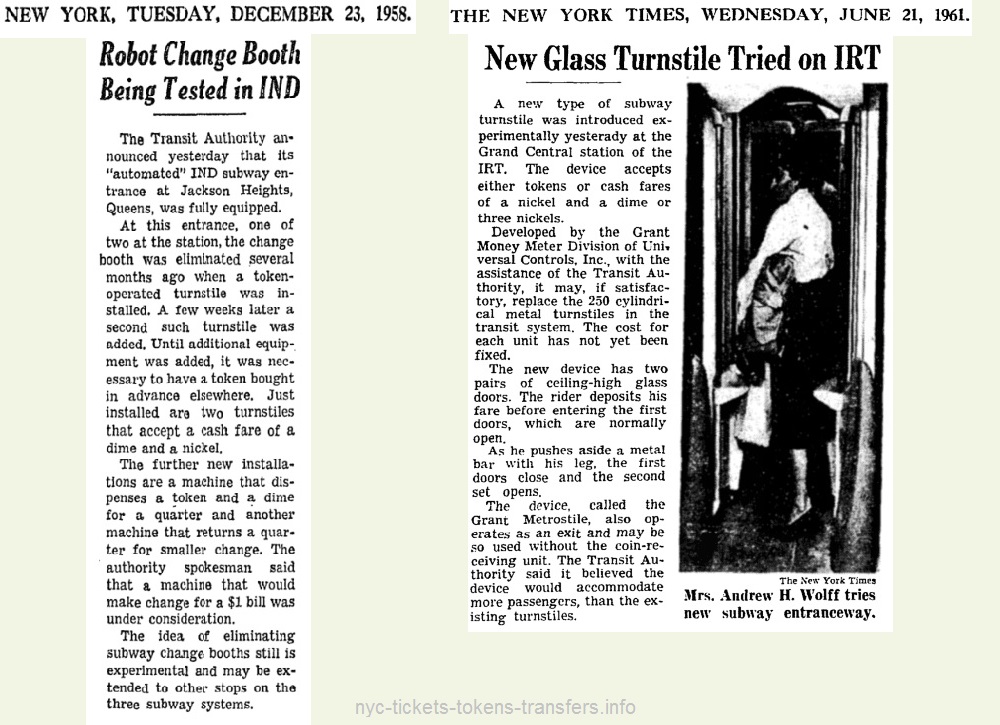 |
|
|
..
 It was only in circulation for approximately six weeks before
being culled out of circulation by September 1953.
It was only in circulation for approximately six weeks before
being culled out of circulation by September 1953. Most people only recall the "Small Y Cutout":  and
now misattribute it as the "first token". This misattribution is also
repeated by the Transit Museum. As a result of this and quite
unfortunately, many transit and city history related websites, blogs and social media posts refer
to this as the "first token". However, it is not.
and
now misattribute it as the "first token". This misattribution is also
repeated by the Transit Museum. As a result of this and quite
unfortunately, many transit and city history related websites, blogs and social media posts refer
to this as the "first token". However, it is not.
The reasons for the lack of general recognition of the first token had remained foggy until now. According to George Cuhaj, it is accepted and understood that the Transit Authority needed to get a token into circulation in time for the announced fare hike to 15 cents on July 25th.
As there has been nothing official published or displayed on the part of the Transit Museum, this piqued my interest and led me to research the matter. I would be well rewarded for my efforts. I gleaned the following articles from the New York Times Digital Archives, and they uncovered and clarified the situation quite well.
So, I put together this scrapbook of articles, so the unedited copy could be reviewed. A synopsis, and my notes follow.
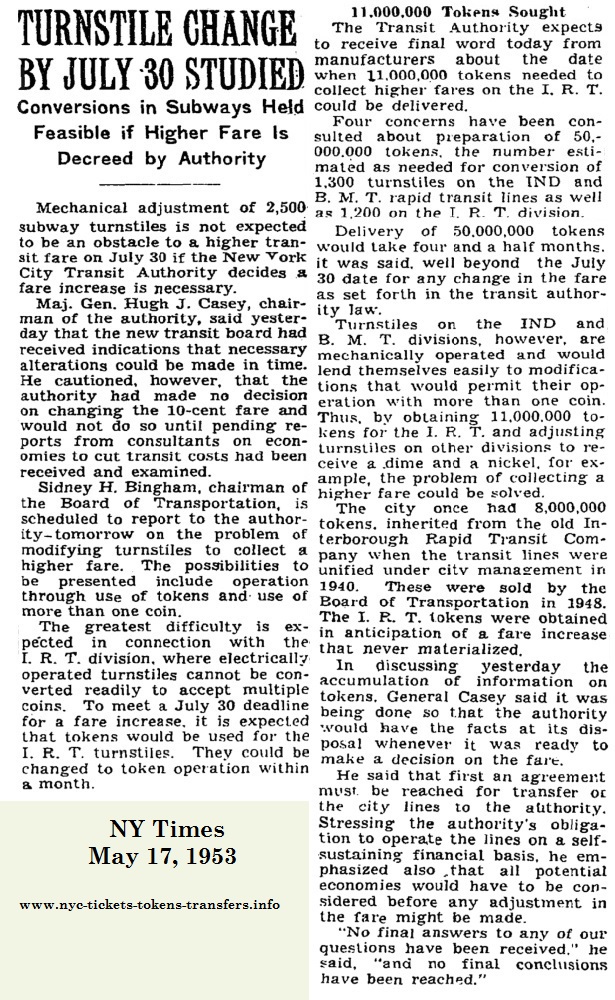 |
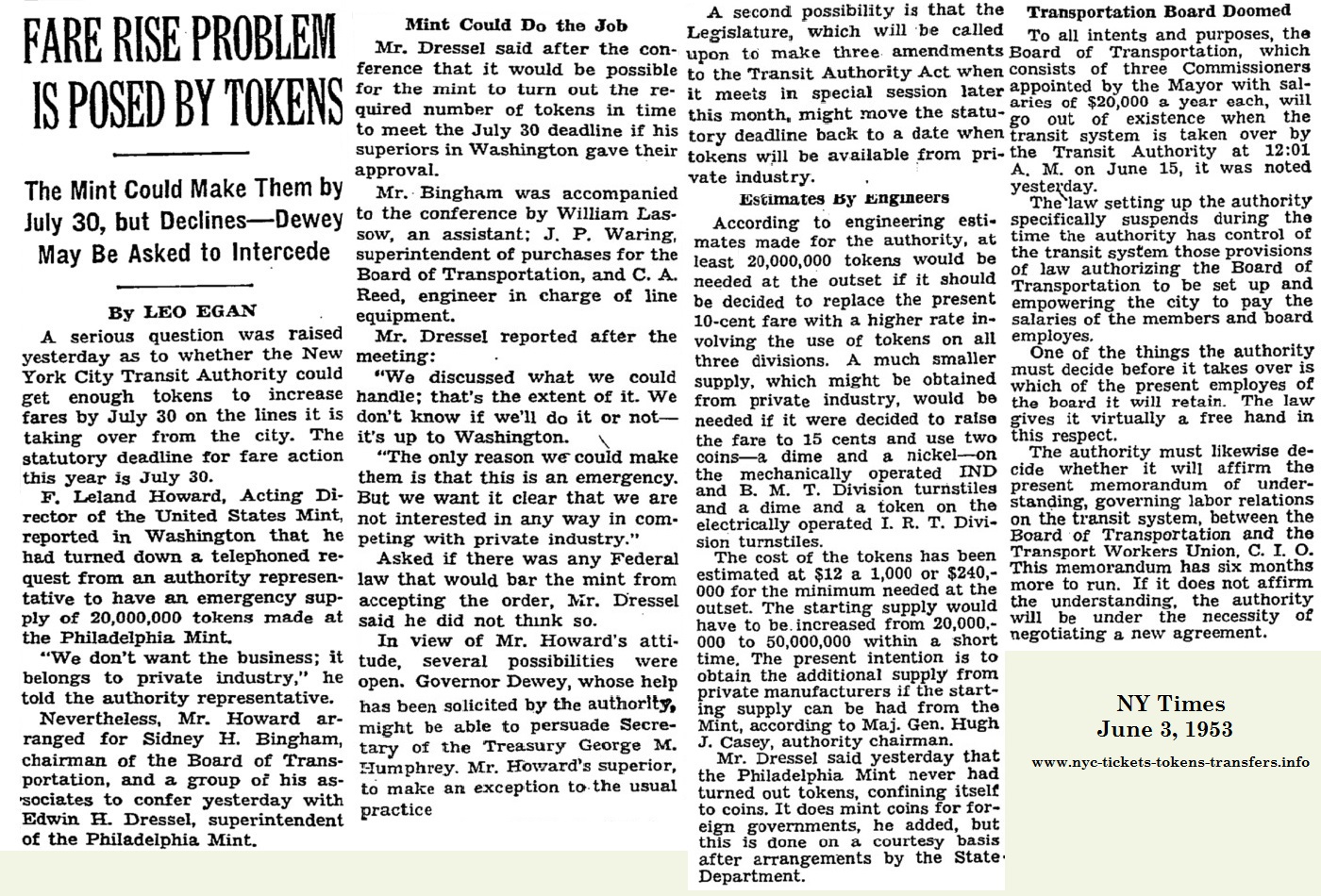 |
| New York Times - May 17, 1953 | New York Times - June 3, 1953 |
.
.
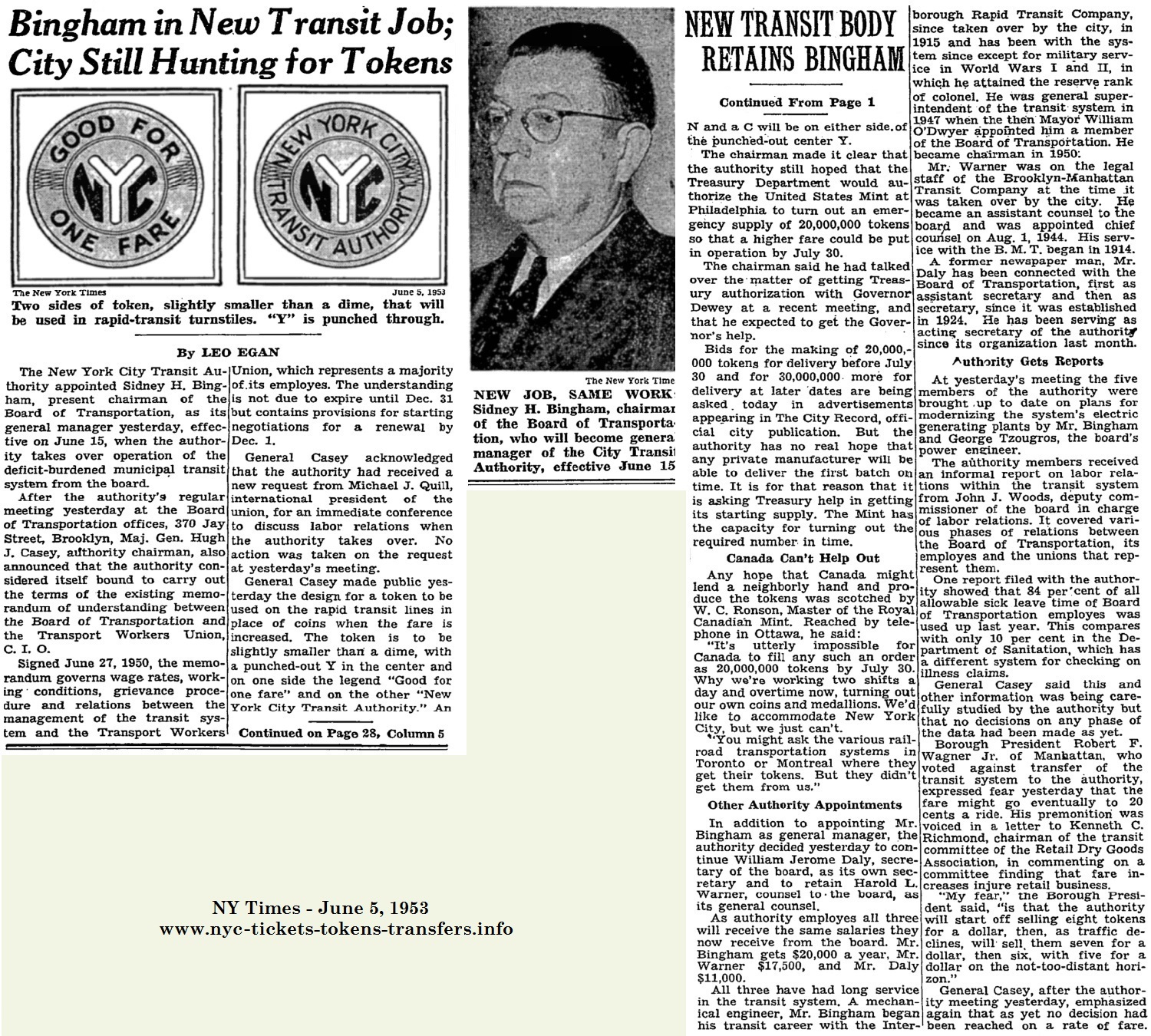 |
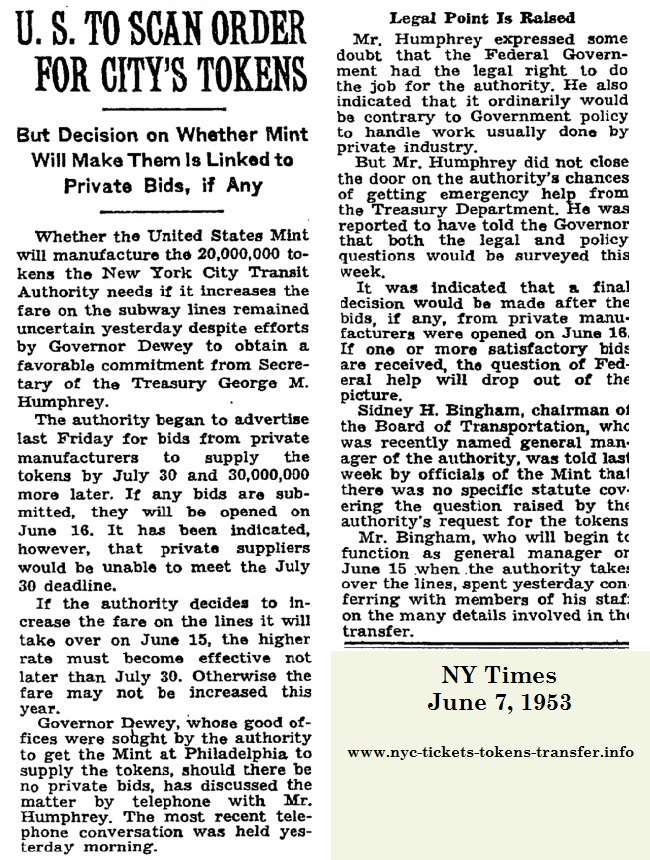 |
| New York Times - June 5, 1953 | New York Times - June 7, 1953 |
.
.
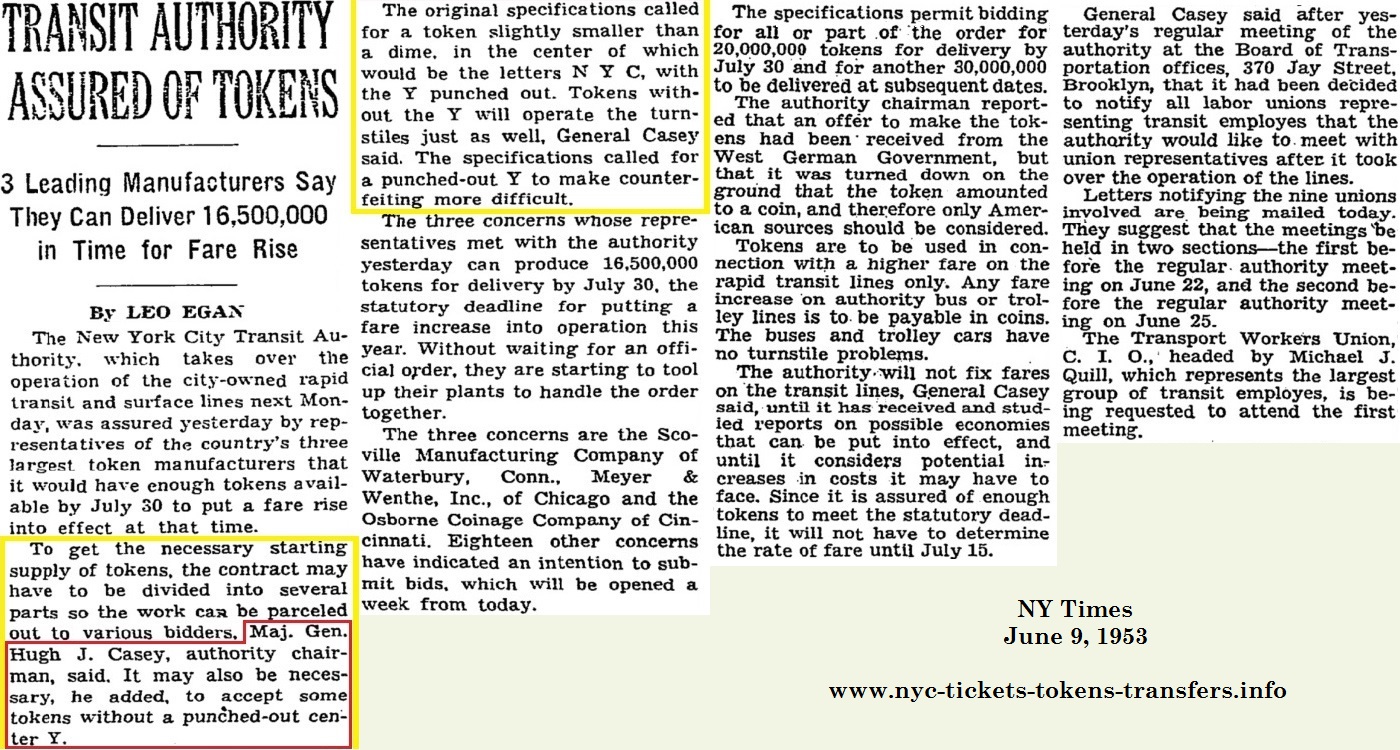 Note the highlighted text: Maj. Gen Hugh J. Casey authority chairman, said, "It may also be necessary to accept some tokens without a punched-out center Y." |
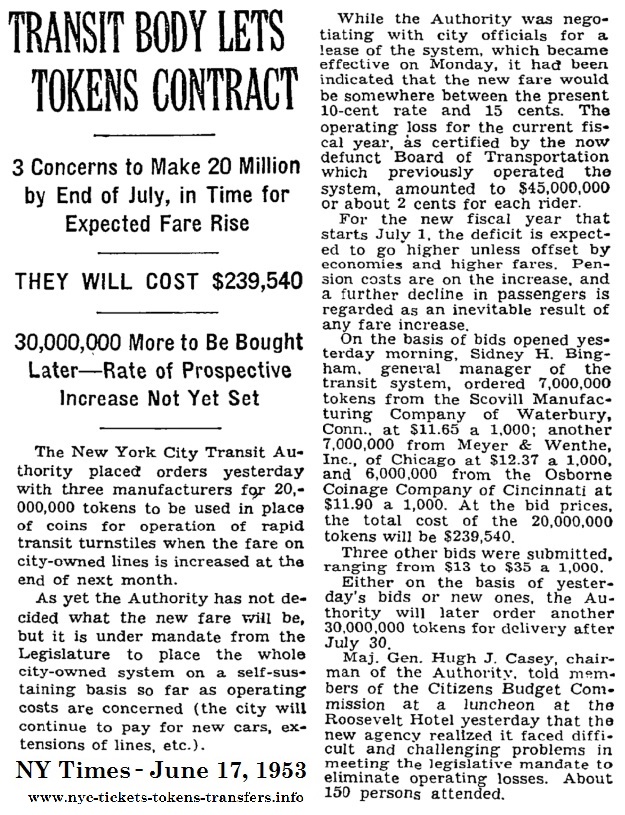 |
| New York Times - June 9, 1953 | New York Times - June 17, 1953 |
.
.
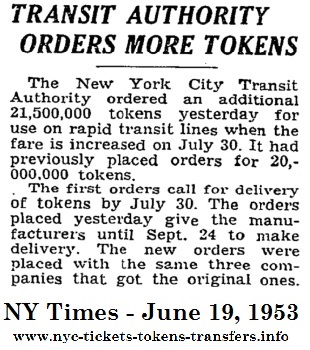 |
 |
| New York Times - June 19, 1953 | New York Times - June 21, 1953 |
.
.
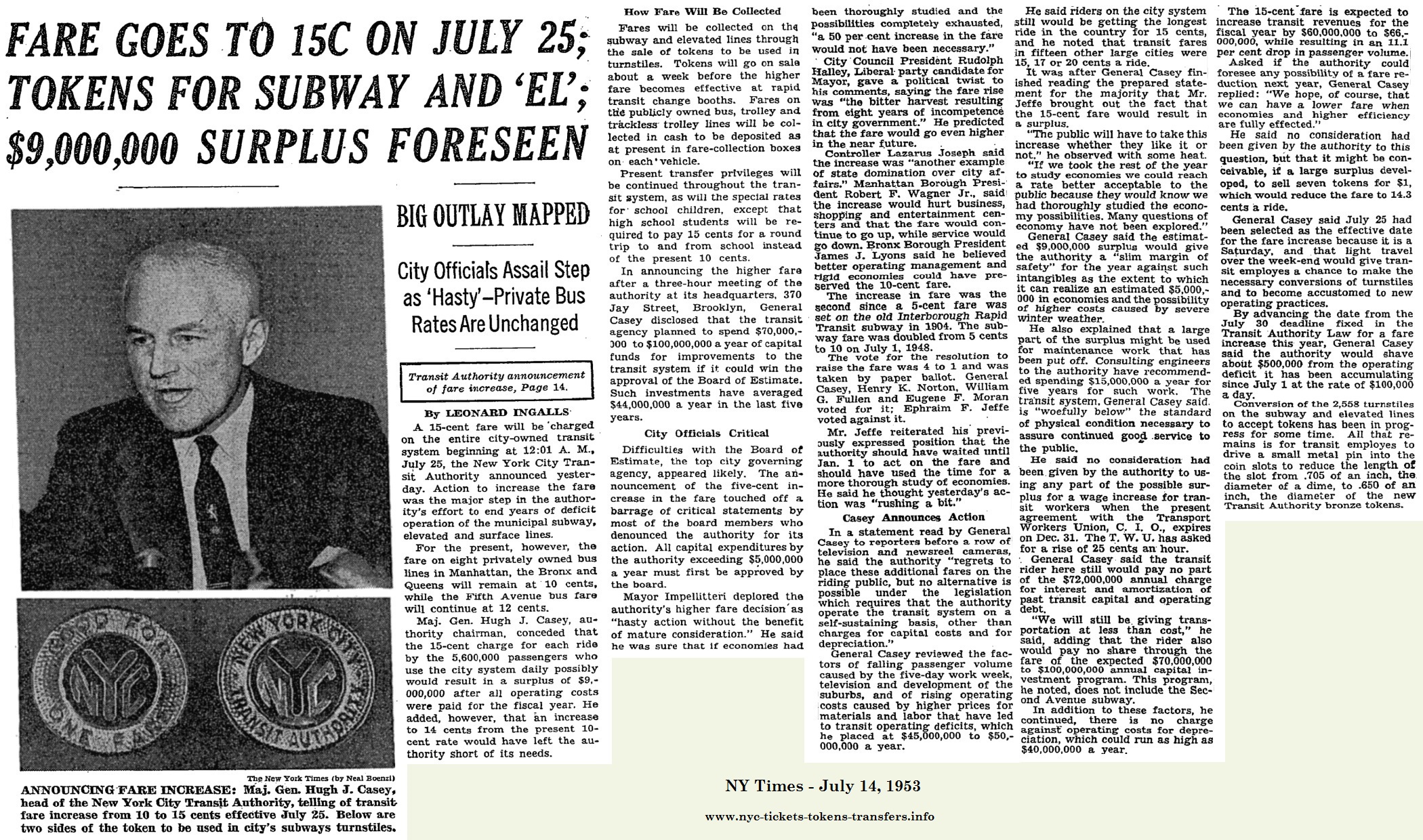 |
| New York Times - July 14, 1953 |
.
 |
| New York Times - July 23, 1953 |
.
.
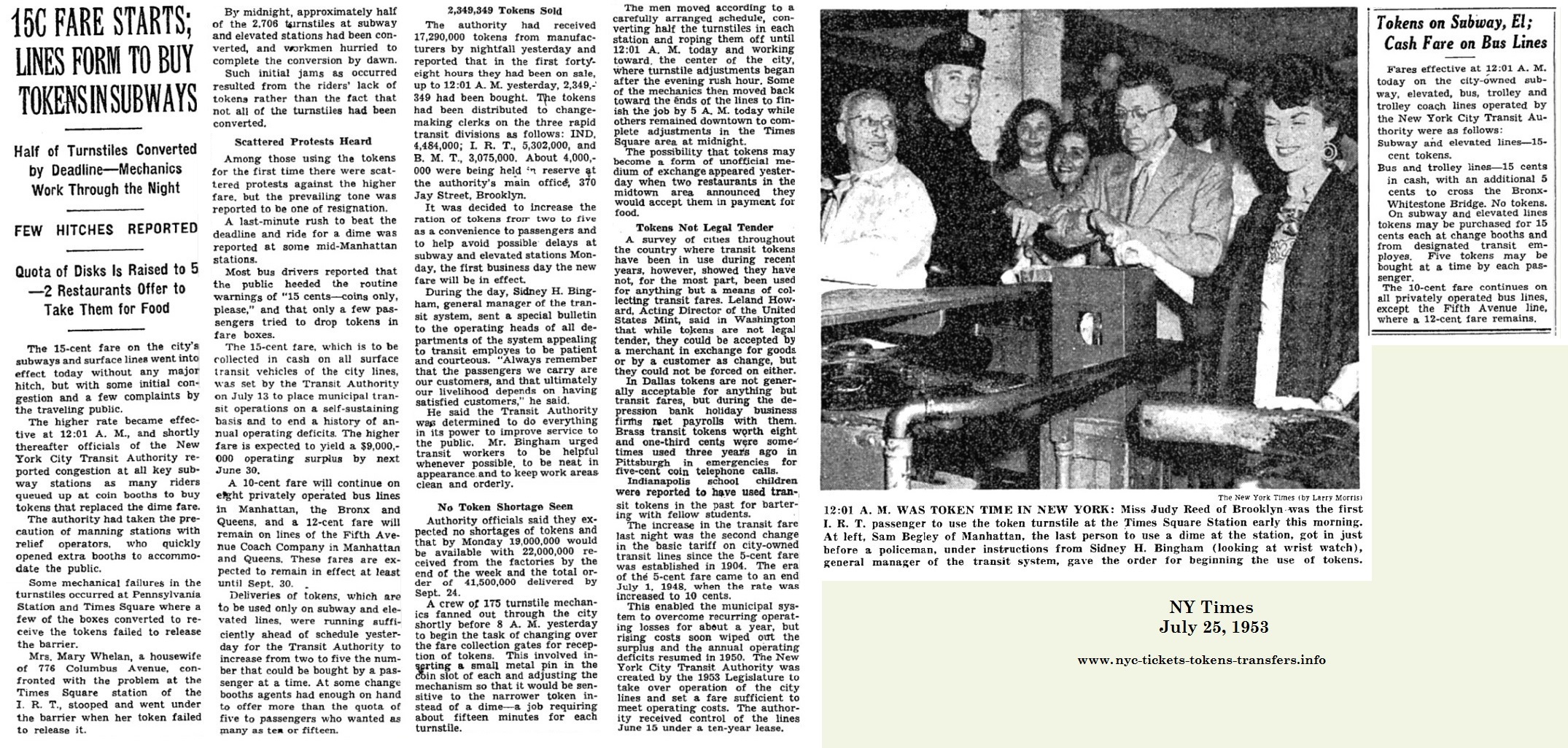 |
| New York Times - July 25, 1953 |
.
.
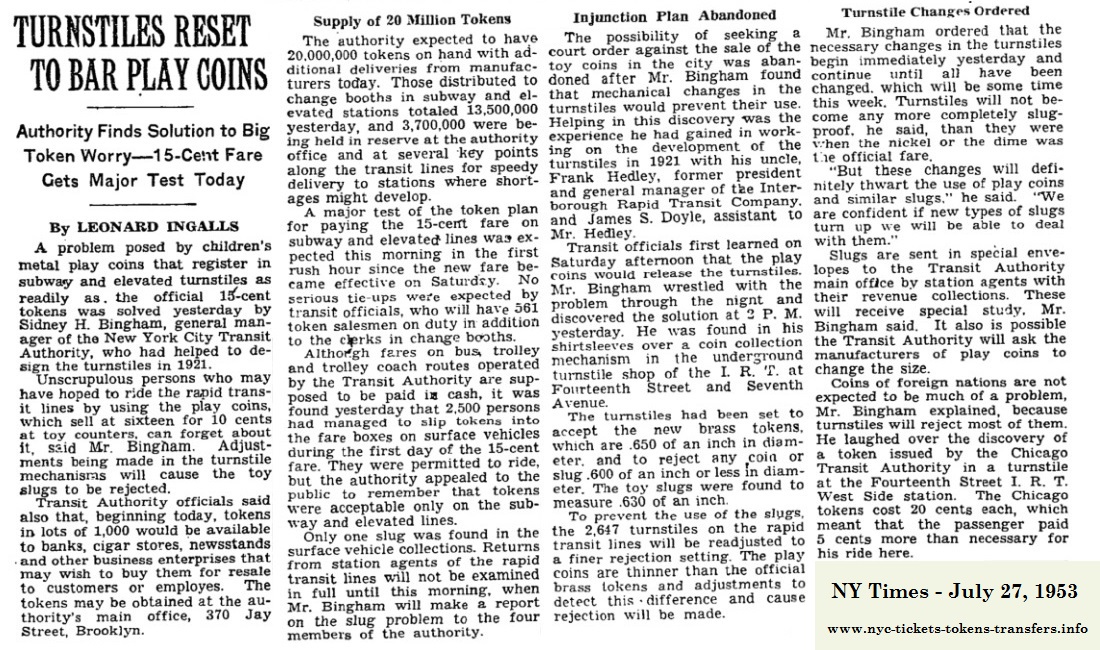 |
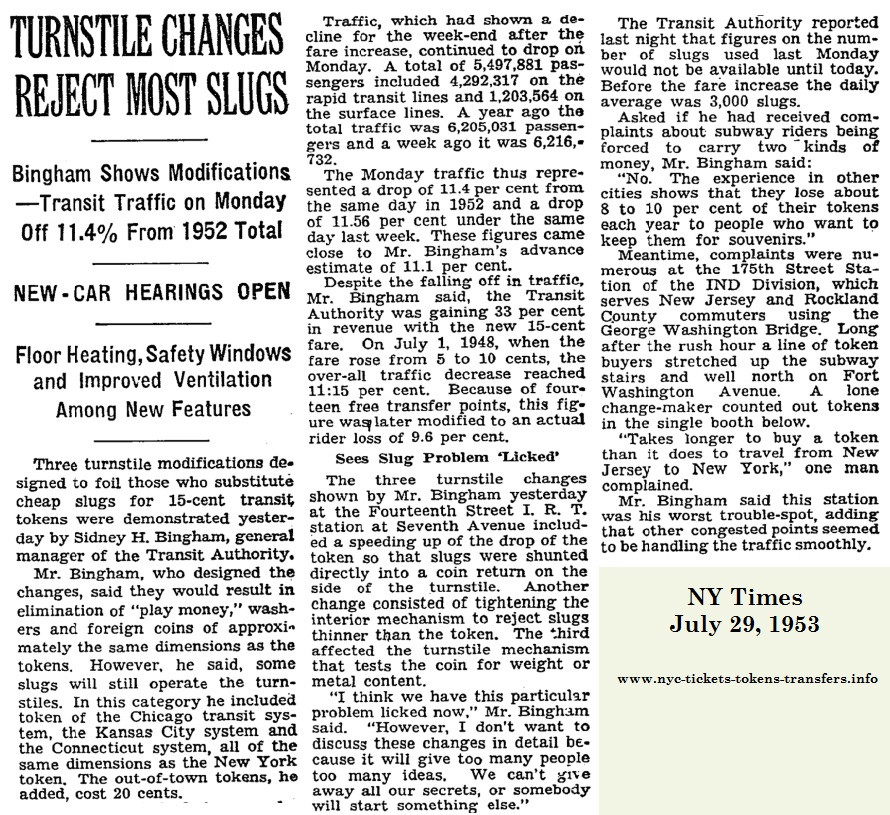 |
| New York Times - July 25, 1953 | New York Times - July 29, 1953 |
A synopsis of this situation reads as thus: the announced fare hike which had been discussed most of 1953, was scheduled for Saturday, July 25. However, NYCTA had not yet been given authority to do so, despite all the back and forth between the Transit Agency, the Mayor and the Governor.
The NYCTA, and rightfully so; did not wish to repeat the mistake of the IRT some twenty-five years before, where the IRT had minted 10,000,000 pieces of their proposed 7 cent tokens, only to have the proposed fare raise rejected by the Public Service Commission. This of course, led to the IRT storing the hundreds of bags of now useless tokens. Ironically, the IRT tokens are mentioned in one of the New York Times articles above. So, the NYCTA wisely held off on ordering their tokens until the last possible moment.
Now in a rush, on or about June 3, the NYCTA approached the US Mint to strike the tokens, but their request was rejected. The Mint did not want to put itself in the private token / coinage market, and while the Mint even accepted production of some foreign government coin issues as goodwill per request of the State Department, the line was drawn at not producing private issues. When this rejection took place, there was quite expectedly a bit of concern on the part of NYCTA. Governor Thomas Dewey (New York), got involved to intercede on the NYCTA's behalf with the US Mint, but his ministrations were refused as well. As such, the NYCTA then ran to the Canadian Mint on or about June 4, and of whom also turned down the NYCTA.
By this time, June 7; the NYCTA was in full blown panic mode. It needed the 15 cent fare hike to help make it solvent, but the turnstile mechanisms already installed could not accept two coins. And leaving the fare at 10 defeated the purpose of the fare hike. The fare had to go to 15 cents and tokens had to be the medium used. The NYCTA publicly solicited bids from the private manufacturers. The three token manufacturers that responded were: Scovill Manufacturing, Osborne Coinage, and Meyer & Wenthe. All three came to the conclusion they while they could supply the tokens to the NYCTA; not enough tokens could be produced by July 25 to the design as specified by the TA - ergo, the "Small Y cutout."
However, they suggested; if the NYCTA was willing to accept the first batches of tokens as solid tokens and not cut-out tokens (which required the extra steps of orienting and punching the token after being initially struck with the basic design). With the combined efforts of the production lines of the three private manufacturers, they could produce enough of the solid style tokens by July 24, to give the NYCTA sufficient stock in regard to their 15 cent fare raise and the introduction of a token issue to control it.
From the July 23 New York Times article, the production quantity of the small solid Y tokens was to be 5,000,000.
The token manufacturers further stated the two types of tokens would be compatible with each other in regards to the token mechanisms in the turnstiles. Furthermore, as the production resources of all three manufacturers would be needed, the bidding contract would need to be written to allow for a split up of the manufacturing quantities.
The NYCTA, pretty much with its back against the wall; agreed to all suggestions and stipulations; and on June 17 it signed the contracts, with the following noted:
| contract | quantity ordered | cost |
| Scovill Manufacturing | 7,000,000 | $11.65 per 1,000 |
| Meyer & Wenth | 7,000,000 | $12.37 per 1,000 |
| Osborne Coinage | 6,000,000 | $11.90 per 1,000 |
| totals: | 20,000,000 | $239,540 |
Three bids were rejected, which ranged from $13.00 to $35.00 per $1,000. Also, the option for 30,000,000 additional tokens may be ordered after July 30.
Again, according to the July 23 New York Times article; 5,000,000 small solid Y tokens were struck and distributed first to ensure a minimum supply to the NYCTA. Thus, the three token manufacturers set about to produce them. So the first tokens delivered to and released by the NYCTA were not the "Small Y Cut out" as originally planned, announced (and stated currently by the Transit Museum); but in fact the "Small Solid" token was first.
Subsequent production of tokens would conform to the TA's original design of the "Small Y cutout" and deliveries would continue after July 25, with final delivery taking place in September 24. On this date and the solid tokens withdrawn from service after this date.
On July 25th, the following statistics were announced:
17,290,000 tokens had been delivered as of the evening of July 24, with
2,349,349 tokens sold in 48 hours, with
4,484,000 disbursed to IND token booths,
5,302,000 disbursed to IRT token booths and
3,075,000 disbursed to BMT token booths.4,000,000 tokens were kept in reserve and
41,500,000 total tokens expected by September 24, 1953.
Also learned from this article, was that the tokens were not intended to be accepted on surface transit (streetcars and buses) - it was to be for rapid transit (subways & elevateds) use only! Buses were to remain coin only until decided otherwise. However, some riders accidentally dropped tokens and they were accepted as payment in good faith albeit with a polite admonishment. Tokens on buses would not be officially accepted until May 18, 1963 - almost ten years later.
On July 27th, it was announced that 20,000,000 more tokens were to be delivered that day, with 13,500,000 tokens distributed and 3,700,000 held in reserve. It was also announced in this article that Woolworth's had voluntarily pulled the play money from their store shelves in the New York City area (but an injunction had been drafted in case they refused).
It was also stated that Mr. Bingham had stayed up all the previous night positioned by a turnstile "in his shirt sleeves" at the 14th Street and Seventh Avenue Station station workshop, adjusting and readjusting the mechanism until it could reject the play money reliably. This accomplishment took place at 2 pm. It should also be noted that Mr. Bingham was no stranger to the innards of a turnstile - his uncle was Frank Hedley (President of the IRT), who with assistant James S. Doyle; had patented the first turnstile design for use in New York City in 1921!
This article (for better or worse) also lists the diameter dimensions for both the token and the play money: .650" for the token and .630" for play money, with the original rejection setting at .600" or less. Now the rejection setting was approximately between the two at .640" +/-. This would reject the play coins, but allow the new tokens to work. The play coins were also thinner than the tokens, allowing for another dimension to discriminate. As I was sitting here and typing this, I just had to break out my micrometer: .648 on the Solid and .647 on the Y Cutout. I just had to make sure they were right!
With this magic number now known, NYCTA turnstile technicians spread out throughout the system to adjust the other 2,466 turnstile mechanisms. Also, with sufficient quantities of tokens in TA possession, bags of 1000 tokens were now being sold to banks, cigar and cigarette stands, newsstands and other businesses for added convenience to sell to transit users.
On July 28th it was reported that 120,000 tokens had been sold to the following companies for resale: Guaranty Trust of New York, New York Savings Bank, Dun & Bradstreet, New York Telephone, Western Union Telegraph, Abraham & Straus, the US Army and US Navy, as well as independently owned newsstands.
On July 30th it was reported that 21,650,000 tokens had been delivered, 13,888,000 distributed and 7,762,000 held in reserve. 170,000 tokens have been sold to banks, businesses and other concerns for resale to customers. As a result, the token "rationing" of five per person was relaxed somewhat, and was now increased to 10 tokens per person, enough for a work week (2 trips per day multiplied by 5 days). Also 4,364 "spurious" coinage (foreign coins, slugs, washers and fake tokens) were collected, but this number was expected to diminish since the recalibration of token discriminators two days prior.
On July 31st, the first arrest of "turnstile cheating" took place: Rafael V. Rivera, 27; of East 109th Street was caught trying to use a Chicago Transit Authority token in a turnstile located at the 125th Street Station on the IRT Lenox Avenue Line. Arrests after this date also increased of people either trying to use slugs or for the outright mass manufacturing of counterfeit tokens (January 20 and 21, 1954).
When sufficient quantities of the "small Y cutout" tokens were finally produced (which was the intended design to be placed into circulation) they were shipped to NYCTA for distribution to token booths, and entered into circulation. Final delivery of the small tokens were scheduled for September 24. So, as the token clerks emptied the turnstiles, the solid design of tokens were pulled from circulation.
It retrospect, it seems duplicitous and a waste of both resources and financial investment for a short lived token issue; but rest assured, this is what took place.
The questions that now remain are:
| 1) | Were the 16.5mm solid tokens shipped back to the manufacturer and struck to have the Y removed or were they simply scrapped? |
| 2) | Why not just leave the 16.5mm solid in circulation? |
|
Authors note:
Despite these articles being in the public domain for decades (either physically in print in the New York Times archives and now digitally), it is left to wonder why exonumists, transit historians, not to mention the NYCTA themselves and the Transit Museum have not found and published this information before. It has been under out collective noses all along. Irregardless, we now have our answers. As to why the Transit Authority / Transit Museum hides this and does not publicly acknowledge this history of the small solid token as being first, leaves us to wonder. Is it due to a perceived embarrassment? The first of many examples of agency blundering? It is up to the NYCTA / NYTM to answer, and answer it they should; because the small solid Y token has its rightful place in the history and chronology of NYCTA transit tokens. But it has been and continues to treated like the unwanted step-child with no acknowledgment in Transit Museum displays or posts:
Temporary or permanent, it was not an unused pattern, or a prototype. Or an error. Its design was intentional, and its production rescued the NYCTA in its earliest days, and it circulated in the hands of many transit users. Therefore the small solid token should be acknowledged as such, along with its subsequent cousins. |
.
In regards to other tokens issues by the New York City Transit Authority:
Fare hike = new token designs? Nope! Tokens purchased and stored - sometimes for years? Yup!
Another item that needs to be clarified, is that the date a new token design was released does not always correspond to the date of rise in fare. Case in point: the Bulls-eye Token. The fare hike to $1.00 took place on January 1, 1986, but the Bulls-eye Token was not released until April 21. Unfortunately, several websites, historical societies and blogs correlate the new token design with the fare hike. This is incorrect, and not always the case.
Furthermore, the NYCTA would purchase a new token design, but not necessary release it. Sometimes, and in the case of the "Large Solid" token, it would be stored for nine years. The NYCTA purchased the "Large Solid" design of token around 1970 for the next intended fare hike. When the NYCTA announced the rise in fare to 35 cents to take place on January 1, 1972, the NYCTA also announced that on that date of the fare raise, new tokens would replace the old models. This was done to prevent hoarding - where people bought up the older tokens in large quantities at the lower price to use after the fare hike and save on the difference. The NYCTA even released photos of the new token design to the newspapers. Since the NYCTA said it was going to change the tokens, people did not buy them up and hoard them, but the day before the fare raise, the NYCTA now "announced" it would NOT be changing the tokens, and in all essence pulled "a bluff" on the transit users; and the "old" Large Y Cutout token remained in service.
Lapse forward to 1975, and the NYCTA announces the next fare hike to 50 cents, and states this time the tokens will
be changed. And for the second time, the NYCTA announces at the
last minutes before September 2, 1975; that it will not be replacing
the current token in service . Fool me once, shame on you; fool me
twice, shame on... wait; there is no shame when it comes to the NYCTA!
I think it is
highly doubtful they could have pulled that bluff off for a third time;
nor did they even try. On June
28, 1980, and for the fare raise to 60 cents, the NYCTA finally issued
the "Large Solid" token and retired the "Large Y Cutout" token from
service.
| Quite unfortunately; misrepresentation and misinformation
abounds with the sales of so-called "complete sets" of five, six or seven NYCTA tokens
as seen on internet sales sites. No doubt, these were put together by misinformed and / or overenthusiastic and unscrupulous sellers. There are in fact eleven token issues for a basic set: nine Regular Fare and two Special Fare, as will be seen in the catalog below. There always have been and always will be. Even if one was to exclude the Special Fare Tokens (and I do not know why one would - they were available for purchase to the general public, albeit at limited locations), there still remains nine token designs released for standard fare, not five, six or seven. Furthermore, you could assemble a set of six tokens individually and for a lower cost than by purchasing the so called "sets", but keep in mind, it still would not be a complete set. If one were to include die and font varieties that exist for a some of
those token designs; you now have
yourself at least twenty-two tokens to aim for in acquiring a "true" complete
set of tokens for the NYCTA. Either way, there are 11 tokens for a basic set or 22 tokens for die variety set. In short: future buyers interested in purchasing so called "complete sets" of 5, 6 or 7 tokens, beware! |
|
The following image IS of a complete basic type set. It represents each token used by the NYCTA through it's history from 1953 to 2003. While it does not include die varieties (very minor differences in the basic token design such as: period placement; interpunct (dot) size and placement; double spaces; and / or font style), and when tokens were struck by different manufacturers.
Please note: the tokens shown here are shown at actual size at 100% zoom on computer screens.

Authors note: The Atwood-Coffee catalog, (at least in my opinion - PMG) makes a glaring error in the categorization of the NYCTA token issues: they are attributed to the Borough of Manhattan (NY630 series), when the New York City Transit Authority headquarters was in fact located in Brooklyn! Specifically, it was located at 370 Jay Street.
This building was also the location of their very highly secure Office of Revenue and its associated vaults where the fare proceeds were brought to be accounted, and then transferred to the respective banks. These vaults also contained the token issues for that period and stored the issues no longer being used.
So, in all practicality, the NYCTA token issues should be attributed in the catalog to the Borough of Brooklyn, (NY629 series) and not Manhattan (NY630 series).
Before we progress to the visually rewarding images of the tokens, a few clarifications need to be made.Now it can be safely said, we can progress to the visually rewarding aspect of this catalog - the token images!
| Overview | The Atwood-Coffee Catalog | |||
|
|
||||
| 19th Century Issues - 1827 to 1900 | ||||
|
|
||||
| 20th Century Issues - 1900 to 1940 | ||||
| Bronx | Brooklyn | Manhattan | Queens | Staten Island |
|
|
||||
| First Unification "NYCTS" - City Wide Issues - 1940-1953 | ||||
|
|
||||
| Second Unification "NYCTA" - City Wide Issues - 1953 - 2003 |
||||
| Why a token? Coins vs. Token | ||||
| July 25, 1953: Will the real first token please stand up.. | July 27, 1953 - Jay Street? We have a problem. | |||
| Not complete sets. And a REAL complete set | ||||
|
|
||||
| Token Dispensers | Rolls & "Ten Paks" | |||
|
|
||||
| Errors | Die Set Up | Patterns | Proofs | Counterfeits & Slugs |
|
|
||||
| Token Manufacturing Processes of NYCTA tokens | ||||
|
|
||||
| Scanning Electron
Microscope / Wavelength Dispersive Spectroscopy testing to determine
composition of the NYCTA 5 Borough - Pentagon Token |
||||
.
Second Unification; New York City Transit Authority Tokens - 1953 - 2003
The colloquial name used by collectors is in quotation marks above the issue.
| Please note: token images below are shown at 200% for detail. |
| obverse | reverse | notes | ||
| "Small Solid" or "Dime Sized Solid" This was the first token issued by the NYCTA. |
16.5mm solids were used from July 25, 1953 to September 1953, 15¢ for rapid transit use only (no streetcars or buses) with the 16.5mm Y cutout (below) introduced mid-September 1953 when the above publicity image was distributed. These solid tokens were removed from use soon thereafter. brass, solid diameter: 16.5mm / .650", thickness: 1.19mm / .046", weight: 1.839g design: Louis A. Schineller (NYCTA) Scovill Manufacturing; Roger Williams Mint; Meyer & Wenthe total struck (solid): 5,000,000 Atwood-Coffee NY630AN with four die varieties: N630ANa, 630ANb, 630ANc, 630ANd lack of, or sizes of dots on obverse and reverse rare; $25.00 |
|||

|
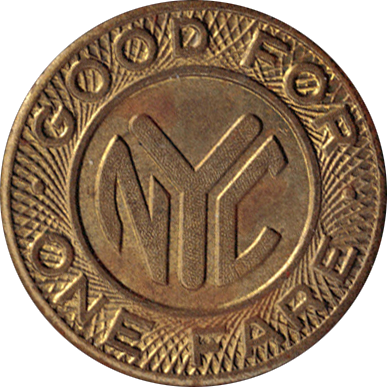
|
|||
|
|
||||
| "Small Y Cutout" This was NOT the first token issued by the NYCTA. It is the second, but was the original design as ordered. |
September 1953 - July 5, 1966: 15¢ (rapid transit use only - see note below) May 18, 1963 - July 5, 1966: 15¢ (rapid transit and buses) July 5, 1966 - January 3, 1970: 20¢ for rapid transit use only (no streetcars or buses) until May 18, 1963 Acceptance on NYCTA buses effective May 18, 1963. Used for children's admission to Transit Museum post-1970 brass, Y cutout (aligned) diameter: 16.5mm / .650", thickness: 1.19mm / .046", 1.775g design: Louis A. Schineller (NYCTA) Scovill Manufacturing; Osborne Coinage; Meyer & Wenthe total struck (solid & Y cutout varieties): 41,500,000 Atwood-Coffee NY630AO with five die varieties: 630AOa, 630AOb, 630AOc, 630AOd, 630AOe lack of, or sizes of dots on obverse and reverse extremely common; $1.00 in minimally circulated condition |
|||
 |
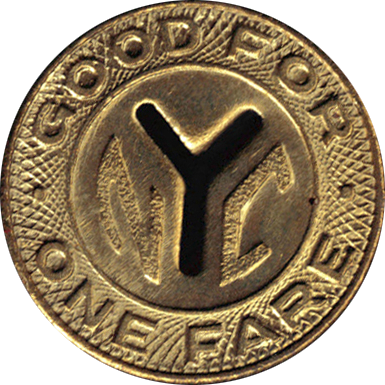 |
|||
|
|
||||
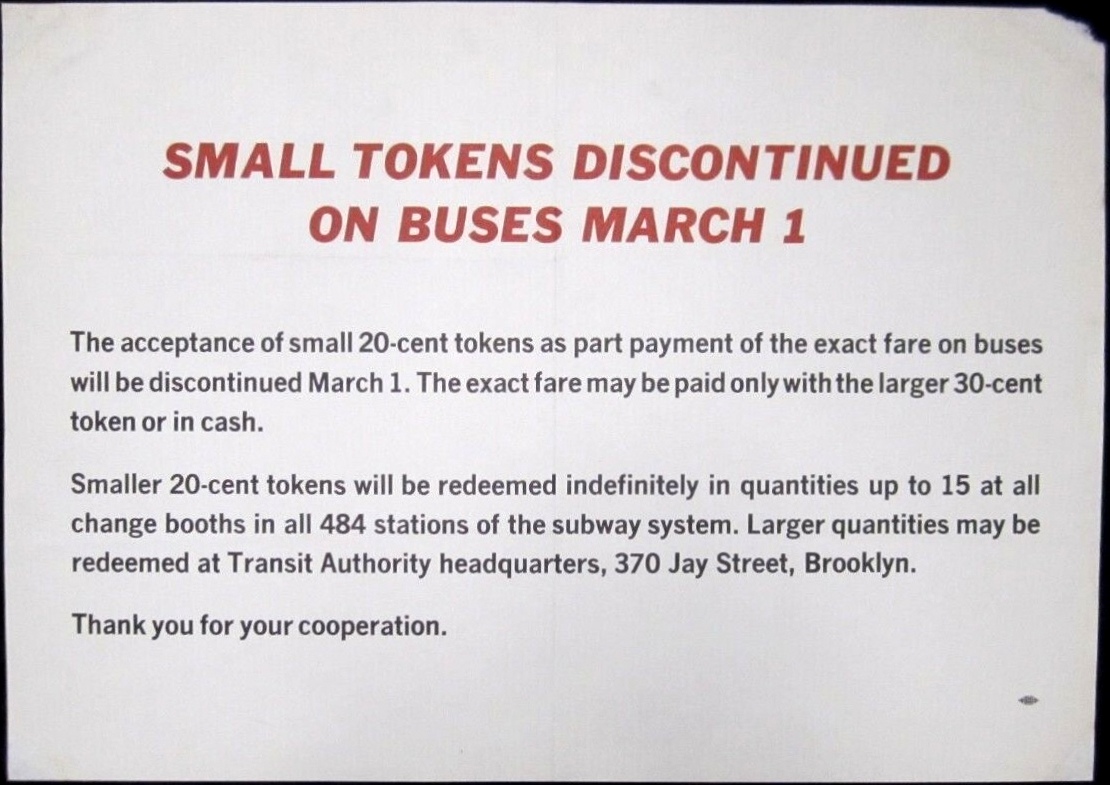 1970 |
||||
|
|
||||
|
||||
| "Large Y Cutout" | January 4,
1970 - December 31, 1971: 30¢ January 1, 1972 - August 31, 1975: 35¢ September 2, 1975 - June 27, 1980: 50¢ brass, Y cutout (aligned) diameter: 23mm /.90", thickess: 1.69mm / .066", weight: 4.7g, Roger Williams Mint Atwood-Coffee NY630AS with four die varieties: thick oval font on reverse (shown) 630ASa; and thin round font on reverse with three different positions of mill marks: 630ASb, 630ASc, 630ASd There was discussion in reverting to the small Y Cutout token when the fare rose to 35¢, but this did not take place and this token remained in service. extremely common; $1.00 in minimally circulated condition |
|||
 |
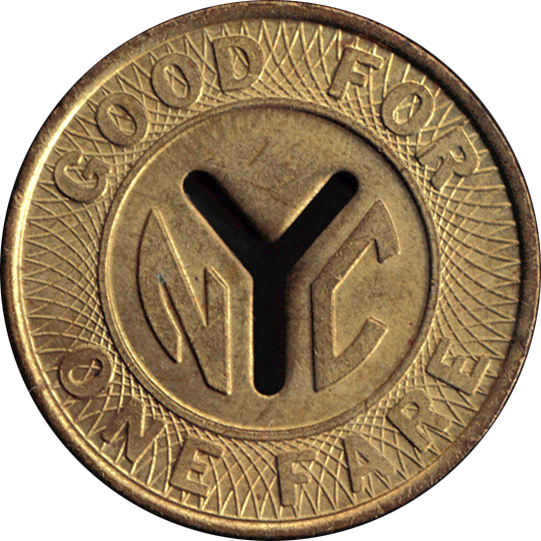 |
|||
|
|
||||
| To celebrate the 75th anniversary of the IRT;
the NYCTA, under the jurisdiction of the state controlled MTA, jointly
planned celebrations. William Bonell, a graphic designer from J.C.
Penney Co. was selected to design a commemorative token which was to
circulate concurrently with the then current 23mm Y-cut out issue.
Osborne Coinage of Cincinnati, Ohio struck ten million in brass for general circulation. The design includes a subway kiosk entrance on one side, and a rendering of the 1904 subway car on the other. A diamond cut-out at top radiates throughout the background in ever-larger dimensions. It is interesting to note that nowhere on the token does it say "Good for One Fare." An error is known with two subway car designs, and no kiosk design, but has not been verified. In addition to the regular strikes, 5,000 were struck in proof brass from polished dies and made available to the public from the NYCTA's revenue office at 370 Jay Street. An additional 10,000 pieces were struck in copper-nickel, but were never released, and are presumed destroyed. The Fifth Avenue Jewelry firm of H. Stern was licensed to have an edition of 250 (edge numbered) made in 14-karat gold. They also has a special NYC theme bezel available for an additional fee. (see further in Proofs chapter below) |
||||
|
|
||||
| "Diamond Jubilee" | Issued
in commemoration of 75th Anniversary / Diamond Jubilee of the opening of the first subway
in New York City in 1904. November 1, 1979 - June 27, 1980: 50¢ brass, with diamond punch hole at top center (aligned) 23mm / .90" diameter, thickness: 1.5mm / .059", weight: 4.73g; total struck: 10,000,000 Roger Williams Mint? Atwood-Coffee NY630AY with two varieties: diagonal lines in car body: NY630AYa, or lack of diagonal lines in car body: NY630AYb extremely common; $1.00 in minimally circulated condition |
|||
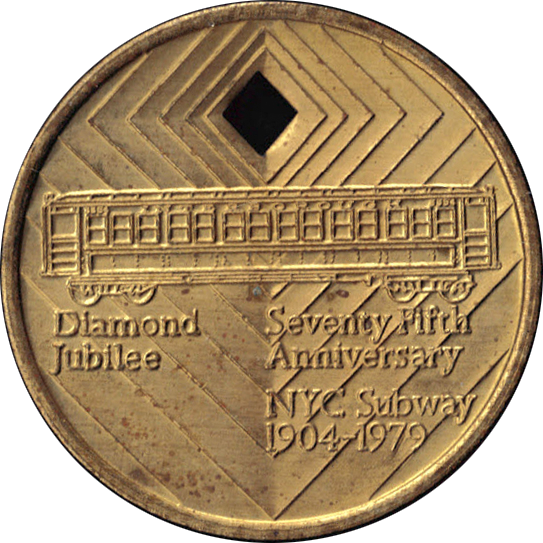 |
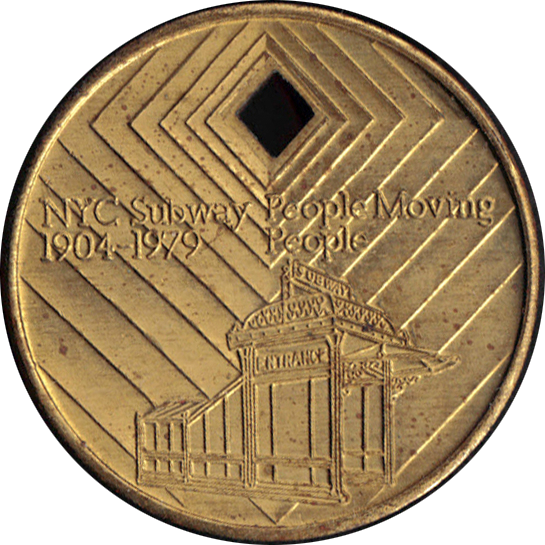 |
|||
|
|
||||
| The next token issued by the NYCTA is the "Large Solid". But while it was not issued until 1980; the tokens had been ordered around 1971
for the January 1, 1972 fare hike; and if necessary replace the
previous issue token (the "Large Y Cutout") in circulation due to
anticipated hoarding of lower cost tokens by transit users. To prevent
this from taking place, the NYCTA announced they would change the token
design to something different from the tokens already in use.
Obviously, this discouraged people from mass purchasing the token; i.e.: "why
buy it if they won't
be good anymore?" Images of the "new" tokens were even released to the press. As people did not hoard the tokens already in
circulation; the NYCTA stated at the last possible minute that
they would not change the token. So, in essence, the NYCTA bluffed the transit users! The "Large Solid" tokens were kept in storage for use at a later date. Ironically, the NYCTA pulled this "bluff" a second time for the announced fare hike on September 2, 1975 and yet again they announced a new token to replace the one in service. Once again at the last minute, there was no change in token - and the "Large Y Cutout" remained in circulation with the "Large Solid" being kept in storage. I think it is highly doubtful they could have pulled that bluff off for a third time; nor did they even try. For the fare hike on June 28, 1980; the "Large Solid" was finally released and the "Large Y Cutout" retired.
|
||||
| "Large Solid" | Possibly ordered as early as 1970 and stored for future use. It is first mentioned and shown in August 22, 1975 NYT article. June 28, 1980 - July 2, 1981: 60¢ July 3, 1981 - January 1, 1984: 75¢ January 2, 1984 - December 31, 1985: 90¢ January 1, 1986 - June 2,1986: $1.00 brass, solid diameter: 22.25mm /.875", thickness: , weight: 3.9g total struck: 50,000,000; 35,000,000 struck in 1970, additional 15,000,000 struck in 1980. Roger Williams Mint Atwood-Coffee NY630AT extremely common; $1.00 in minimally circulated condition |
|||
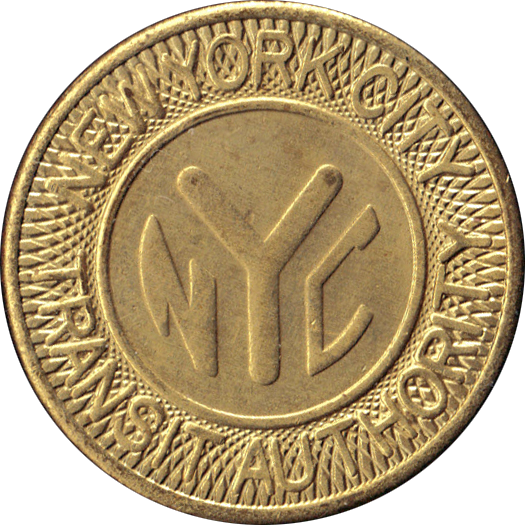 |
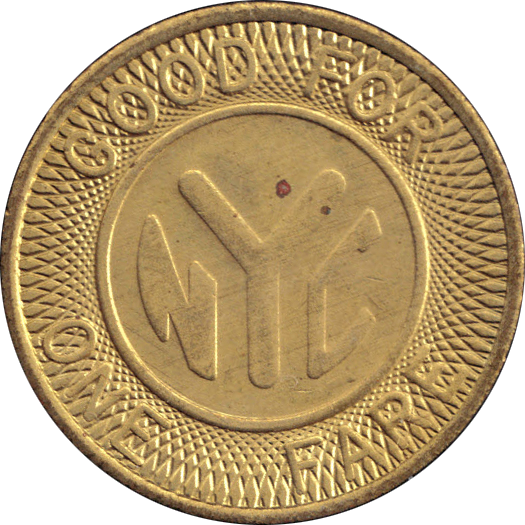 |
|||
|
|
||||
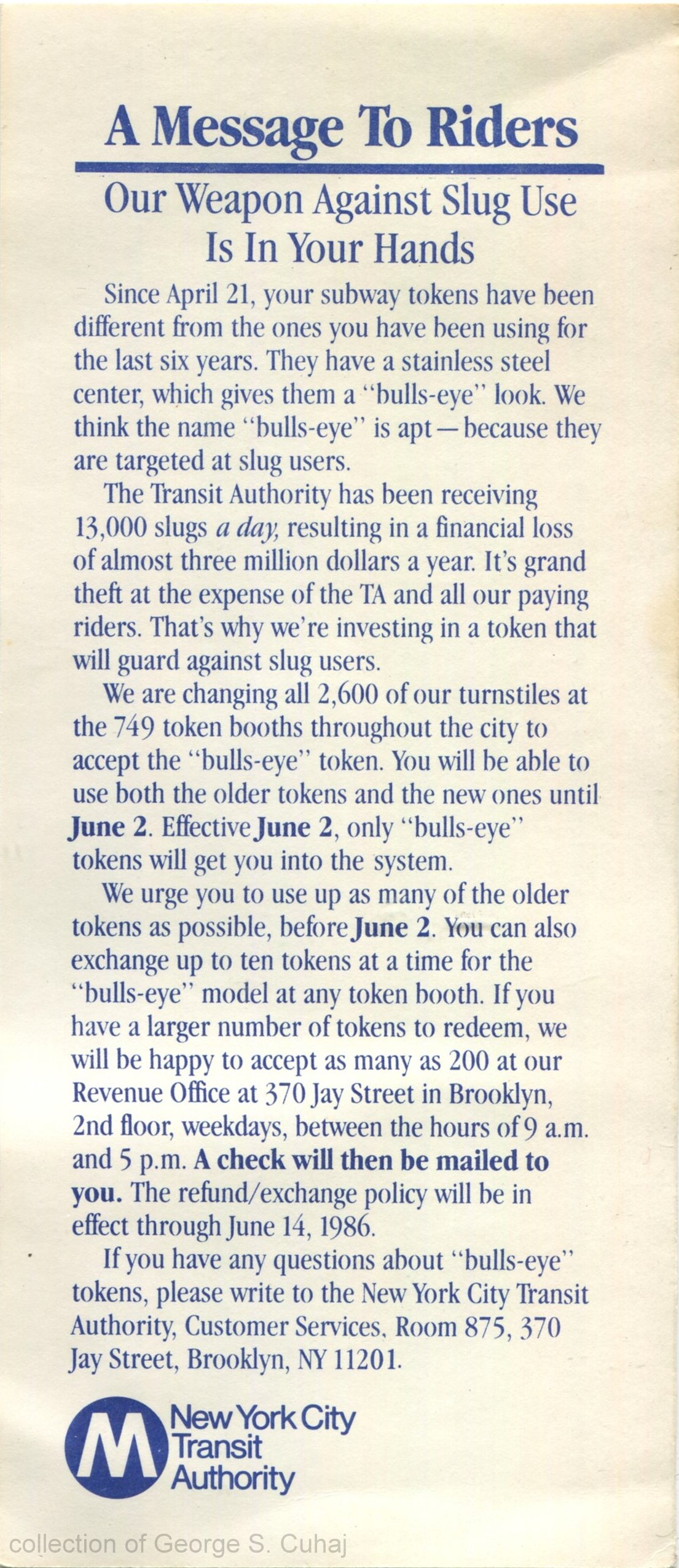 3 5/8" x 8 1/2" |
Many people missed the
first exchange period for the older Large Solid Y and Large Y Cutout
tokens to the new Bulls-eye Token, drawing a lot of ire. Therefore, the NYCTA held a second exchange period.
This subway car placard announces the second exchange period. 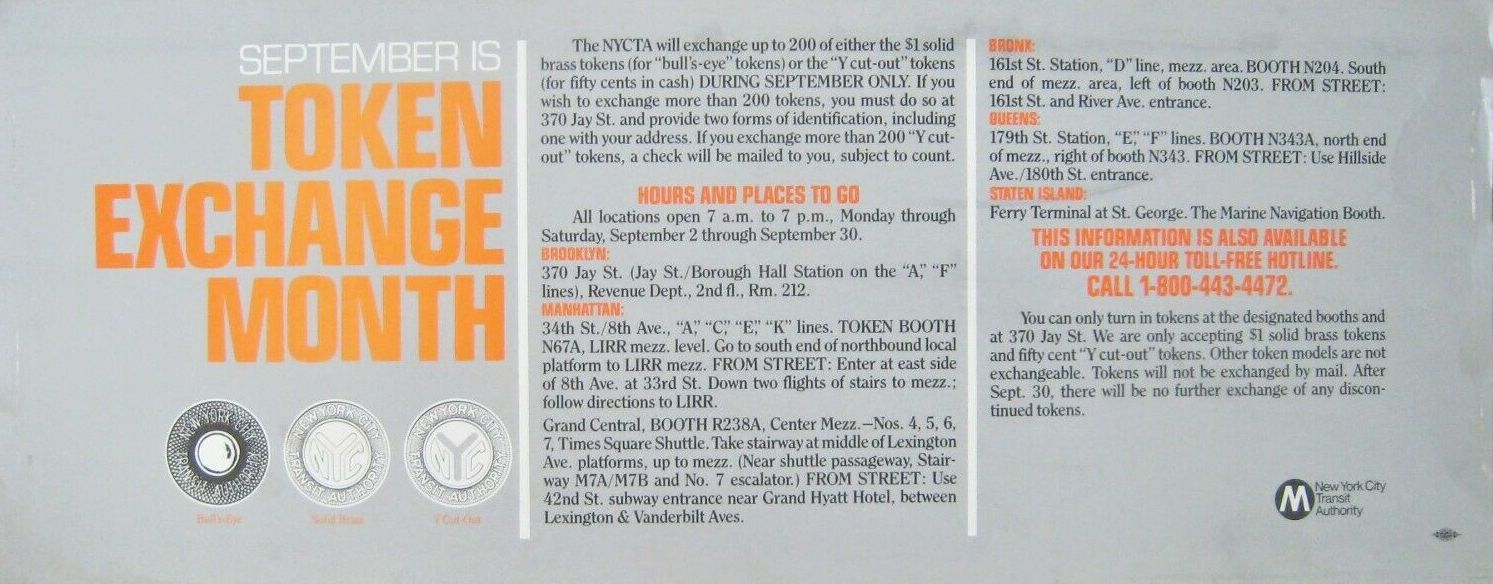 |
|||
| "SJD Bulls-eye" | with
initials SJD below between "D"
in "GOOD" and "F" in "FOR" initials stand for Sylvester J. Dobosz, assistant director of revenue. 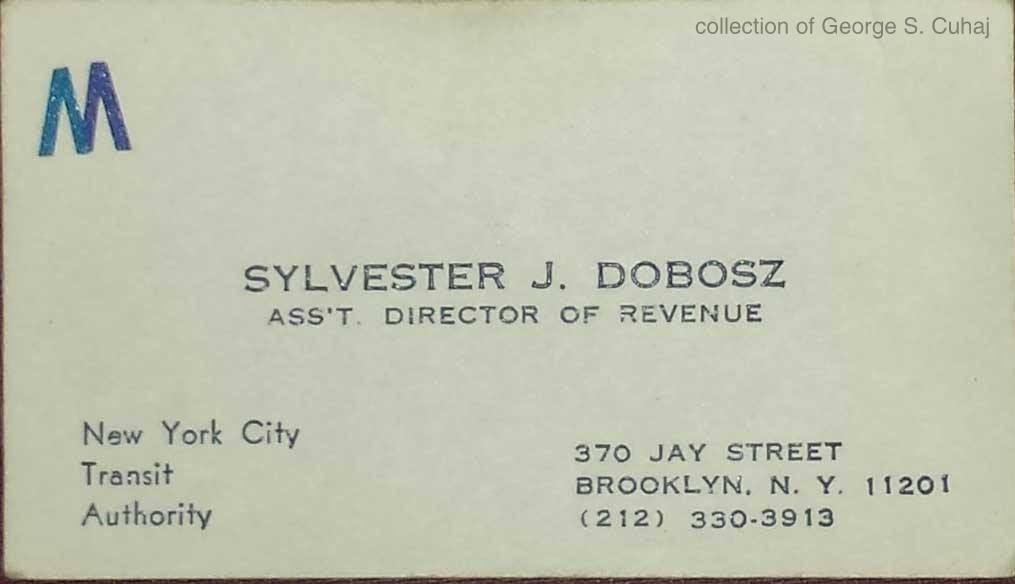 April 21, 1986 - December 31, 1989: $1.00 January 1, 1990 - December 31, 1992: $1.15 January 1, 1992 - November 11, 1995: $1.25 bimetallic: brass, with 8mm magnetic steel center diameter: 22mm / .873", thickness: 1.4mm / .055", weight: .382g total struck: 50,000,000 Roger Williams Mint Atwood-Coffee NY630BE extremely common; $2.00 in minimally circulated condition due to the lack of expertise in identifying the SJD, these are commonly mixed in with those tokens lacking the SJD initials |
|||
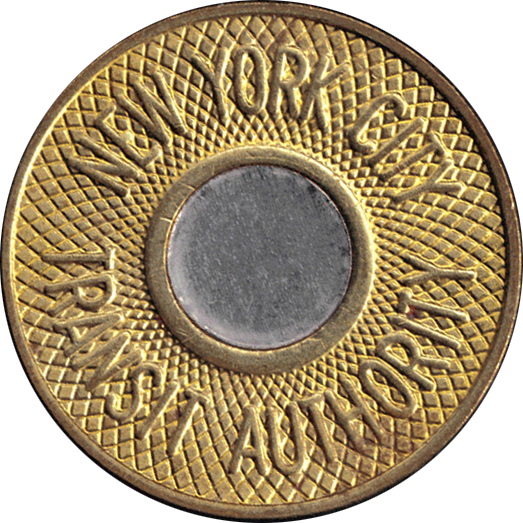 |
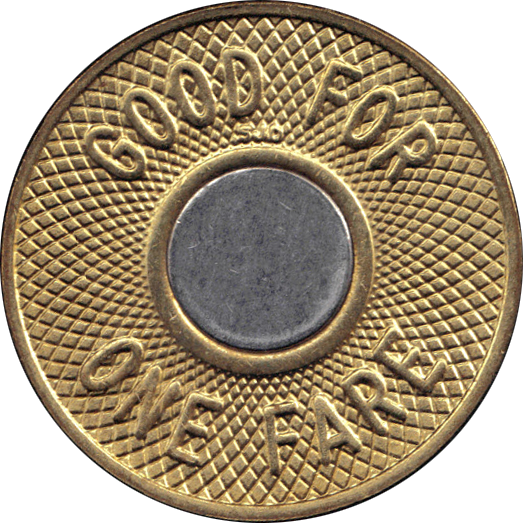 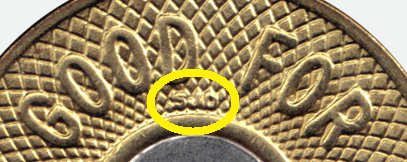 |
|||
| The inclusion of the SJD initials is an interesting story to say the least: "Before he retired, Dobosz managed to have his initials, “SJD,” included on newly minted subway tokens." One irrefutable and conclusive article in the March 9, 1992 issue of New York Magazine: "The investigative reporter Matthew Fenton covered his bases well. Undaunted by the stone wall that a big bureaucracy like the TA can be, he went from department to department trying to get to the bottom of the mystery. And get to the bottom, he did. His persistence led him to the “Revenue Office”, where the Assistant Chief admitted the existence of two different versions of the Bullseye. When pressed about the reason, Fenton was told to speak to his predecessor...”the man who ordered the tokens”, but “he’s retired”. When Fenton asked how he could track down the man, he was given a name: Sylvester J. Dobosz. Ummm...”SJD”? Well, you didn’t think he would drop the ball now, did you? The good reporter finds old Mr. SJD himself, living on a quiet, tree lined street in Queens. Apparently, in 1985, Dobosz was approaching the end of his 40 year career with The New York City Transit Authority, during which time he had worked his way up from token booth clerk to senior executive. But before he retired, Sylvester Joseph Dobosz called the Roger Williams Mint in Attleboro, Massachusetts and requested that they make one last change to the bullseye token’s design, instructing them to (Yep, you guessed it) add his initials to all 60 million tokens that had been ordered. In an interview setting, Dobosz himself proved to be a tough nut to crack. Initially he says what he did “was just a means of identification”. When questioned further, he insists it was “a way of distinguishing one minting from another...you know, to discourage counterfeiters”. When pressed about why he didn’t use one of the less obvious ways of distinguishing coin design, he finally acknowledges “my last hurrah...it was my last hurrah”. That, we can conclude, was his way of saying "The devil made me do it". When the powers that be at the NYCTA discovered the SJD initials, they were ordered removed from the dies (or new dies made?) and the remaining tokens of that order lack the SJD initials. |
||||
|
|
||||
| "Archer Avenue Bullseye" | Released
December 11, 1988 to
commemorate the opening of Archer Avenue Extension (IND and BMT). Circulated with above issue. Extremely limited quantity struck, the least of any NYCTA token issue. December 11, 1988 - December 31, 1989: $1.00 January 1, 1990 - December 31, 1992: $1.15 January 1, 1992 - November 11, 1995: $1.25 bimetallic: brass, with 8mm magnetic steel center diameter: 22mm / .873", thickness: 1.4mm / .055" weight: 3.77g total struck: 100,000 Roger Williams Mint? Atwood-Coffee NY630BG increasingly difficult to find due to lower production quantity and in better grades; $20.00 in minimally circulated condition |
|||
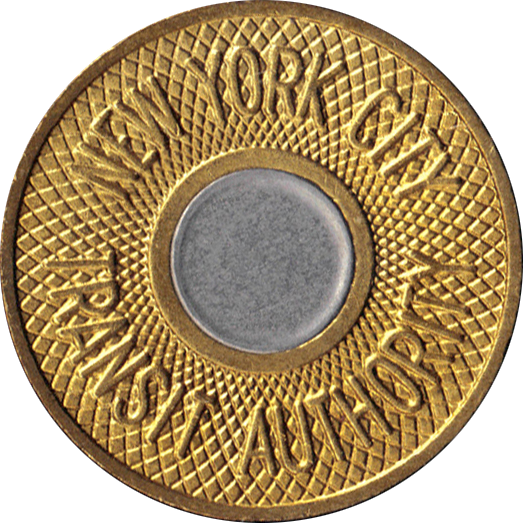 |
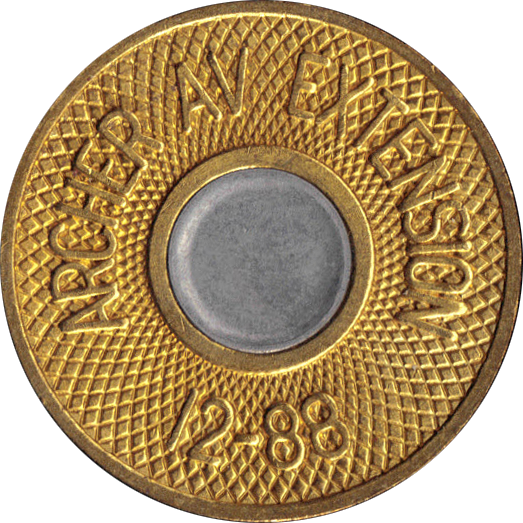 |
|||
|
|
||||
| "Plain Bulls-eye" | Plain - SJD initials removed from reverse Order was placed after the discovery of SJD initials and it is believed the NYCTA discovered the initials mid-1990, so these tokens did not circulate when the fare was lower. January 1, 1990 - December 31, 1992: $1.15 January 1, 1992 - November 11, 1995: $1.25 bimetallic: brass, with 8mm magnetic steel center diameter: 22mm / .873", thickness: 1.4mm / .055", weight: .382g total struck: 60,000,000 Roger Williams Mint Atwood-Coffee NY630BI extremely common; $1.00 in minimally circulated condition |
|||
 |
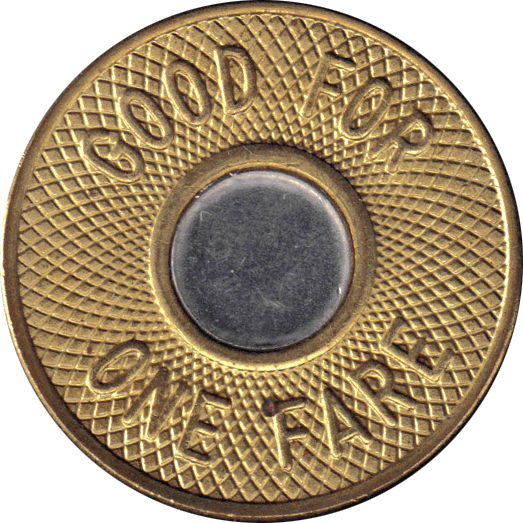 |
|||
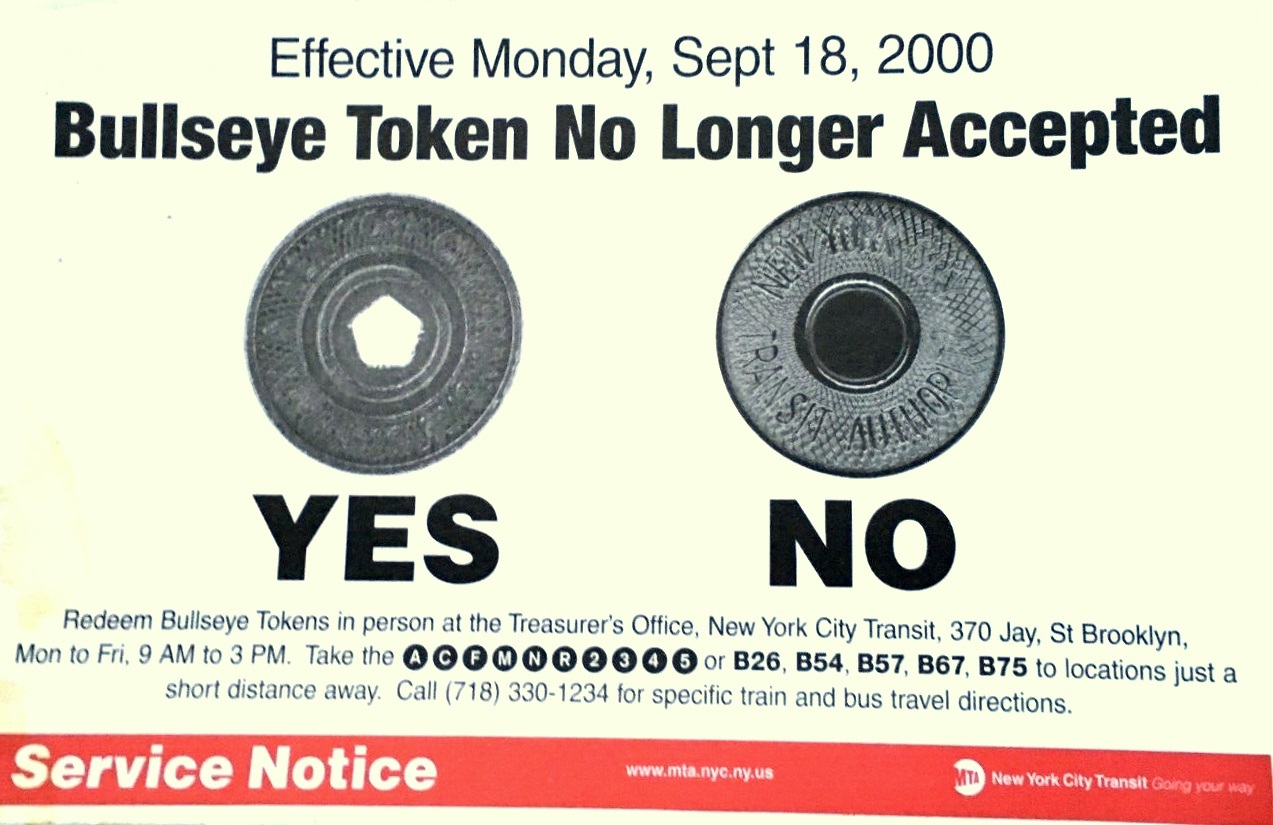 |
||||
|
|
||||
| "Five Borough" or "Pentagon Punchout" | Final issue of token. November 12, 1995 - May 3, 2003: $1.50 88/11 cupro-nickel (lightly magnetic) with pentagon shape punch hole (non-aligned) diameter: 20mm / .790", thickness: 1.4mm / .055", weight: 3.26g total struck: 60,000,000 Roger Williams Mint? Atwood-Coffee NY630BJ extremely common; $1.00 in minimally circulated condition Read about my scanning electron microscope testing here to determine the composition. |
|||
 |
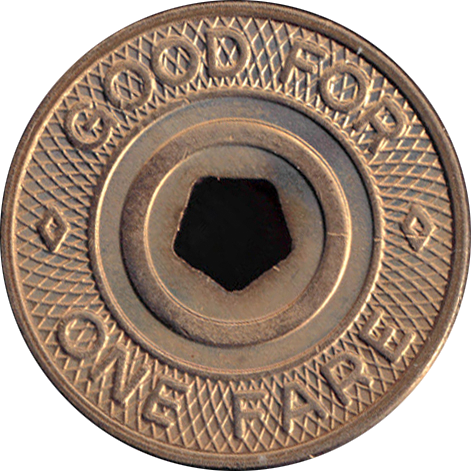 |
|||
|
|
||||
Discontinuance of the Five Borough Tokens proceeded in phases:
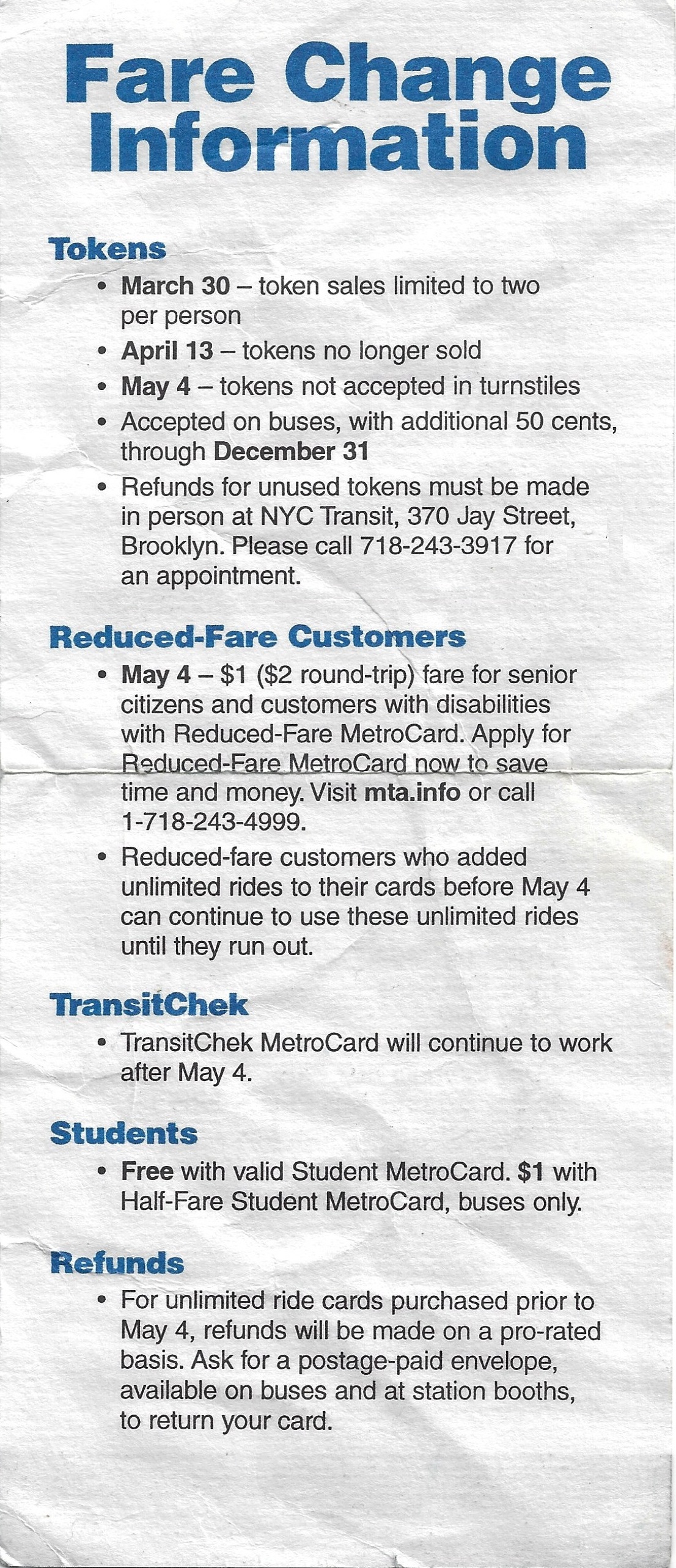 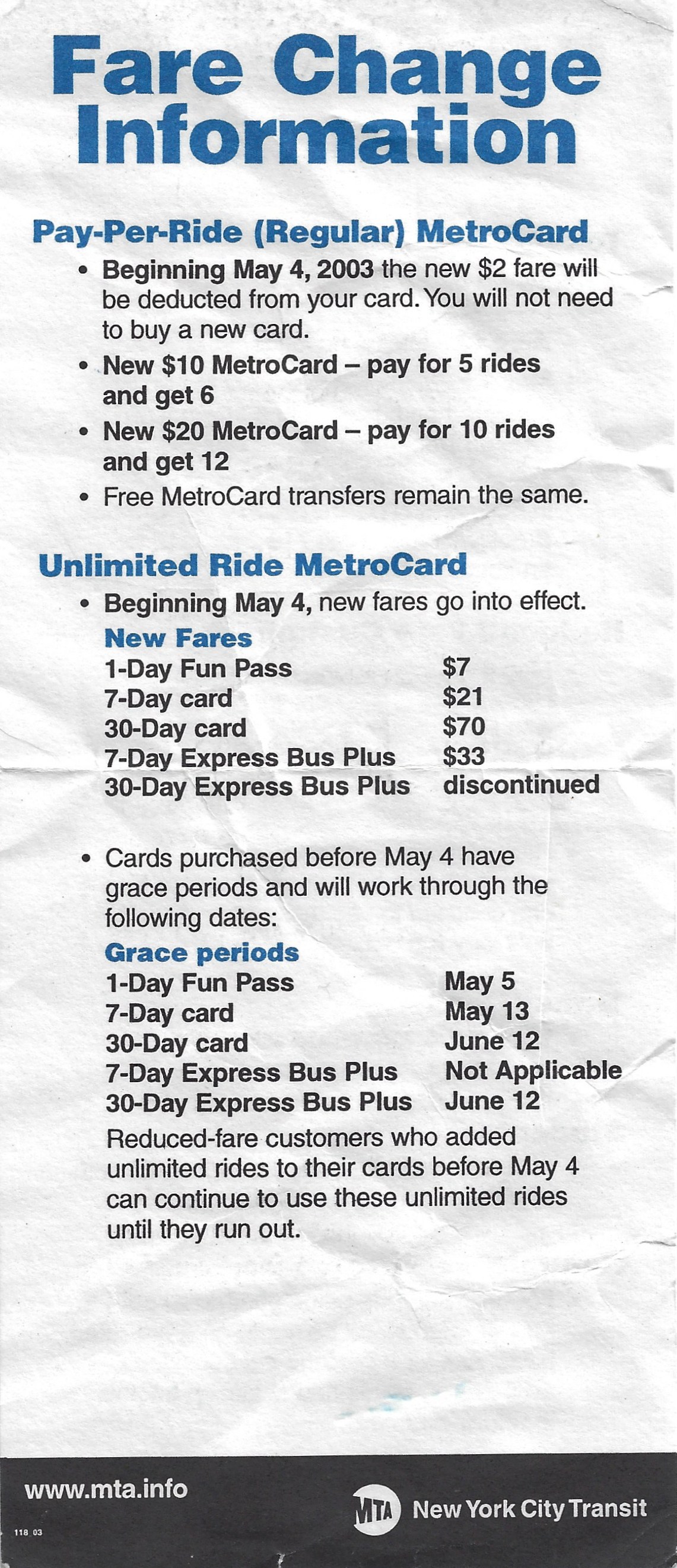 |
||||
|
|
||||
| "Extra Large Special Fare Y Cutout" or "Supersized Special Fare Y Cutout" | Issued as special fare token for train to Aqueduct Race Track
then repurposed for use for Express Buses late 1980's-1990's issued 1966 brass, Y cutout (aligned) diameter: 28.5mm / 1.125", thickness: 2mm / .079"; weight: 9.66g Atwood-Coffee NY630AP Roger Williams Mint uncommon; $15.00 |
|||
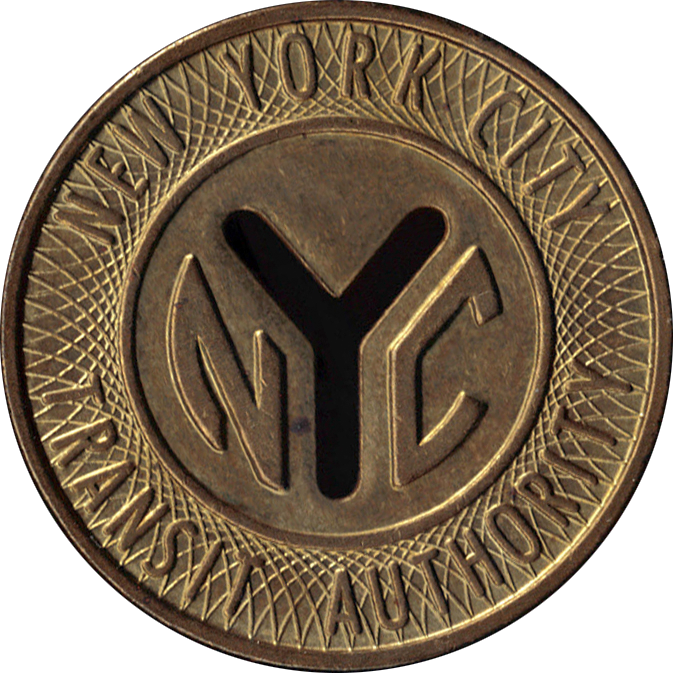 |
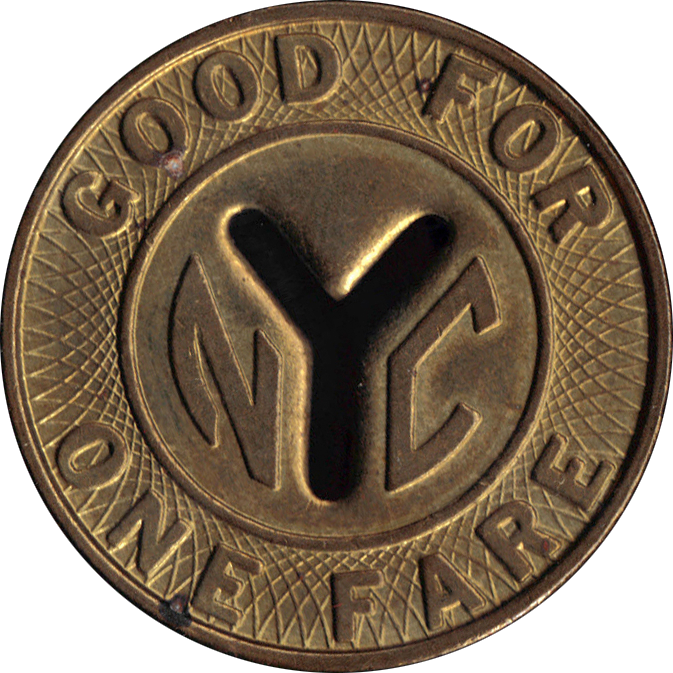 |
|||
|
|
||||
| "Special Fare" or "Silver Special Fare" | used as $5.00 special fare for train to Aqueduct Race Track. issued April 1979 white metal (non-magnetic), solid diamter: 23.5mm / .923", thickness: 1.5mm / .058"; weight: 4.37g total struck: 500,000 unknown - Roger Williams Mint? Atwood-Coffee NY630AX uncommon; $20.00 |
|||
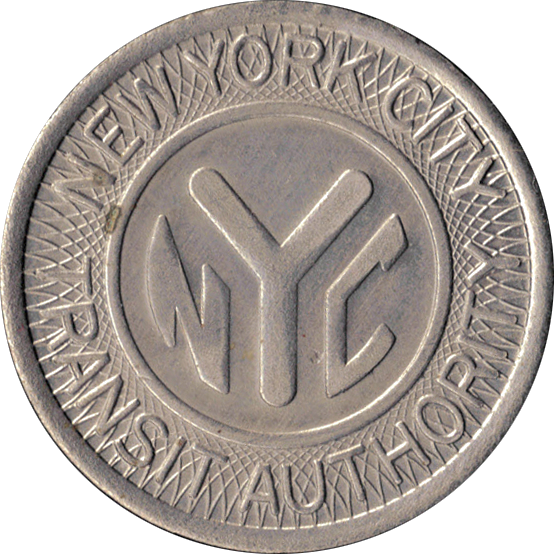 |
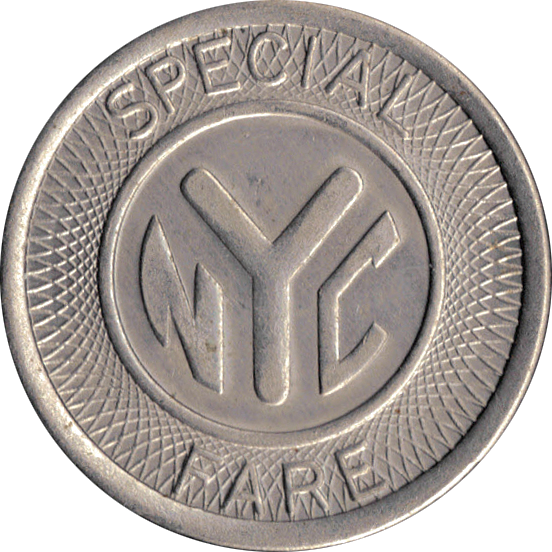 |
|||
| Overview | The Atwood-Coffee Catalog | |||
|
|
||||
| 19th Century Issues - 1827 to 1900 | ||||
|
|
||||
| 20th Century Issues - 1900 to 1940 | ||||
| Bronx | Brooklyn | Manhattan | Queens | Staten Island |
|
|
||||
| First Unification "NYCTS" - City Wide Issues - 1940-1953 | ||||
|
|
||||
| Second Unification "NYCTA" - City Wide Issues - 1953 - 2003 |
||||
| Why a token? Coins vs. Token | ||||
| July 25, 1953: Will the real first token please stand up.. | July 27, 1953 - Jay Street? We have a problem. | |||
| Not complete sets. And a REAL complete set | ||||
|
|
||||
| Token Dispensers | Rolls & "Ten Paks" | |||
|
|
||||
| Errors | Die Set Up | Patterns | Proofs | Counterfeits & Slugs |
|
|
||||
| Token Manufacturing Processes of NYCTA tokens | ||||
|
|
||||
| Scanning Electron
Microscope / Wavelength Dispersive Spectroscopy testing to determine
composition of the NYCTA 5 Borough - Pentagon Token |
||||
Tokens were not only sold via the manned token booths, but also through bank tellers and department stores for customer convenience.
At some rapid transit stations, coin operated token machines also saw use during unmanned and rush hours:
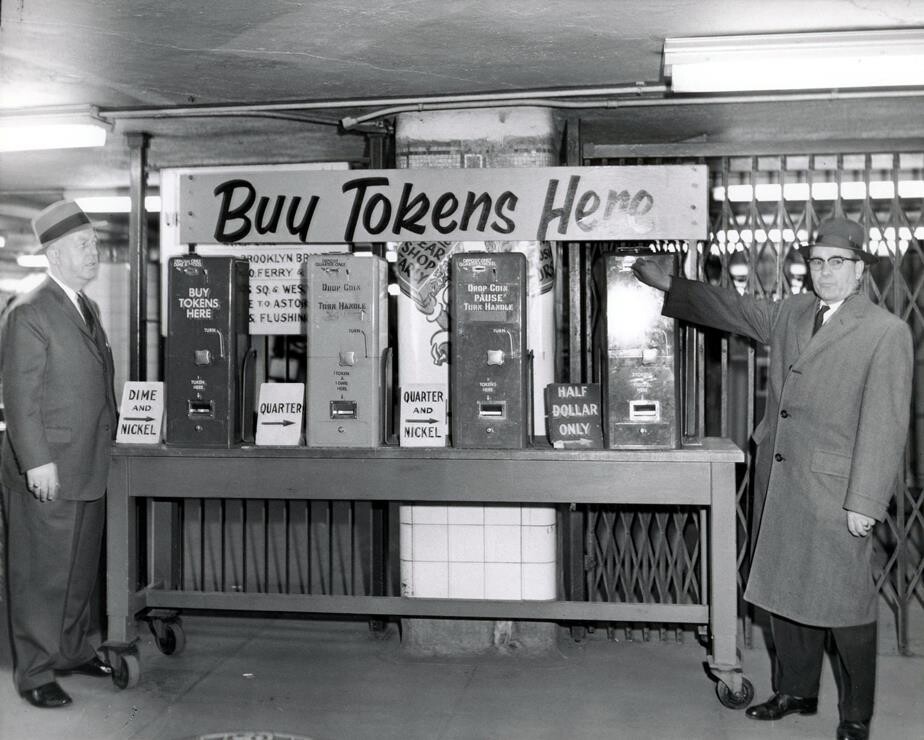 This particular image is of particular importance: note the machine far right: "Half Dollar Only". It is equipped to accept half dollar pieces, which means at one point, the TA accepted half dollars as a method of payment! |
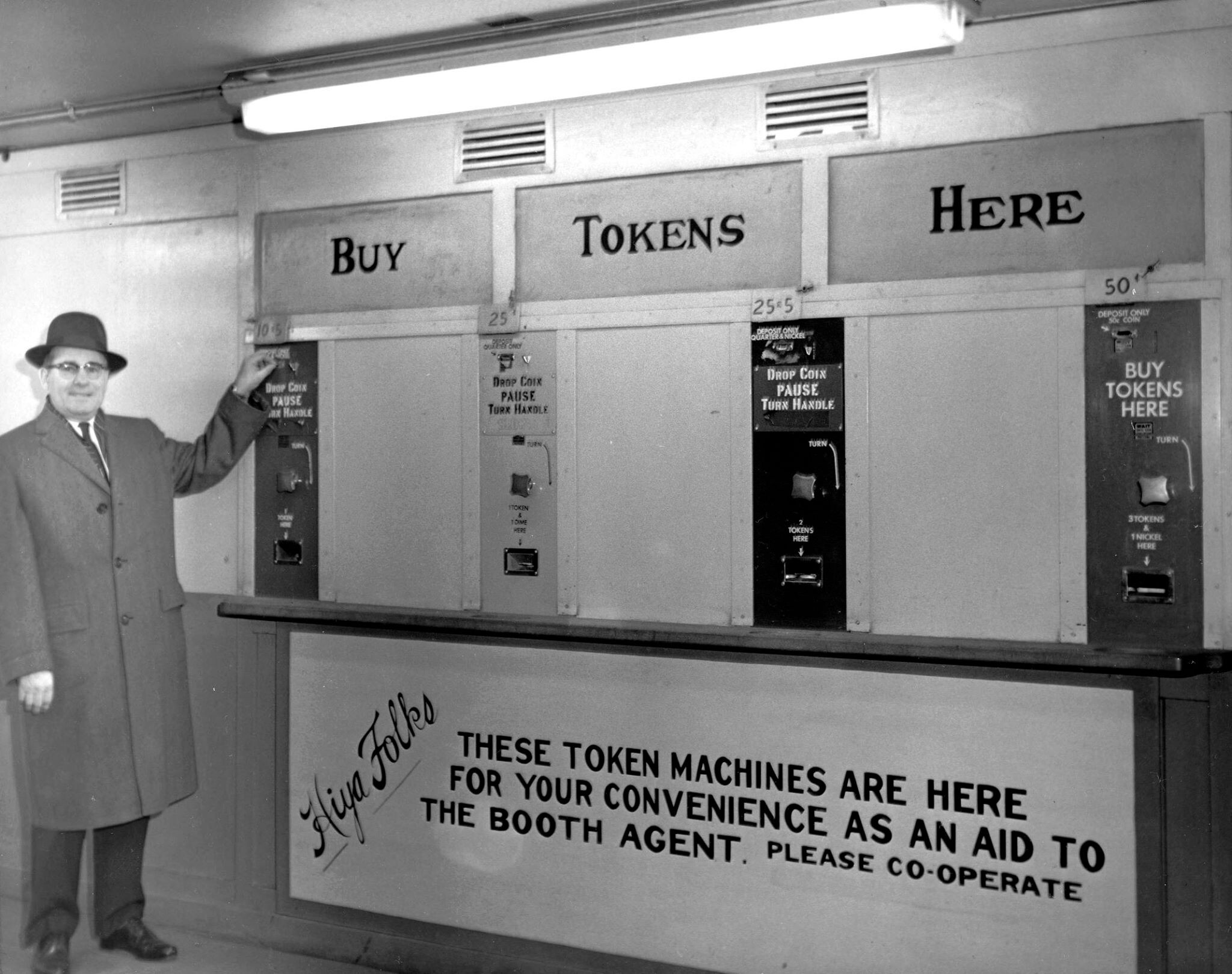 Also of particular note, is the fact that these dispensers were able to make change: note the slot on bottom of the 25¢ machine (second from left): "2 TOKENS tokens & 1 DIME", or on the 50¢ machine (far right): "3 TOKENS & 1 NICKEL". This leaves us to wonder, if technology had progressed to this point where the token dispensers could take mixed coinage, why couldn't the turnstiles? |
|
Also, take note of the instructions on the machines: drop coin -
PAUSE- Then turn handle. The mechanical mechanism neededa small period of time to discriminate the coins vs a slug. This small delay is why the mechanisms were not conducive to direct turnstile use - it would have cause an exponentially increasing delay at the turnstiles. |
|
| . . |
|
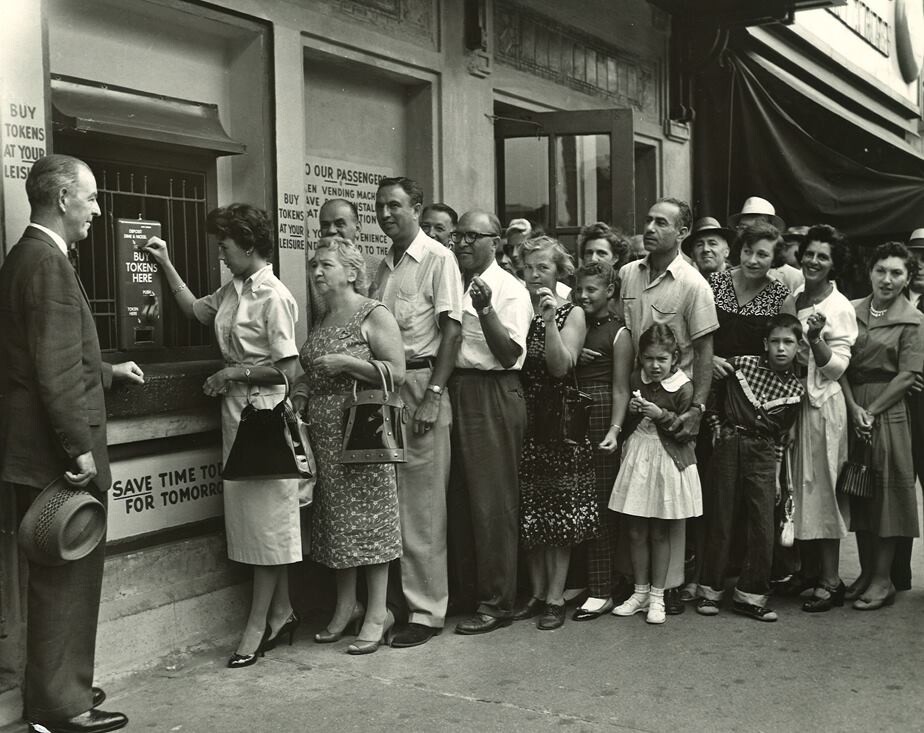 People line up to try one of the new dispensers. |
|
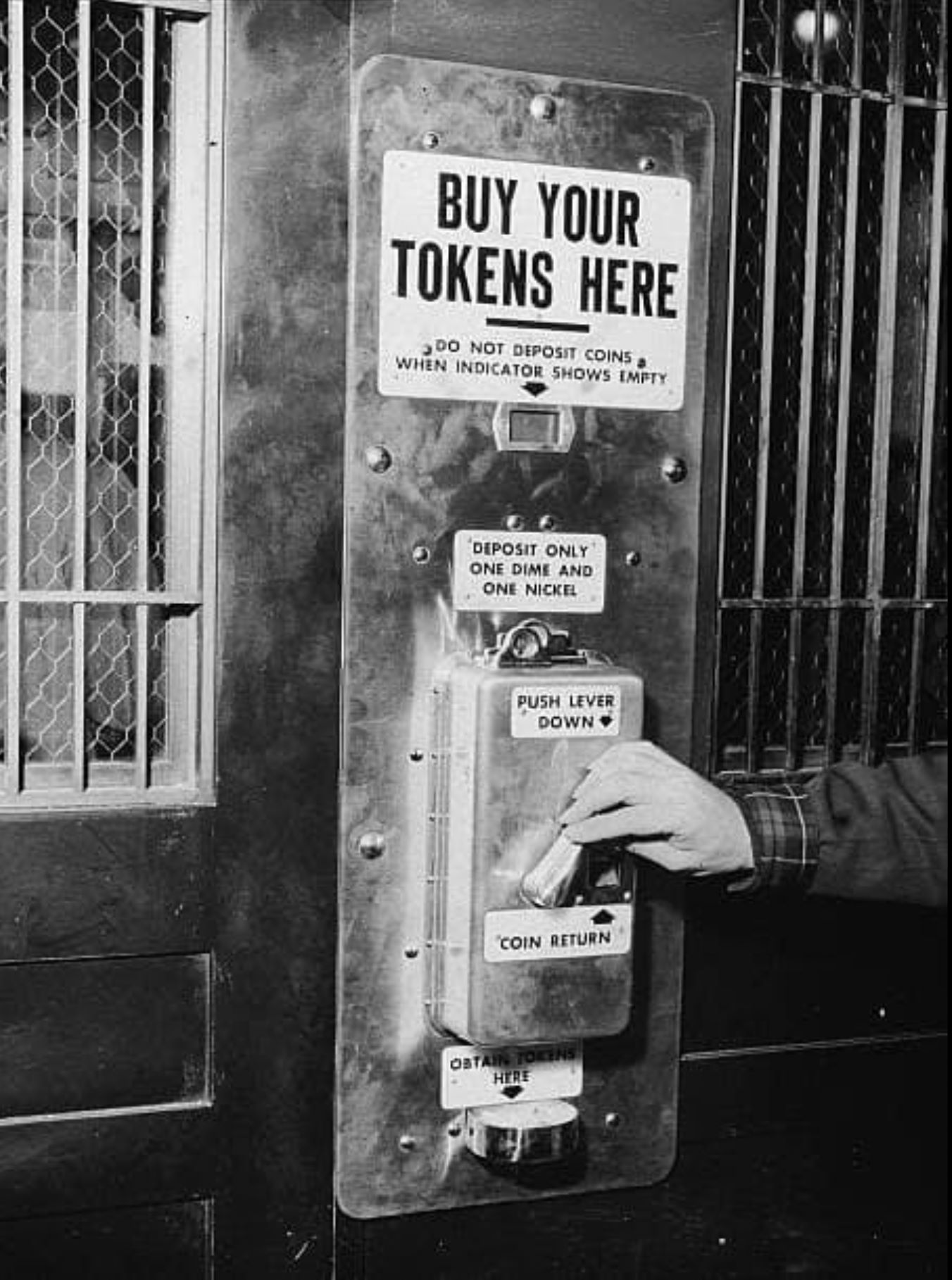 |
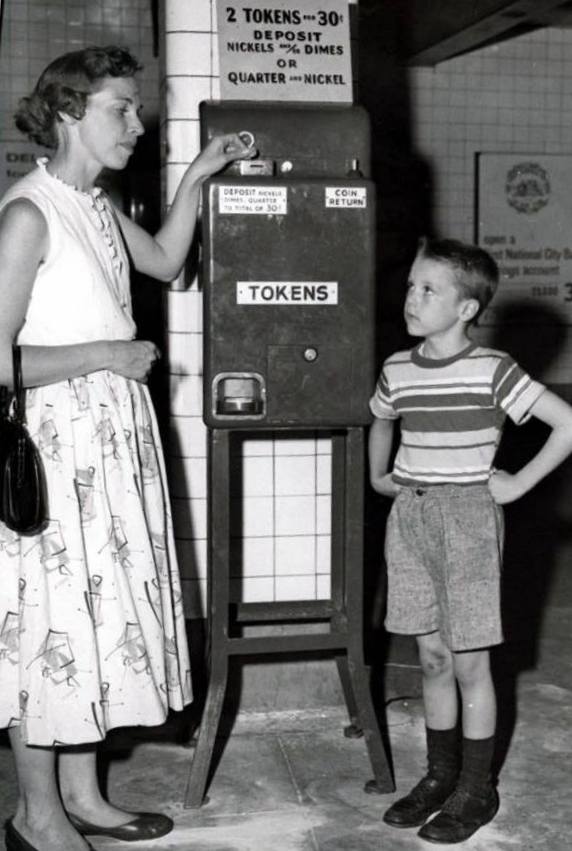 |
|
| booth or wall mount single token dispenser: 15 cents (dime and nickel only) |
self standing double token dispenser: 2 tokens for 30 cents (any combination of coins) |
|
|
all images above: courtesy of the New York City Transit Museum archives
|
||
| . . |
||
|
|
||
Token sales ended on April 13, 2003. Redemption of tokens at turnstiles ceased on rapid transit lines on May 3, 2003 and on surface lines December 31, 2003
| Overview | The Atwood-Coffee Catalog | |||
|
|
||||
| 19th Century Issues - 1827 to 1900 | ||||
|
|
||||
| 20th Century Issues - 1900 to 1940 | ||||
| Bronx | Brooklyn | Manhattan | Queens | Staten Island |
|
|
||||
| First Unification "NYCTS" - City Wide Issues - 1940-1953 | ||||
|
|
||||
| Second Unification "NYCTA" - City Wide Issues - 1953 - 2003 |
||||
| Why a token? Coins vs. Token | ||||
| July 25, 1953: Will the real first token please stand up.. | July 27, 1953 - Jay Street? We have a problem. | |||
| Not complete sets. And a REAL complete set | ||||
|
|
||||
| Token Dispensers | Rolls & "Ten Paks" | |||
|
|
||||
| Errors | Die Set Up | Patterns | Proofs | Counterfeits & Slugs |
|
|
||||
| Token Manufacturing Processes of NYCTA tokens | ||||
|
|
||||
| Scanning Electron
Microscope / Wavelength Dispersive Spectroscopy testing to determine
composition of the NYCTA 5 Borough - Pentagon Token |
||||
Rolls and Ten Packs - "Timesaver Paks"
Those people who used the subway and transit system for their daily commute, whether it be work or higher education; they would purchase their tokens in multiples of ten: Five days multiplied by two trips a day for those with one rid commute, or twenty tokens for those unfortunate souls who needed to take a subway and a bus; or three buses.
The NYCTA realized a significant amount of time could be
eliminated from these multiple token sales by offering pre-packaged
token "packs". Those people who bought multiple tokens, could now
purchase the pack, instead of the clerk having to count out 10 (or
more) individual tokens. This certainly cut down on the time required
at the token clerk window and sped up transaction time.
When this convenience actually started is not known, but the
first observed "packaging" for rolls of tokens is this one:
 |
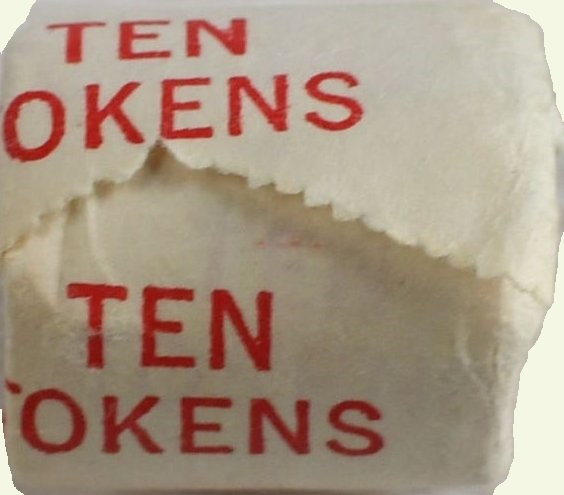 |
unmarked roll of ten tokens - not packaged by NYCTA as it does not bear an MTA or NYCTA logo. Rolls of tokens were sold by high end retailers like B.
Altman; as well as financial institutions like First National City Bank
and Manufacturers Hanover; as well as ten Long Island Rail Road
stations as a convenience to customers. Also possible, they were supplied to messenger or delivery service employees by their respective companies. 23mm, brass,
Y cutout January 4,
1970 - June 27, 1980 |
|
|
||
|
|
||
|
These next packages, were sold by the New York City Transit Authority.
The actual date of introduction for the first package is currently unknown. A one sentence byline in the New York Times mentions ten packs were released in 1983, but nothing more specific and there is no feature article to announce this. |
||
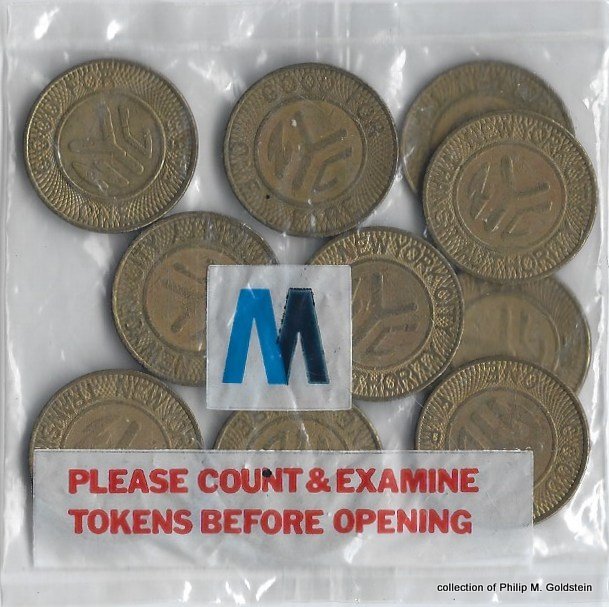 |
large two tone blue M logo and all upper case: PLEASE COUNT & EXAMINE TOKENS BEFORE OPENING 22mm, solid Atwood-Coffee NY630AT June 28, 1980 - July 2, 1981: 60¢ July 3, 1981 - January 1, 1984: 75¢ January 2, 1984 - December 31, 1985: 90¢ January 1, 1986 - December 31, 1989: $1.00 uncommon; $30.00 - $35.00 |
|
|
|
||
 |
large two tone blue M logo and all upper case: PLEASE COUNT & EXAMINE TOKENS BEFORE OPENING repurposed Aqueduct Racetrack Special tokens for Express Buses - sold at Sixth Ave and 57th Street station token booth as the Express buses rode across 57th Street. 28mm, brass, Y cutout Atwood-Coffee NY630AP January 1, 1986 - December 31, 1989 rare: $100.00 - $150.00 |
|
|
|
||
| large two tone blue M logo and all upper case: PLEASE COUNT & EXAMINE TOKENS BEFORE OPENING 22mm, brass, with 8mm steel center Atwood-Coffee NY630BE all with initials SJD January 1, 1986 - December 31, 1989 uncommon; $20.00 - $25.00 |
||
|
|
||
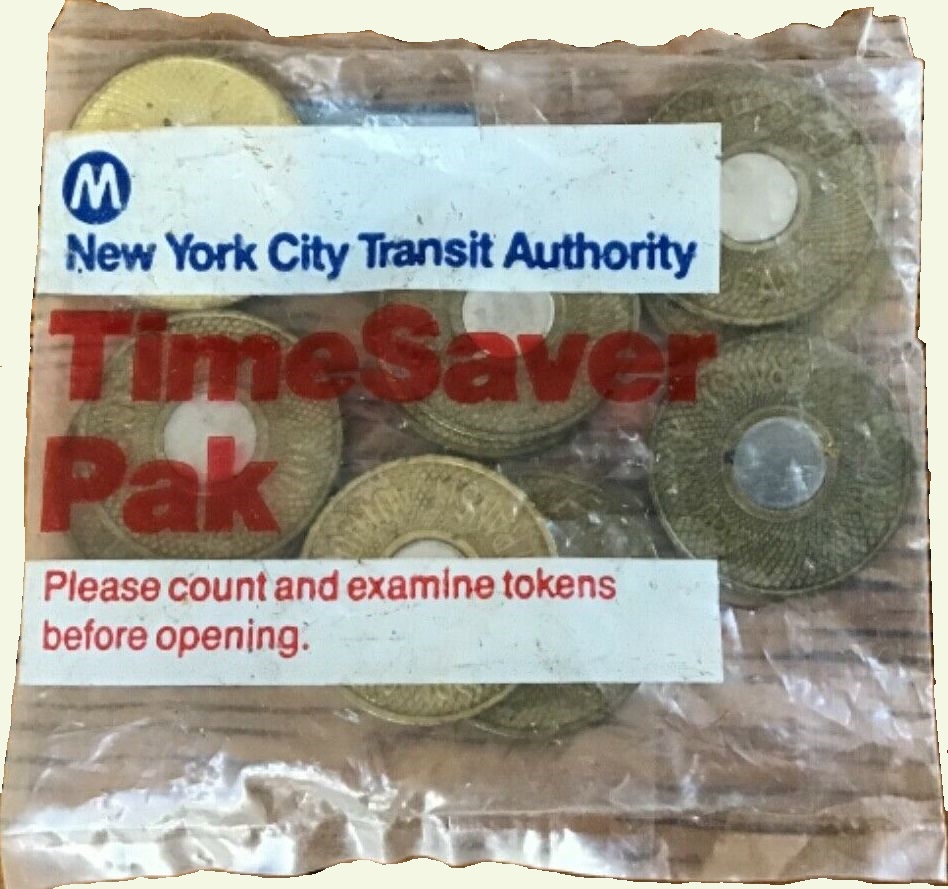 |
M logo in circle New York City Transit Authority unusual red ink "TimeSaver Pak" Please count and examine tokens before opening 22mm, brass, with 8mm steel center Atwood-Coffee NY630BE and NY630BI mixed January 1, 1986 - January 1, 1989 uncommon; $25.00 - $30.00 |
|
|
|
||
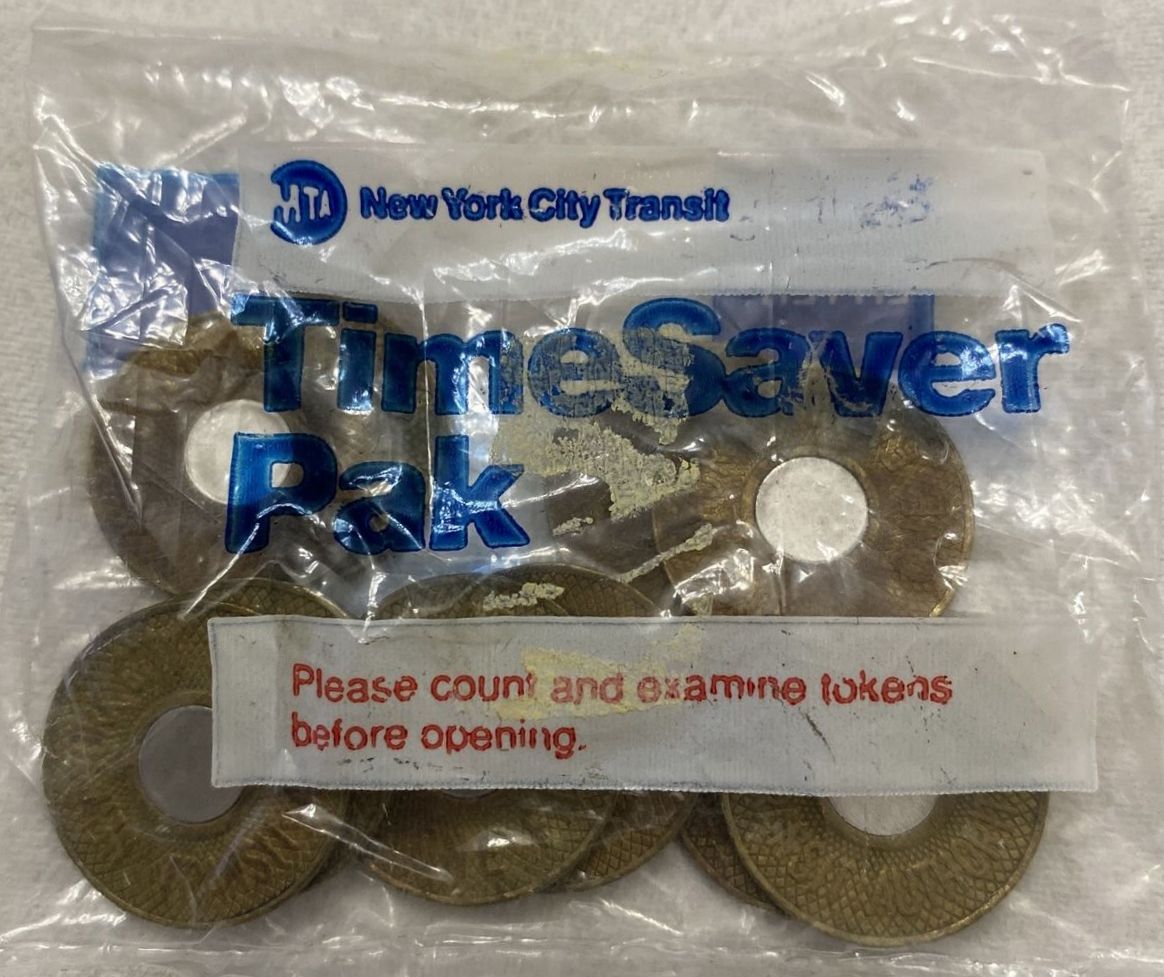 |
(use of this logo began in 1994) blue ink "TimeSaver Pak" Please count and examine tokens before opening. 22mm, brass, with 8mm steel center Atwood-Coffee NY630BE and NY630BI mixed January 1, 1992 - November 11, 1995 common; $15.00 - $20.00 |
|
|
|
||
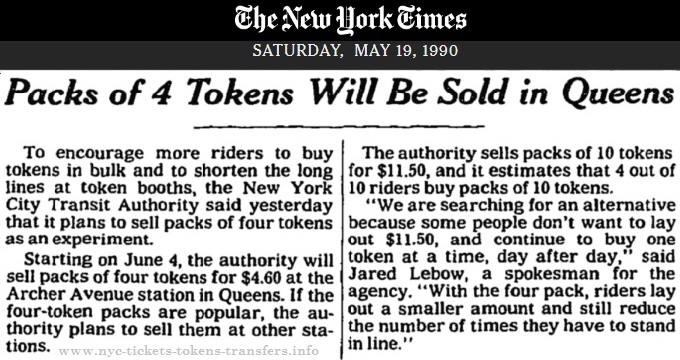 |
Located in the NY Times Digital Archives is reference to an experiment: 4 packs of tokens being sold at the Archer Avenue Station begining June 4, 1990. No accompanying image and no further reference to this experiment is mentioned in the archive; therefore it is not believed the public response to the "4 pack" was not enthusiastic enough to warrant continued sales. The article is shown at left. These experimental packs would have been comprised of "Bulls-eye Tokens" 22mm, brass, with 8mm steel center Atwood-Coffee NY630BE |
|
|
|
||
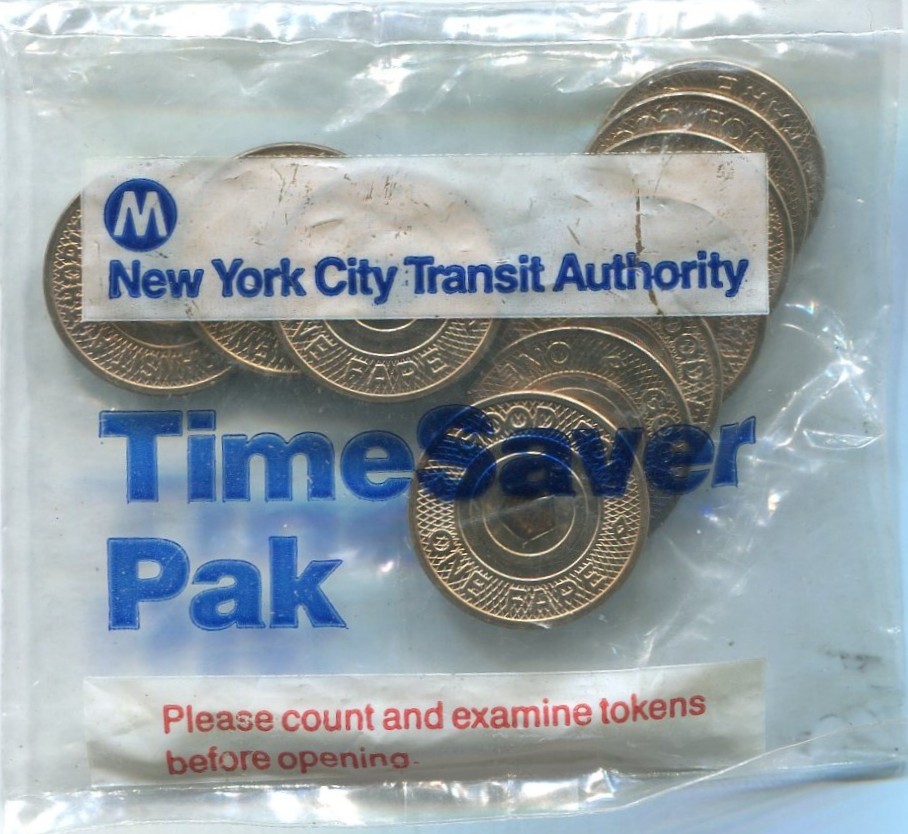 |
M logo in circle New York City Transit Authority blue ink "TimeSaver Pak" Note the use of old M logo (pre-1994), with the Pentagon Token (a 1995 issue), with full legend New York City Transit Authority and despite the above issue with the new November 12, 1995 - May 3, 2003 22mm, 88/11 cupro-nickel, with pentagon shape punch hole Atwood-Coffee NY630BJ common; $10.00 - $15.00 |
|
Token sales ended on April 13, 2003. Redemption of tokens at turnstiles ceased on rapid transit lines on May 3, 2003 and on surface lines December 31, 2003.
| Overview | The Atwood-Coffee Catalog | |||
|
|
||||
| 19th Century Issues - 1827 to 1900 | ||||
|
|
||||
| 20th Century Issues - 1900 to 1940 | ||||
| Bronx | Brooklyn | Manhattan | Queens | Staten Island |
|
|
||||
| First Unification "NYCTS" - City Wide Issues - 1940-1953 | ||||
|
|
||||
| Second Unification "NYCTA" - City Wide Issues - 1953 - 2003 |
||||
| Why a token? Coins vs. Token | ||||
| July 25, 1953: Will the real first token please stand up.. | July 27, 1953 - Jay Street? We have a problem. | |||
| Not complete sets. And a REAL complete set | ||||
|
|
||||
| Token Dispensers | Rolls & "Ten Paks" | |||
|
|
||||
| Errors | Die Set Up | Patterns | Proofs | Counterfeits & Slugs |
|
|
||||
| Token Manufacturing Processes of NYCTA tokens | ||||
|
|
||||
| Scanning Electron
Microscope / Wavelength Dispersive Spectroscopy testing to determine
composition of the NYCTA 5 Borough - Pentagon Token |
||||
![]()
Nothing attracts more attention than objects of "error" and they almost always capture the awe of even the non-collector. The "inverted Jenny" stamp block which never fails to amaze is evidence of this - even those who are not philatelists (stamp collectors) talk about it. US Coins and Currency have their fair share of error superstars as well; with common errors even being within reach of the novice collector.
So it is not surprising to know of errors existing in the realm of New York City transit tokens.
Now, with something as mass produced by high speed automated machinery, mistakes are bound to happen. Normally, quality control does a thorough job of inspecting batches of tokens, but every so often one escapes. Errors escape at the manufacturer who may have lax security.
The next point of observation would be the token clerk who would observe them at the distribution point or when they jam the counting machine or turnstile. It was a common practice for clerks to remove them and place them on a small visible shelf right above the distribution slot.
For the sake of explanation, these manufacturing errors below differ from the "New York City Transfer System" error (NY630KA) listed
in the First Unification chapter above, because that was a die
engraving error, which made it into limited production and was used
briefly.
|
|
Here is a very cool error. IRT token, one of the punch out punches broke, so only two punches complete and a slight impression of the third. 22mm, copper nickel very rare |
|
strike error; single mis-strike
22mm, solid extremely rare |
|
|
strike error; rotated punch out Most common of the errors. Seen in both 16.5mm (NY630AO) and 22mm (NY630AS) Y punch out types; and to varying degrees of rotation. uncommon, but seen for sale from time to time |
|
strike error; double mis-strike
22mm, solid extremely rare |
|
|
strike error, un-punched
16.5mm, brass, Y cutout caution must be exercised - at a quick glance, this token error could appear as the Atwood-Coffee NY630AN. extremely rare |
|
strike error; no strike / blank planchet
22mm, brass, with 8mm steel center extremely rare |
|
|
strike error; rotated punch out 23mm, brass,
Y cutout |
|
strike error; unpunched 28mm, brass, Y cutout Atwood-Coffee NY630AP extremely rare notice the vertical line between the N and C, this was used to align the Y-cut out properly. |
|
|
strike error, off center punch error extending through rim 23mm, brass,
Y cutout notice the small center hole, used in the Y cut out alignment process |
|
clipped planchet error
22mm, solid extremely rare |
| strike error - off alignment punch 23mm, brass, with diamond punch hole at top center Atwood-Coffee NY630AY uncommon |
|
|
|
| strike error - unpunched 23mm, brass, without diamond punch hole at top center Atwood-Coffee NY630AY rare |
|
|
|
|
|
|
double sided obverse die error
22mm, solid extremely rare |
|
|
|
|
doubled sided reverse die error
22mm, solid extremely rare |
|
As with other errors in numismatics; error tokens will garner the attention of error collectors outside of the New York Transit exonumia area as well. Heavy bidding can be expected in an auction venue.
.
| Overview | The Atwood-Coffee Catalog | |||
|
|
||||
| 19th Century Issues - 1827 to 1900 | ||||
|
|
||||
| 20th Century Issues - 1900 to 1940 | ||||
| Bronx | Brooklyn | Manhattan | Queens | Staten Island |
|
|
||||
| First Unification "NYCTS" - City Wide Issues - 1940-1953 | ||||
|
|
||||
| Second Unification "NYCTA" - City Wide Issues - 1953 - 2003 |
||||
| Why a token? Coins vs. Token | ||||
| July 25, 1953: Will the real first token please stand up.. | July 27, 1953 - Jay Street? We have a problem. | |||
| Not complete sets. And a REAL complete set | ||||
|
|
||||
| Token Dispensers | Rolls & "Ten Paks" | |||
|
|
||||
| Errors | Die Set Up | Patterns | Proofs | Counterfeits & Slugs |
|
|
||||
| Token Manufacturing Processes of NYCTA tokens | ||||
|
|
||||
| Scanning Electron
Microscope / Wavelength Dispersive Spectroscopy testing to determine
composition of the NYCTA 5 Borough - Pentagon Token |
||||
![]()
These next pieces, while it may appear to be an errors, are actuality Die Set Up pieces.
This was done to check the dies for adequate pressure and alignment. This can be determined by only one side bearing the token design, but note the rim on the opposite side is evident, but not the design. A blank rimmed die was in place instead of the die that carried the design.
|
|
|
die set up 23mm, brass, with unpunched diamond at top center obverse only impression Atwood-Coffee NY630AY unlisted in Atwood-Coffee extremely rare |
|
|
|
die set up 23mm, brass, with punched diamond at top center (holder marked "Roger Williams Sample") obverse only impression Atwood-Coffee NY630AY unlisted in Atwood-Coffee extremely rare |
| Overview | The Atwood-Coffee Catalog | |||
|
|
||||
| 19th Century Issues - 1827 to 1900 | ||||
|
|
||||
| 20th Century Issues - 1900 to 1940 | ||||
| Bronx | Brooklyn | Manhattan | Queens | Staten Island |
|
|
||||
| First Unification "NYCTS" - City Wide Issues - 1940-1953 | ||||
|
|
||||
| Second Unification "NYCTA" - City Wide Issues - 1953 - 2003 |
||||
| Why a token? Coins vs. Token | ||||
| July 25, 1953: Will the real first token please stand up.. | July 27, 1953 - Jay Street? We have a problem. | |||
| Not complete sets. And a REAL complete set | ||||
|
|
||||
| Token Dispensers | Rolls & "Ten Paks" | |||
|
|
||||
| Errors | Die Set Up | Patterns | Proofs | Counterfeits & Slugs |
|
|
||||
| Token Manufacturing Processes of NYCTA tokens | ||||
|
|
||||
| Scanning Electron
Microscope / Wavelength Dispersive Spectroscopy testing to determine
composition of the NYCTA 5 Borough - Pentagon Token |
||||
.
![]()
A pattern coin or token is an example of said coin or token that has not been approved for release, but has been produced to evaluate a proposed coin or token design. They are often made with "off-metals" (metals of lower value such as aluminum or bronze, which is cheaper than brass or copper) to test the dies.
Often several dozen pieces are usually struck, then sent to the board of directors of the company or municiapal agency, or the government office that ordered the coin / token; for review and commenting. These pieces can be considered "proposals."
A said pattern may be approved by the company or government mint ordering it, thereby allowing it to continue into mass production; or, it may go back for revisions to the design resulting in another group of patterns; or may be rejected completely.
Many pattern coins and tokens are often held by the manufacturer as a reference piece; and rarely see public or collectible trading; such as those for government minting.. Others do make it into the collectors markets.
|
|
|
1974 pattern
In anticipation of awarding a contract to the Osborne Coinage for what would be the 22mm brass NY630AT;
a very limited quantity of this token was struck in bronze for testing and quality purposes. 22mm, bronze, solid unlisted in Atwood-Coffee extremely rare |
| Overview | The Atwood-Coffee Catalog | |||
|
|
||||
| 19th Century Issues - 1827 to 1900 | ||||
|
|
||||
| 20th Century Issues - 1900 to 1940 | ||||
| Bronx | Brooklyn | Manhattan | Queens | Staten Island |
|
|
||||
| First Unification "NYCTS" - City Wide Issues - 1940-1953 | ||||
|
|
||||
| Second Unification "NYCTA" - City Wide Issues - 1953 - 2003 |
||||
| Why a token? Coins vs. Token | ||||
| July 25, 1953: Will the real first token please stand up.. | July 27, 1953 - Jay Street? We have a problem. | |||
| Not complete sets. And a REAL complete set | ||||
|
|
||||
| Token Dispensers | Rolls & "Ten Paks" | |||
|
|
||||
| Errors | Die Set Up | Patterns | Proofs | Counterfeits & Slugs |
|
|
||||
| Token Manufacturing Processes of NYCTA tokens | ||||
|
|
||||
| Scanning Electron
Microscope / Wavelength Dispersive Spectroscopy testing to determine
composition of the NYCTA 5 Borough - Pentagon Token |
||||
![]()
Proof coins and tokens are manufactured for the collectibles market, and not intended to circulate like regular production issues are.
Proof coinage refers to special examples of a coin or token issue. Historically, they were made for checking the dies, engraving, design and for archivalpurposes. Modern proof coins are struck in greater quantities, with the intent for retail sale to coin collectors (numismatists).
Proof coins and tokens are prepared by polishing the dies, of which may have sharper design details, rims and polished fields (the unengraved blank areas). The metal stock material that the blanks are manufactured from, may have underwent preliminary polishing. Blanks are usuallypolished, and sometimes struck entirely of precious metals such as silver, gold, platinum, palladium. Blanks are struck at slow speeds, and several times at higher pressures (where as prduction coins and tokens are struck one at high speed at moderate pressure.)
The NYCTA had struck a very very limited supply (supposedly 25 pairs) of 16.5 and 23mm tokens, struck from new proof dies. These tokens are not to be confused with regular tokens which were polished, gold-plated and sold as cuff-links or tie-tacks.
This brass proof 75th Diamond Jubilee token was struck by the Roger Williams Mint using a specially prepared polished die pair. The results are coins or tokens that are exceptionally mirrorlike, and proofs are rarer than uncirculated coins. Uncirculated coins or tokens, on the other hand, are created in larger quantities and may have blemishes.
These proofs were sold at the NYCTA Revenue Department cash window at 370 Jay Street in very limited quantities in 1979 to 1980 or so. 5,000 struck.
They came in unmarked but heat sealed plastic
pouches for basic protection from dings.
The 14 karat Gold Proof 75th Diamond Jubilee token was marketed by the Fifth Avenue
Jewelry firm of H. Stern. These were also struck from proof dies. Mintage of 500, edge numbered.
|
|
|
75th Anniversary / Diamond Jubilee Brass Proof Sold from the Revenue window at 370 Jay Street. Produced from polished dies of NY630AY. 23mm, brass, with diamond punch hole at top center unlisted in Atwood-Coffee rare; 5,000 struck |
|
|
||
|
|
|
75th Anniversary / Diamond Jubilee Token Gold Proof 23mm, 14 karat gold, with diamond punch hole at top center individually numbered with H. Stern engraved on edge at top of token A special NYC theme bezel available for an additional fee. Atwood-Coffee NY630AM Presentation Piece rare, only 250 struck |
| Overview | The Atwood-Coffee Catalog | |||
|
|
||||
| 19th Century Issues - 1827 to 1900 | ||||
|
|
||||
| 20th Century Issues - 1900 to 1940 | ||||
| Bronx | Brooklyn | Manhattan | Queens | Staten Island |
|
|
||||
| First Unification "NYCTS" - City Wide Issues - 1940-1953 | ||||
|
|
||||
| Second Unification "NYCTA" - City Wide Issues - 1953 - 2003 |
||||
| Why a token? Coins vs. Token | ||||
| July 25, 1953: Will the real first token please stand up.. | July 27, 1953 - Jay Street? We have a problem. | |||
| Not complete sets. And a REAL complete set | ||||
|
|
||||
| Token Dispensers | Rolls & "Ten Paks" | |||
|
|
||||
| Errors | Die Set Up | Patterns | Proofs | Counterfeits & Slugs |
|
|
||||
| Token Manufacturing Processes of NYCTA tokens | ||||
|
|
||||
| Scanning Electron
Microscope / Wavelength Dispersive Spectroscopy testing to determine
composition of the NYCTA 5 Borough - Pentagon Token |
||||
![]()
.
I, (PMG) on the other hand prefer to differentiate
counterfeits from a slugs. To some numismatists; a counterfeit issue is
a part of the collecting field and some counterfeits of antiquity (i.e.
Roman and Grecian coins) even become valuable themselves. Therefore, to
me (PMG):
In regards to their use, if there was a way to save on paying the full fare price, one can be sure that there are less than honest people willing to make a counterfeit token. And easier way was to use available selected world coins or tokens from other cities; which would activate the turnstile.
But throughout token history, there have always been nefarious people with the wherewithal to manufacture counterfeits. In doing so, there were only three considerations:
In most cases, these counterfeits ans slugs were mass produced to some degree. Whether it be a few hundred or a few thousand, the financial reward was in having enough to sell to make money. I can probably make a slug in my garage out of a brass tag. I have the material from previous projects, punches, micrometer, files etc. But would it be worth the effort and the material to make one or two or ten? Not in the least.
Mass production was how the "ill gotten gains" were made. Most of the newspaper articles I have encountered regarding counterfeit tokens; one or more of the principals was involved with or owns either a machine shop or automotive repair shop. Once a design was proven to work, an organized counterfeit manuafacturer sold them in bulk quantities to a secondary distributor - usually a "bodega" or a small local grocery store. This distributor would also add their mark up to the unit price, and sell the counterfeits, at say 25% to 50%; of and actual token cost for a package of 50 or 100. But in some cases the manufacturer did the distribution on their own.
Something to be kept in mind about counterfeits, no matter how crude or well executed they were, they really only have to work. Some of the tokens were so crude and poorly made they were easily identified and separated from authentic tokens by the booth attendant and prevented from recirculation, in conjunction with the daily operations of the token booth.
All that mattered to the end user and the manufacturer, was that the slug or counterfeit activated the turnstile.
So, for the sake of thoroughness, the following are examples of NYCTA token counterfeits and slugs.
| Counterfeits | Slugs | |||||
| "Large Solid" NY630AT This token is drastically lighter than an authentic brass token. It appears to be cast in either zinc or aluminum |
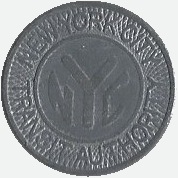 |
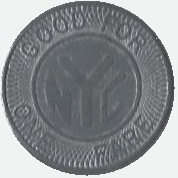 |
. | |||
| "Large Y Cutout" NY630AS Lead with light brass plating. |
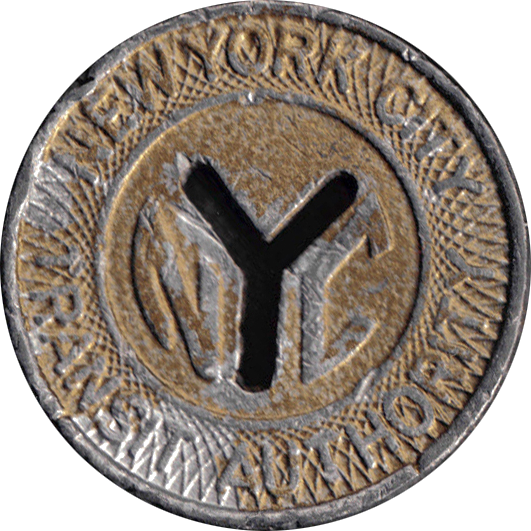 |
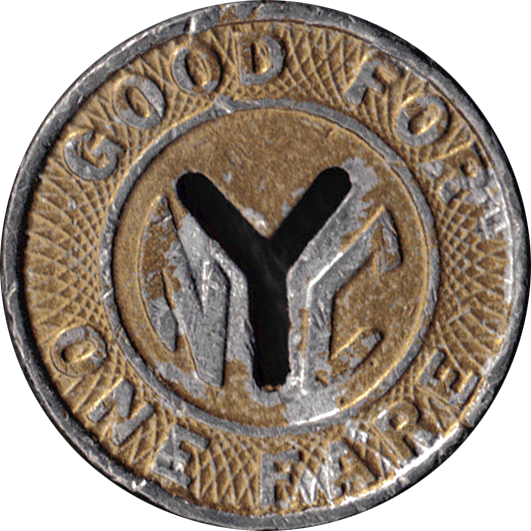 |
||||
| "Bullseye" NY630BI Brass with white metal core |
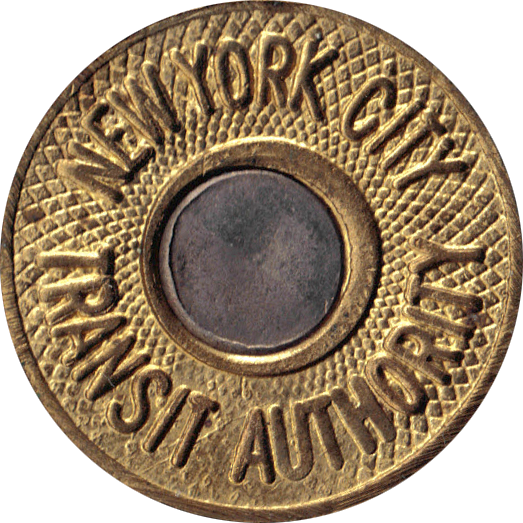 |
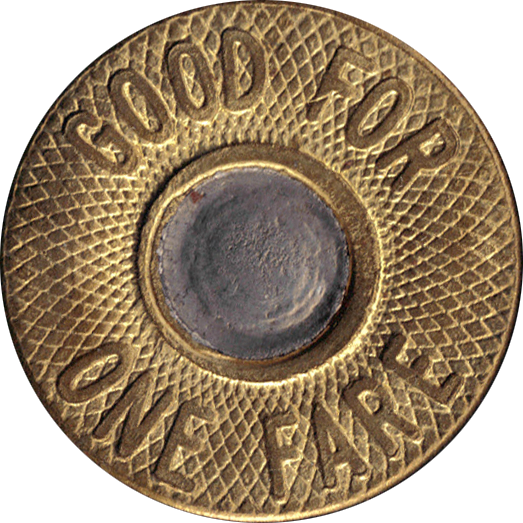 |
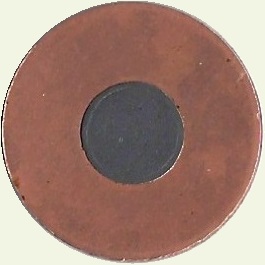 |
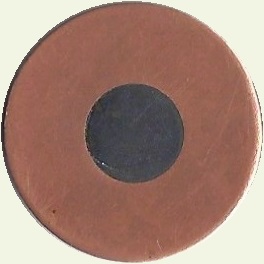 |
"Bullseye" NY630BE, BI or BG
copper with steel core |
|
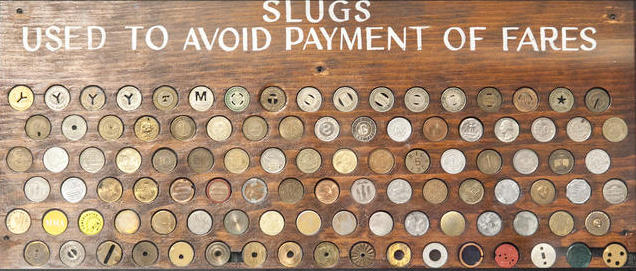
on display at and courtesy of the New York City Transit Museum
| Overview | The Atwood-Coffee Catalog | |||
|
|
||||
| 19th Century Issues - 1827 to 1900 | ||||
|
|
||||
| 20th Century Issues - 1900 to 1940 | ||||
| Bronx | Brooklyn | Manhattan | Queens | Staten Island |
|
|
||||
| First Unification "NYCTS" - City Wide Issues - 1940-1953 | ||||
|
|
||||
| Second Unification "NYCTA" - City Wide Issues - 1953 - 2003 |
||||
| Why a token? Coins vs. Token | ||||
| July 25, 1953: Will the real first token please stand up.. | July 27, 1953 - Jay Street? We have a problem. | |||
| Not complete sets. And a REAL complete set | ||||
|
|
||||
| Token Dispensers | Rolls & "Ten Paks" | |||
|
|
||||
| Errors | Die Set Up | Patterns | Proofs | Counterfeits & Slugs |
|
|
||||
| Token Manufacturing Processes of NYCTA tokens | ||||
|
|
||||
| Scanning Electron
Microscope / Wavelength Dispersive Spectroscopy testing to determine
composition of the NYCTA 5 Borough - Pentagon Token |
||||
![]()
| Metal Manufacturing | |
| Smelting: | The
base metal is manufactured by the mill, where the appropriate
metals are melted together. This could be all brass (copper and zinc)
for most NYCTA tokens,
a bronze (copper & tin); or a magnetically attractive metal such as
cupro-nickel for magnetic discrimination like the Five Borough Token,
or white metal (mostly nickel) as used for the small Special Fare
token. Other metals were used by other transit companies in New York City. Scrap from the manufacturing process is reused here. |
| Hot Rolling: | This liquid metal is then poured and formed into rolls. |
| Cold Rolling: | After cooling the rolls of metal are sent through pressure rollers to squeeze the metal to specified thickness. |
| Plate Cutting: |
(for some token manufacturers) Unrolled material now cut into plates for blanking. |
the Token Manufacturing Process: |
|||||
| "small Solid Y"* "large Solid Y" "Silver Special Fare" |
"small Y Cutout"* "large Y Cutout" "XL Special Fare Y Cutout" "Diamond Jubilee" |
"Bullseye" | "Five Boro" | ||
| Blanking: | The punching out of blank planchets (blank coins) takes place directly from the coils of metal. | yes | yes | yes | yes |
| Rimming: | The blanks go through a machine that adds a rim to the edge. | yes | yes | yes | yes |
| Burnishing: | Burnishing takes place in large vibratory machines that hold media designed to clean, polish and de-burr sharp edges from the blanks. Tumbling media can be corn cob to steel ball bearings; depending on the size and material to be cleaned and polished. | yes | yes | yes | yes |
| Plug Punching: | In the case of the "Bullseye" tokens, the center of the planchets are punched out. | no | no | yes | no |
| Plug Inserting: | The
metal insert "plug" is pressed into place. This could be a
magnetically attractive plug as in the case of the "Bullseye" tokens, (but can also be a non-magnetic brass plug in a non-magnetic white metal token as in the case of the Garden State Parkway tokens. In either case, it served both as a coin discriminatory method and an anti-counterfeiting measure.) |
no | no | yes | no |
| Coining: (a/k/a "striking") |
The planchets now enter the die press where the impression of the front (obverse) and back (reverse) designs takes place. Roger Williams Mint / Osborne Coinage edges and strikes in same process. |
yes | yes | yes | yes |
| Aligning for Punching: | In tokens that require a punch out design, like the small and large "Y
cutout" tokens or the "Diamond Jubilee"; and when specified by contract, the token is aligned to the punch. Some token designs did not need to be aligned before second punching like in the case of the "5 Borough token", which was both symmetrical and in the center. |
no | yes | no | no |
| Punching: | The second punch process like in the case of the 75th Diamond Jubliee token, is accomplished. | no | yes | no | yes |
| 4 steps | 6 steps | 6 steps | 5 steps | ||
Post-production: |
|||||
| Inspection: | Osborne Coinage inspection is performed manually throughout the various processes outlined above. | ||||
| Counting and Bagging: | Finished and inspected tokens now dumped into a counting machine and bagged, sealed and ready for shipment to the customer. | ||||
* = production shared with Meyer & Wenthe and Scoville Manufacturing. The manufacturing process can be viewed here for basic token designs: Factory Tour: Osborne Coinage - Part 1 (coils of metal, blanking, rimming & burnishing, coining; including presentation medallion manufacture, packaging, shipping). |
|||||
| Overview | The Atwood-Coffee Catalog | |||
|
|
||||
| 19th Century Issues - 1827 to 1900 | ||||
|
|
||||
| 20th Century Issues - 1900 to 1940 | ||||
| Bronx | Brooklyn | Manhattan | Queens | Staten Island |
|
|
||||
| First Unification "NYCTS" - City Wide Issues - 1940-1953 | ||||
|
|
||||
| Second Unification "NYCTA" - City Wide Issues - 1953 - 2003 |
||||
| Why a token? Coins vs. Token | ||||
| July 25, 1953: Will the real first token please stand up.. | July 27, 1953 - Jay Street? We have a problem. | |||
| Not complete sets. And a REAL complete set | ||||
|
|
||||
| Token Dispensers | Rolls & "Ten Paks" | |||
|
|
||||
| Errors | Die Set Up | Patterns | Proofs | Counterfeits & Slugs |
|
|
||||
| Token Manufacturing Processes of NYCTA tokens | ||||
|
|
||||
| Scanning Electron
Microscope / Wavelength Dispersive Spectroscopy testing to determine
composition of the NYCTA 5 Borough - Pentagon Token |
||||
That’s it. Cupro-nickel. Heavy on the copper for that rose tone. Nickel as ferromagnetic properties. I'm a little disappointed the NYCTA didn’t opt for something exotic like that Alloy 725, but truth be told; the results are far from unexpected. Simple and cheap. When I got home, I looked up that particular composition.
And there you have it, nothing earth shattering, a little anti-climactic, but I got my answer. Equipment: Tescan Vega; 4th Generation FIB SEM: Focused Ion Beam Scanning Electron Microscope EDS = Energy-Dispersive Spectroscopy WDS = Wavelength-dispersive Spectroscopy |
Click on the collage below to view images of the testing: |
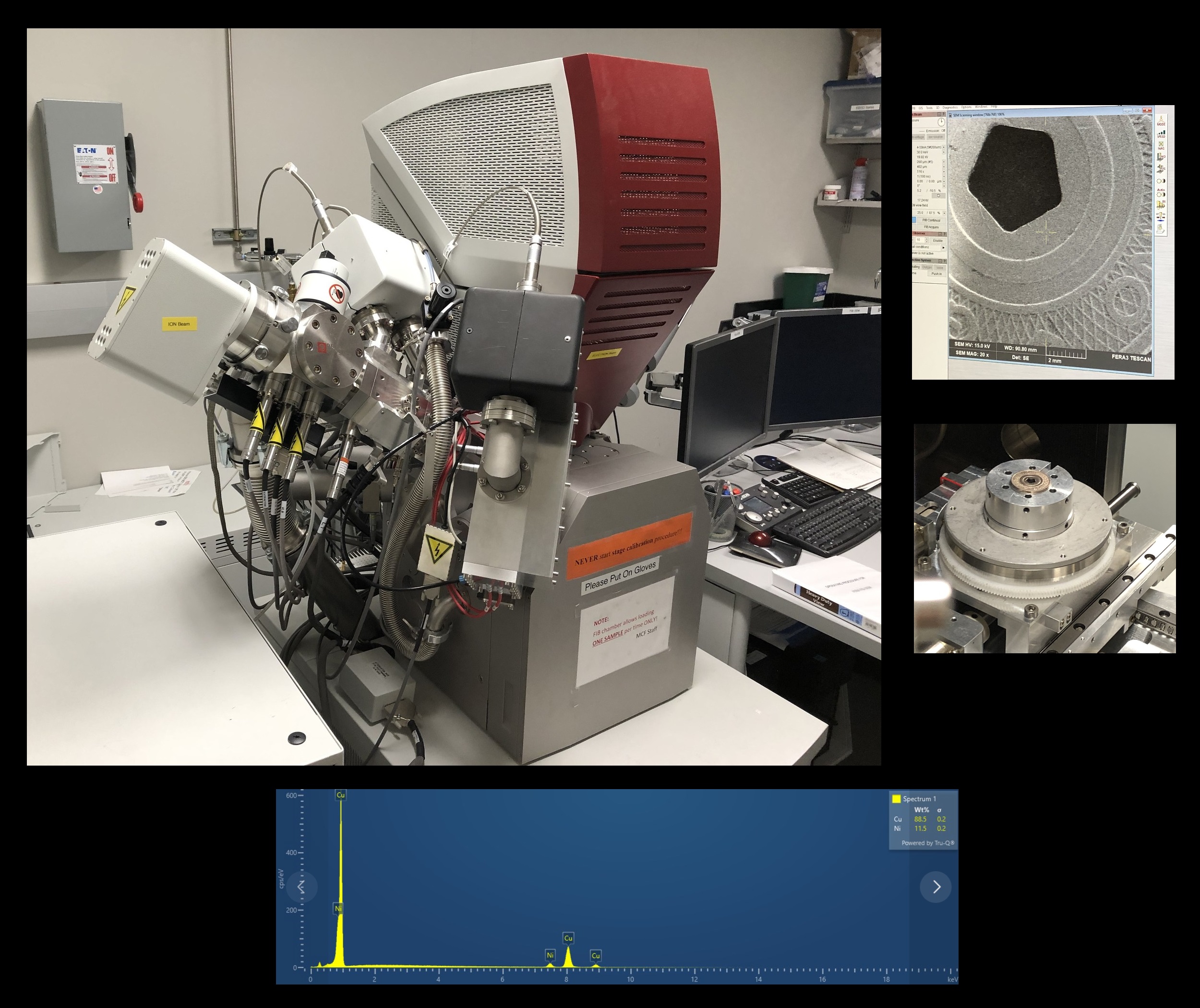 |
| Overview | The Atwood-Coffee Catalog | |||
|
|
||||
| 19th Century Issues - 1827 to 1900 | ||||
|
|
||||
| 20th Century Issues - 1900 to 1940 | ||||
| Bronx | Brooklyn | Manhattan | Queens | Staten Island |
|
|
||||
| First Unification "NYCTS" - City Wide Issues - 1940-1953 | ||||
|
|
||||
| Second Unification "NYCTA" - City Wide Issues - 1953 - 2003 |
||||
| Why a token? Coins vs. Token | ||||
| July 25, 1953: Will the real first token please stand up.. | July 27, 1953 - Jay Street? We have a problem. | |||
| Not complete sets. And a REAL complete set | ||||
|
|
||||
| Token Dispensers | Rolls & "Ten Paks" | |||
|
|
||||
| Errors | Die Set Up | Patterns | Proofs | Counterfeits & Slugs |
|
|
||||
| Token Manufacturing Processes of NYCTA tokens | ||||
|
|
||||
| Scanning Electron
Microscope / Wavelength Dispersive Spectroscopy testing to determine
composition of the NYCTA 5 Borough - Pentagon Token |
||||
| Canvas Coin and Token Bags |
|||
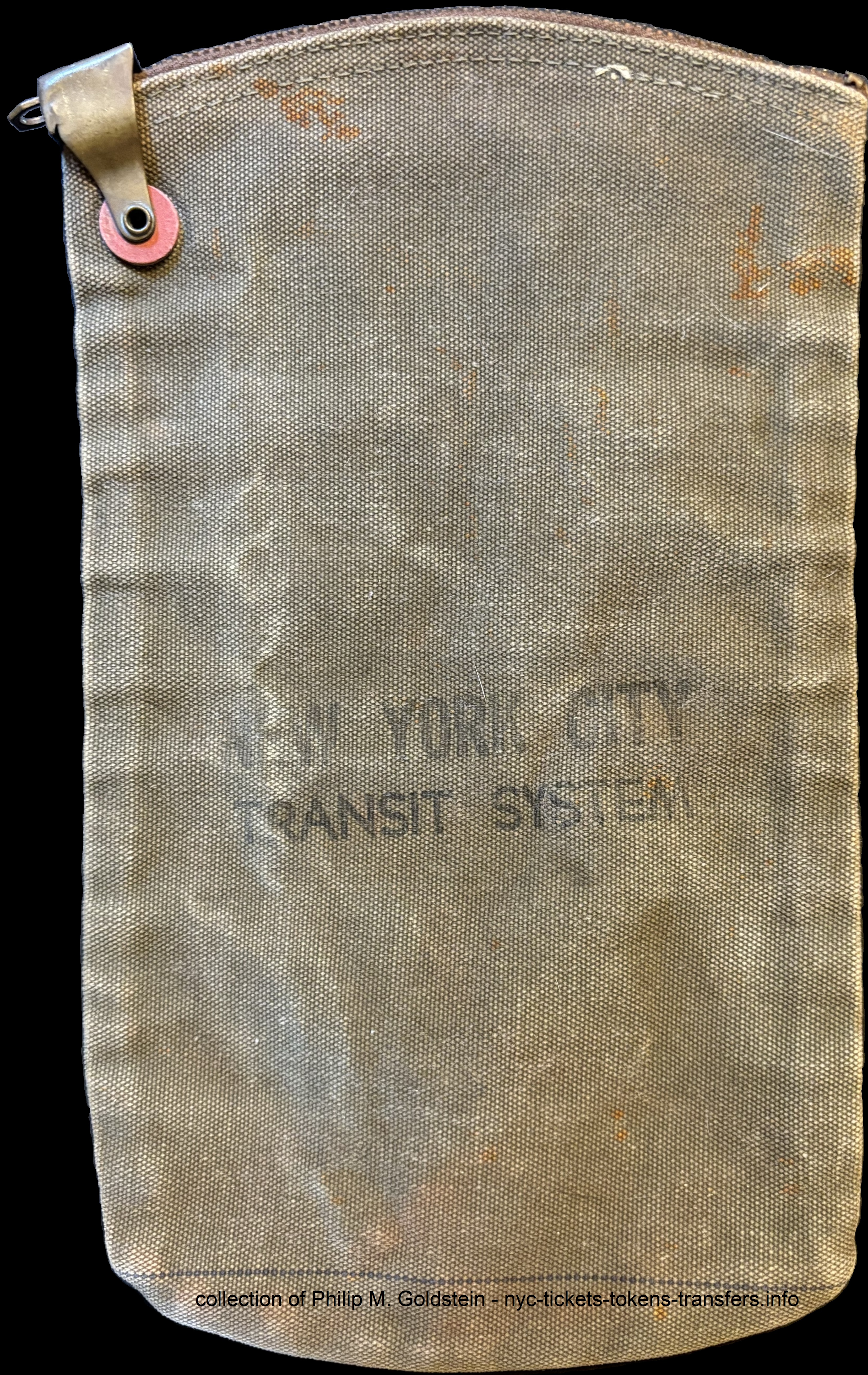 |
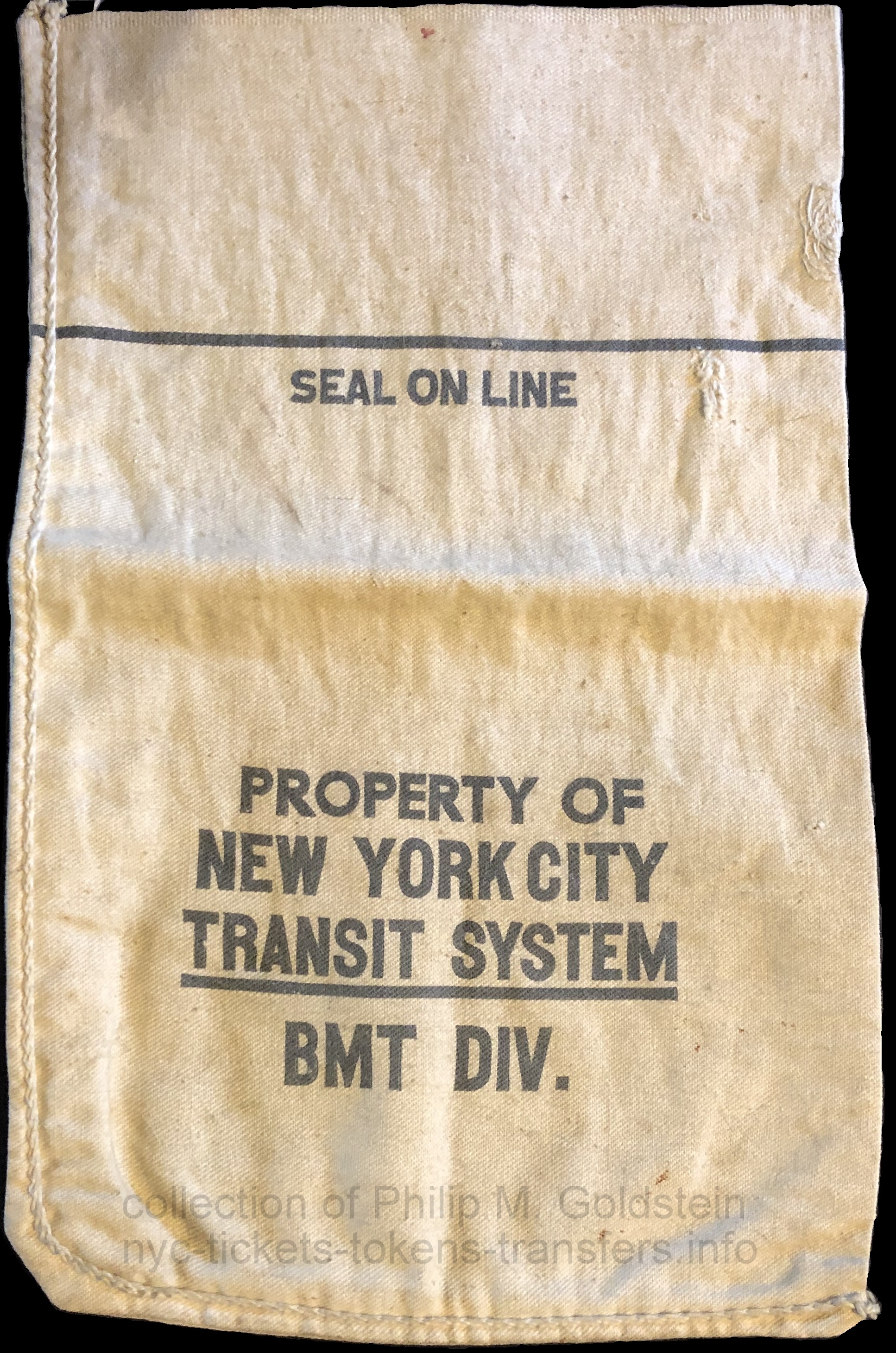 |
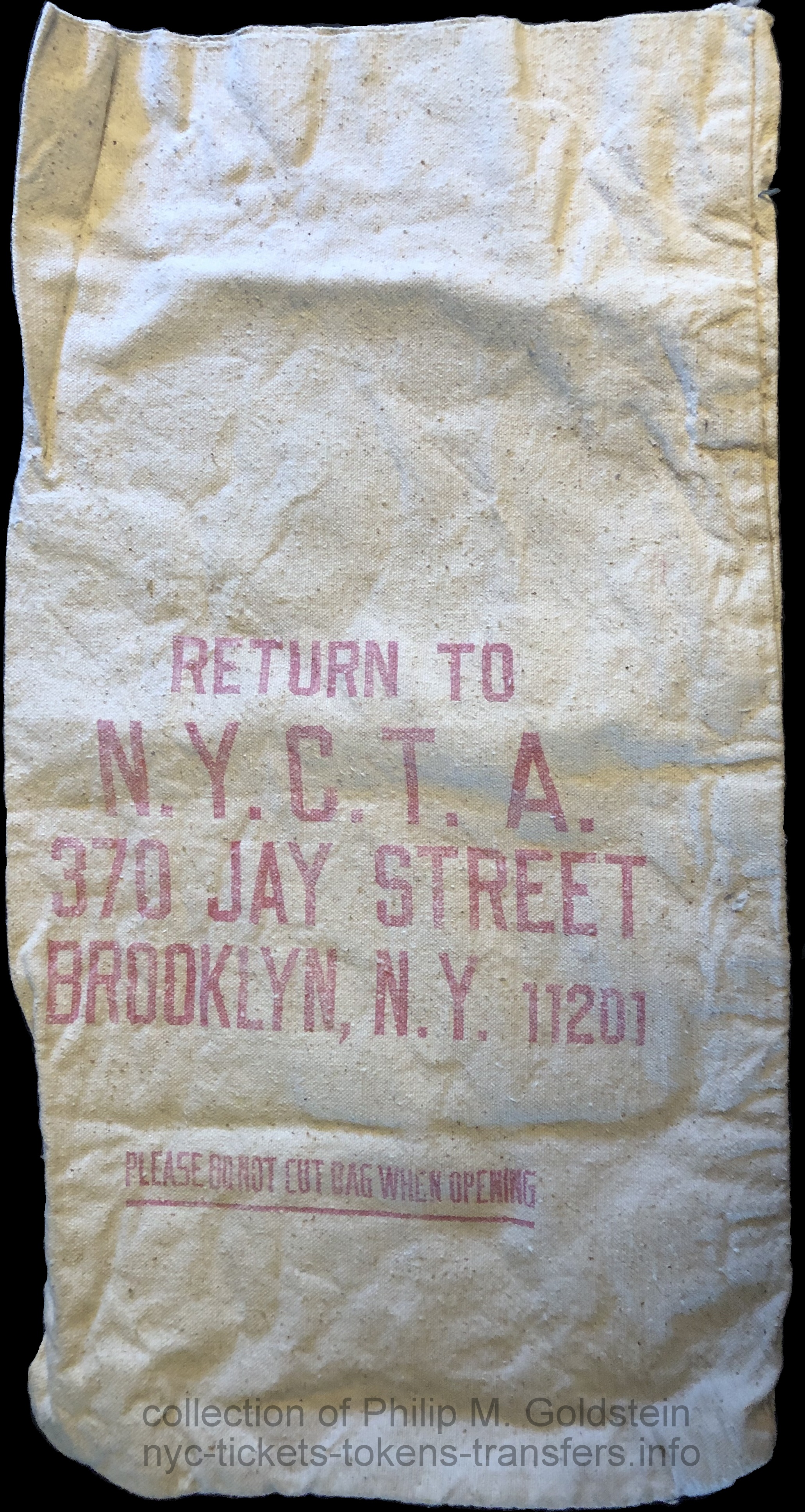 |
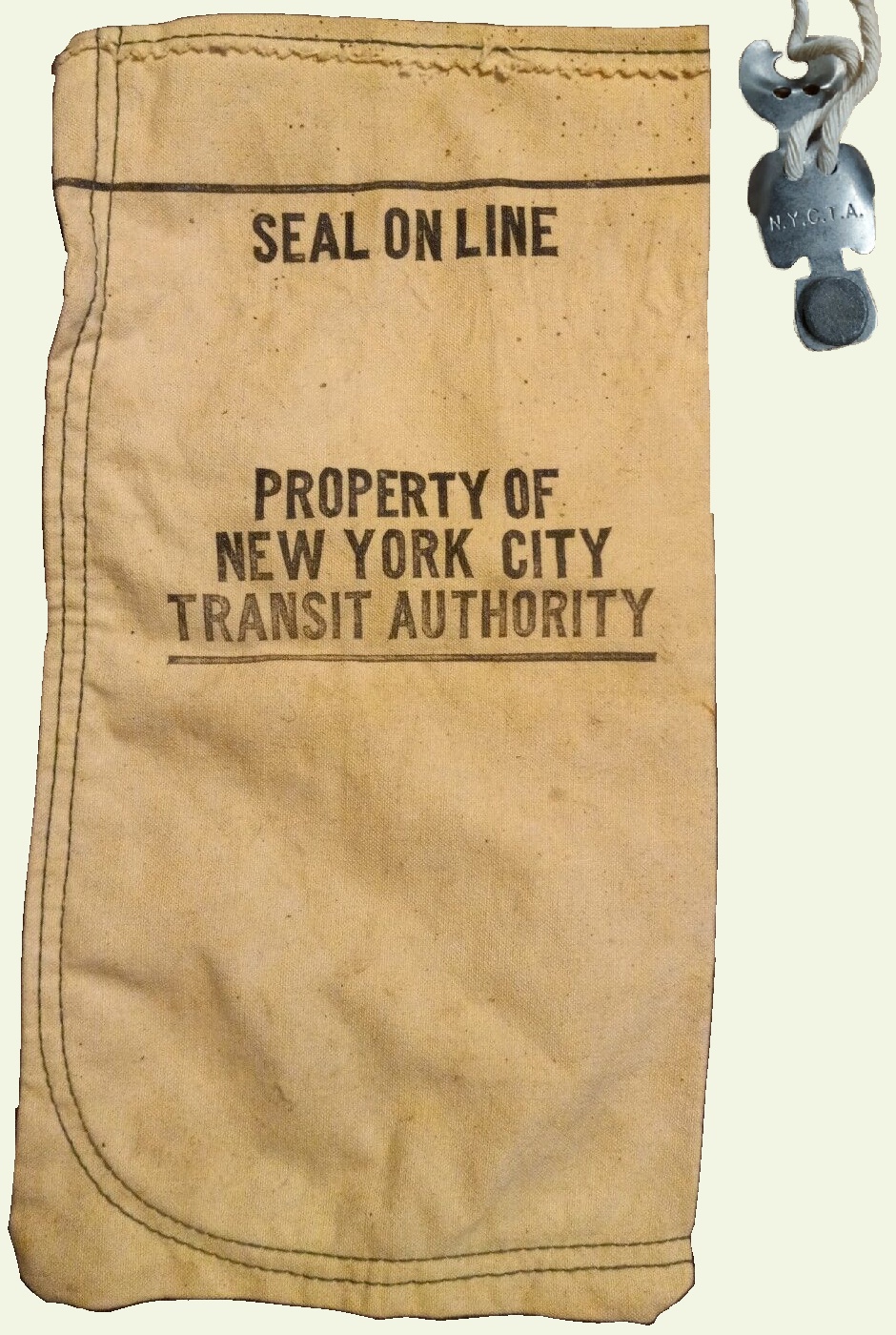 |
| NEW YORK CITY TRANSIT SYSTEM locking brass zipper loop internal stitching 11¼" x 6⅜" |
_____________________ SEAL ON LINE PROPERTY OF NEW YORK CITY TRANSIT SYSTEM BMT DIV. external stitching - 1940-1948 12" x 7½" |
RETURN TO N. Y. C. T. A. 370 JAY STREET BROOKLYN, N. Y. 11201 PLEASE DO NOT CUT BAG WHEN OPENING internal stitching - post 1963 (5 digit zip code) 19" x 10½" |
_______________________ SEAL ON LINE PROPERTY OF NEW YORK CITY TRANSIT AUTHORITY external stitching - ca. 1980's? size unknown |
| Token Bag Tags | |
 |
blank back |
| NEW YORK CITY TRANSIT AUTHORITY __________TOKENS TAA-G509-1,000,000-JUNE '53 (PA.) 1953 2 1/8" x 4 1/4" |
|
| . . |
|
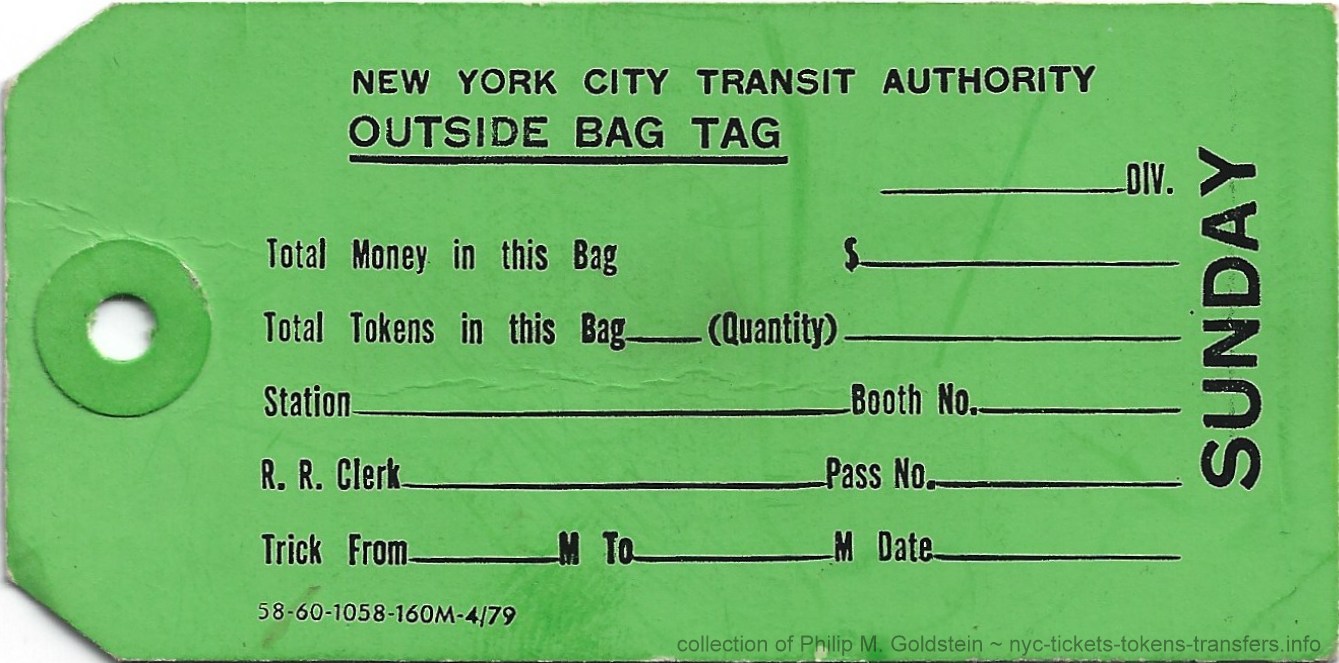 |
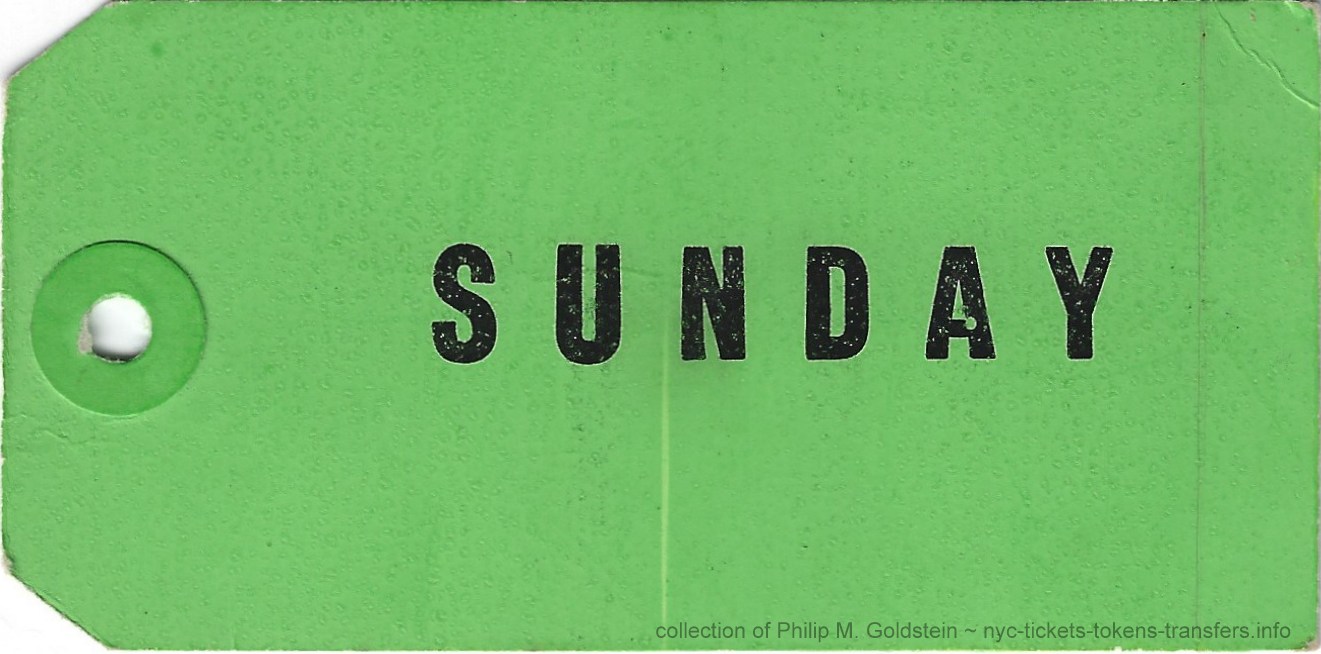 |
| NEW YORK CITY TRANSIT AUTHORITY OUTSIDE BAG TAG - SUNDAY 58-60-1058-160M-4/79 1979 2 1/8" x 4 1/4" |
|
| Overview | The Atwood-Coffee Catalog | |||
|
|
||||
| 19th Century Issues - 1827 to 1900 | ||||
|
|
||||
| 20th Century Issues - 1900 to 1940 | ||||
| Bronx | Brooklyn | Manhattan | Queens | Staten Island |
|
|
||||
| First Unification "NYCTS" - City Wide Issues - 1940-1953 | ||||
|
|
||||
| Second Unification "NYCTA" - City Wide Issues - 1953 - 2003 |
||||
| Why a token? Coins vs. Token | ||||
| July 25, 1953: Will the real first token please stand up.. | July 27, 1953 - Jay Street? We have a problem. | |||
| Not complete sets. And a REAL complete set | ||||
|
|
||||
| Token Dispensers | Rolls & "Ten Paks" | |||
|
|
||||
| Errors | Die Set Up | Patterns | Proofs | Counterfeits & Slugs |
|
|
||||
| Token Manufacturing Processes of NYCTA tokens | ||||
|
|
||||
| Scanning Electron
Microscope / Wavelength Dispersive Spectroscopy testing to determine
composition of the NYCTA 5 Borough - Pentagon Token |
||||
|
||||||||||